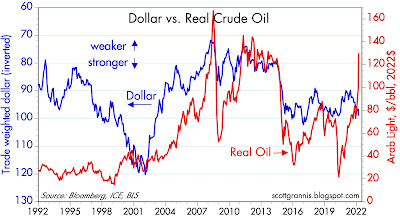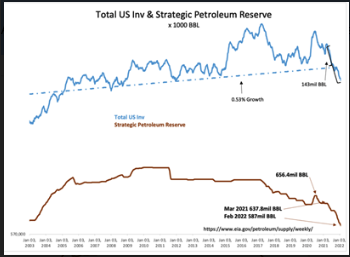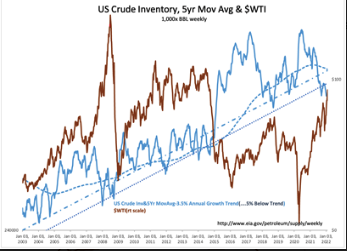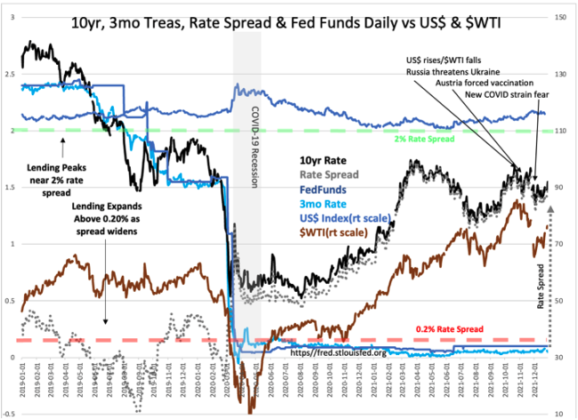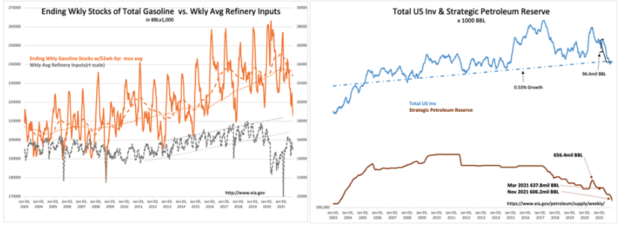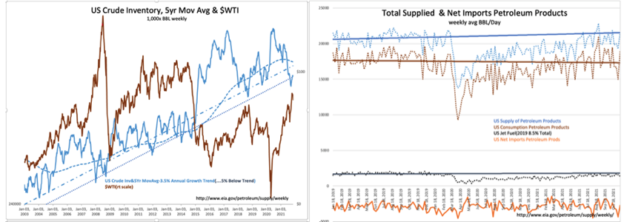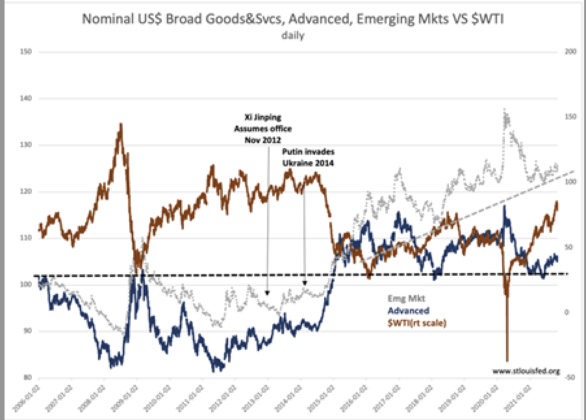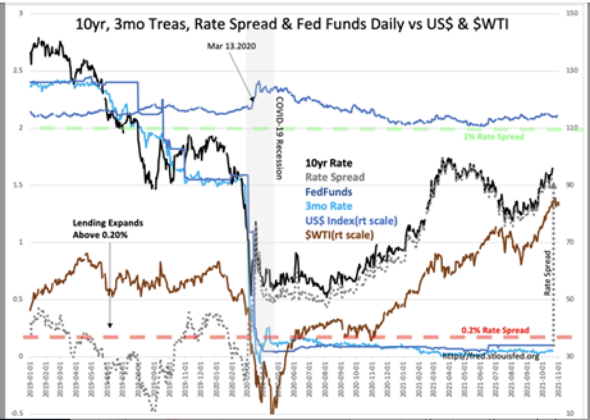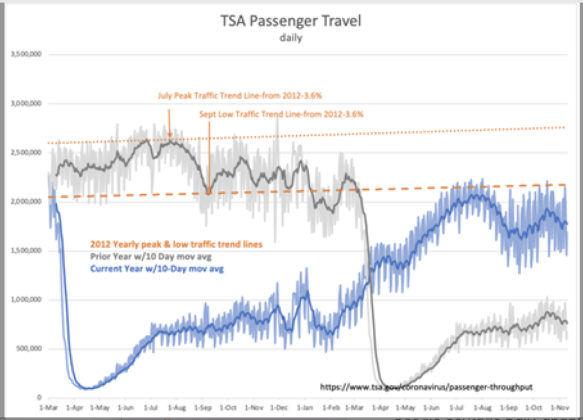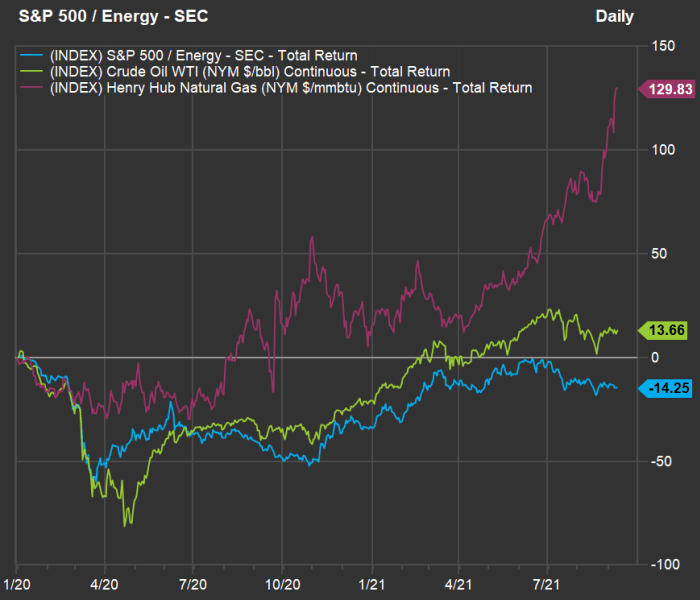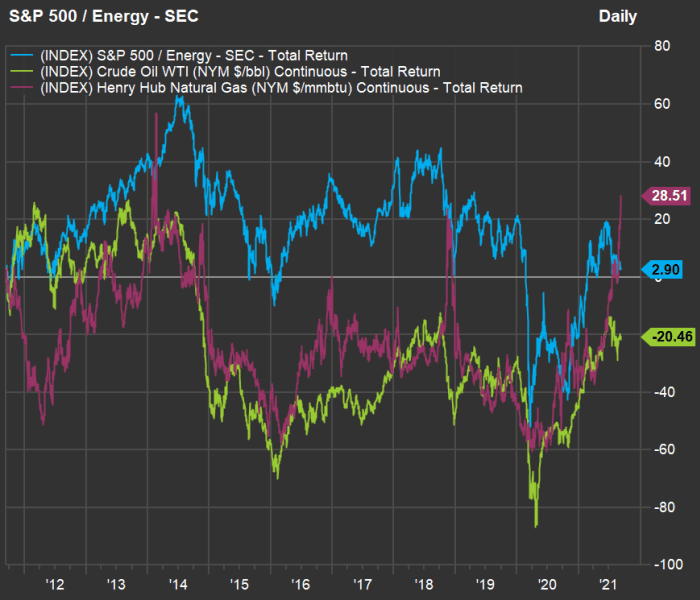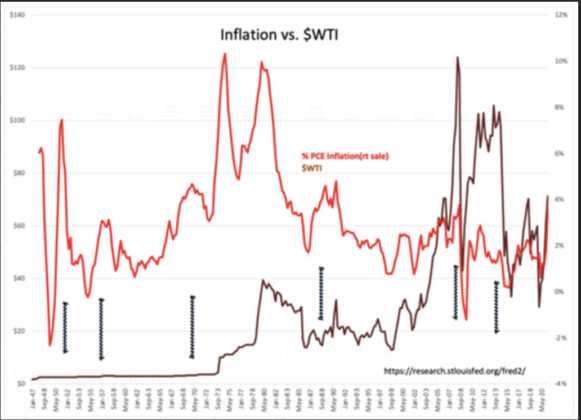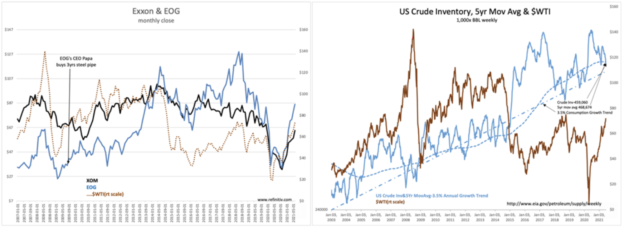Energy and metals – Part III
- Potential future catalyst
- FDA approval of Moderna vaccine
- FDA approval of child 5 ~12 yrs old vaccine
- FDA approval of child 0~5 yrs old vaccine
- Delta CV-19 cases bottom
- the antiviral pills could come by the end of the year
- Covid’s ‘pandemic phase’ ending when antiviral pills, kids’ vaccines available
- $3.5 Tril welfare money for huge inflation, US dollar devalued
- oil companies Q3 earning and stock buyback
- US economy fully reopen, US might be back to normal in one year
- stock market rotation due to inflation and interest rate
- record revenue and stock dividend and buybacks
- demand recovery in China, Europe and world wide
- energy crisis in Winter in China and Europe
- supply crunch
- US infrastructure bill approved by end of Sept What the Infrastructure Bill Would Help Fix First – WSJ
- U.S. crude oil inventories fell more than expected
- middle east war from Taliban
- fall of new energy and EV companies due to China’s RE’s fall and interest rate’s rise
- oil demand is on the rise, as international travel restrictions are starting to be loosened
- Hurricane Ida have continued a month after the hurricane made landfall, with nearly 300,000 daily barrels of oil still offline – short term effect
- U.S. oil/gas companies are still in the early part of an “extended” cyclical rebound with echoes of the mid-2000s. And while valuations have recovered from lows of last year, only a few of the companies are higher vs. their pre-COVID-19 levels.
- the real reason that Big Oil won’t raise production is a matter of simple economics. oil explorers in the United States are making more money now than at any other point in the more-than decade-long history of the nation’s shale revolution. “And this may just be the beginning,” Bloomberg Markets reported this week. “Free cash flow, the key metric watched by investors, probably will increase by 38% next year, presuming oil prices remain elevated.”
- Dec 23, 2021. This week saw another large oil/oil product inventory draw (NYSEARCA:USO) (CL1:COM) (CO1:COM), bringing the two-week total to ~27mb and resulting in stocks below the 2010 to 2014 average, a period in which Brent oil prices averaged ~$100.
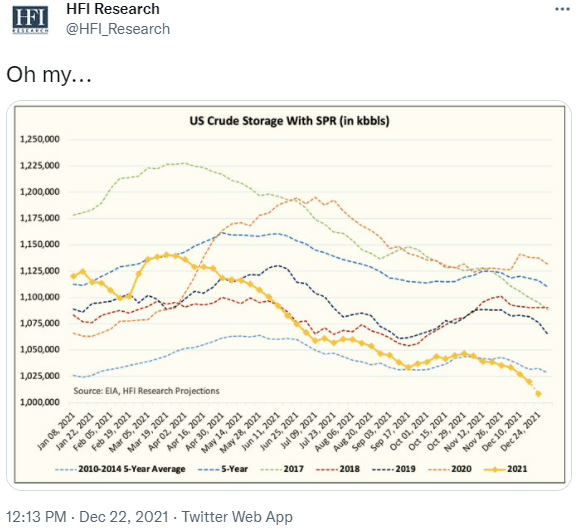
- Rystad reported that oil exploration put up its worst year since the Second World War, as majors like Exxon (NYSE:XOM), Chevron (NYSE:CVX), BP (NYSE:BP), and Total (NYSE:TTE) cut budgets and retrench to short-cycle basins.
- The IEA said in its monthly oil market report that OPEC+ spare capacity could fall to below 4 million barrels per day (bpd) in the fourth quarter of 2022 from 9 million bpd in the first quarter of 2021. It forecast global demand at 99.6 million bpd in 2022, slightly above pre-pandemic levels. OPEC+ Spare Capacity Is Insufficient Amid Global Energy Crisis; The Myth Of OPEC+ Spare Capacity
- Beijing is cutting interest rate to bolster economy, and expediting the rollout of major infrastructure projects
Potential future risks
- new CV-19 variant coming
- another CV-19 cases wave
- OPEC+ and US to significantly increase oil production
- watch out the possible oversupply in 2022
- Oil price and oil demand will be under pressure due to China housing property crisis (i.e EverGrande)
- US and Iran nuclear deal
- OPEC to increase production
- Iran to increase production
- customers do not use oil once price is too high
- oil price tends to reverse to mean once increases too fast.
- Higher rate will strengthen dollar, and reduce oil price
- Russia to invade Ukraine, to strengthen $ and suppress interest rate, the trading algorithm will reduce oil price. World financial market (swift system, oil transfer, sanction of Russia, Russia’s anti-sanction, world economy slow down, etc.) will be in danger – at least in short term, and oil stocks will be dragged down significantly
- Oil Stocks Are Nearing New Heights. It’s Time to Be Careful. A surging oil price might correct itself, as consumers back away from spending on gasoline to protect their wallets. The higher prices go, the more incentive oil companies have to extract barrels from the ground, and the more wells that were once uneconomical can be pumped at a profit. Plus, central banks around the globe are set to lift interest rates to combat high inflation across the board, which could cause oil prices to decline by slowing economic growth.
In general, oil supply and demand are driven by a number of key factors:
- Changes in the value of the U.S. dollar
- Changes in the policies of the Organization of Petroleum Exporting Countries (OPEC)
- Changes in the levels of oil production and inventory
- The health of the global economy
- The implementation (or collapse) of international agreements
- Russian/Ukraine war
- 03/21/2022 – EU oil embargo?
The White House has announced President Biden will visit Poland as part of his European trip this week for talks with allies about the war in Ukraine. Ahead of the meeting, the European Union is considering whether to impose an oil embargo on Russia. The decision could prompt Moscow to close flows on the Nord Stream 1 pipeline, which help provide the 27-country EU with 40% of its natural gas needs.
- 03/21/2022 – Oil prices jump again on Russia-Ukraine fears, as IEA calls for cut in energy usage. China’s latest Covid impact could be less dire than anticipated amid expectations of easing restrictions. The key hub of Shenzhen partially opened up Friday, as five districts were allowed to restart work and resume public transportation, Reuters reported.
- Crude futures were up as much as 3% on Monday morning during Asia trading, with Brent at $110.81, and U.S. futures at $107.68.
- Oil prices have been volatile in recent weeks – soaring to record highs in March before tumbling more than 20% last week to touch below $100. They jumped again in the latter half of last week.
- Ukrainian and Russian officials have met intermittently for peace talks, which have failed to progress to key concessions.
- Tight supply continued to worry markets, sparking a call by the International Energy Agency (IEA) on Friday for “emergency measures” to reduce oil usage.
Oil prices jumped even higher on Monday after Russia-Ukraine talks appeared to yield no sign of progress, and markets continued to fret over tight supply — sparking a call by the International Energy Agency to reduce oil demand.
In a note on Monday, Mizuho Bank said two factors were pushing oil prices higher: lingering Russia-Ukraine uncertainty as well as hopes that China’s latest Covid impact could be less dire than anticipated amid expectations of easing restrictions. The key hub of Shenzhen partially opened up Friday, as five districts were allowed to restart work and resume public transportation, Reuters reported.
Ukrainian and Russian officials have met intermittently for peace talks, which have so far failed to progress to key concessions. Still, Ukrainian President Volodymyr Zelenksyy has called for another round of talks with Moscow.
“If these attempts fail, that would mean that this is a third world war,” Zelenskyy told CNN’s Fareed Zakaria in an interview that aired Sunday morning.
“The breakdown of peace talks between Russia and Ukraine saw crude oil prices extend their rebound on Friday,” ANZ Research analysts Brian Martin and Daniel Hynes wrote in a Monday note. “However, it failed to offset the losses earlier in the week, with Brent crude ending down more than 4%.”
The Russia-Ukraine war has led to worries over supply disruptions as a result of U.S. sanctions on Russian oil and gas. The U.K. and European Union also said they would phase out Russian fossil fuels. Russia supplied 11% of global oil consumption and 17% of global gas consumption in 2021, and as much as 40% of Western European gas consumption in the same period, according to statistics from Goldman Sachs.
European Union governments are set to meet U.S. President Joe Biden this week as the EU considers an oil embargo on Russia over the unprovoked invasion of Ukraine.
The Commonwealth Bank of Australia warned Monday that oil prices have fallen below recent peaks because markets are still largely pricing oil by “assessing the likelihood of a diplomatic solution to the Ukraine conflict.”
“Physical shortages, linked to current sanctions on Russia, though will eventually play a more dominant role in oil price determination,” said Vivek Dhar, the bank’s director of energy commodities research, in a note.
“The industry’s apparent inability to fill any potential gap has seen calls for consumption to be reduced,” the ANZ Research analysts said.
OPEC+ in its latest report showed some producers are still falling short of their supply quotas, with Reuters citing sources who said that the alliance missed its targets by more than 1 million barrels a day.
In a 10-point plan, the IEA’s suggestions to reduce oil demand included reducing speed limits for vehicles, working from home for up to three days a week, and avoiding air travel for business.
“We estimate that the full implementation of these measures in advanced economies alone can cut oil demand by 2.7 million barrels a day within the next four months, relative to current levels,” the IEA said Friday.
- 03/18/2022 – Iran might can fill some oil supply gap created by Russia
Russia backs down on demands in Iran nuclear deal talks, making revival of 2015 pact imminent
- With the U.S. terminating its imports of Russian oil and the EU looking to reduce its energy dependency on Moscow, Iranian crude is looking more alluring.
- A return to the 2015 deal would see the return of Iranian oil to the market at a time when crude prices have hit their highest levels in more than a decade.
- The release of British-Iranian dual nationals from years of Iranian detention back to the U.K. has improved prospects for an agreement.
Russia has walked back its threat to torpedo the revival of the 2015 Iranian nuclear deal over recent sanctions imposed over its invasion of Ukraine, reopening the way to an agreement after nearly a year of talks.
The parties involved in the pact, formally known as the Joint Comprehensive Plan of Action, or JCPOA, were reportedly close to reaching a deal in Vienna until the U.S. and EU imposed sweeping sanctions on Russia over its invasion of Ukraine. Moscow then demanded that future trade with Iran not be impacted by Western sanctions, prompting the talks to be suspended last week.
The prospect of a return to the deal has not sat well with Washington’s Arab Gulf allies, particularly Saudi Arabia and the United Arab Emirates, two of OPEC’s leading crude producers and longtime adversaries of Iran. The two reportedly did not take President Joe Biden’s calls as he attempted to convince them to increase their oil production to alleviate soaring prices.
OPEC has not indicated any move to upping its production beyond pre-planned increases agreed between OPEC members and their non-OPEC allies, led by Russia, in 2021.
- 03/16/2022 – “It seems like the old adage that the best cure for high prices, is high prices, is as strong as ever,” myriad factors weighed on sentiment, including talks between Russia and Ukraine, a potential slowdown in Chinese demand and unwinding of trades ahead of the Federal Reserve’s expected rate hike on Wednesday.
Oil drops again, now more than 27% below recent high
Oil registered heavy losses Tuesday, building on Monday’s decline, as myriad factors weighed on sentiment, including talks between Russia and Ukraine, a potential slowdown in Chinese demand and unwinding of trades ahead of the Federal Reserve’s expected rate hike on Wednesday.
Both West Texas Intermediate crude, the U.S. oil benchmark, and global benchmark Brent crude settled below $100 per barrel Tuesday, a far cry from the more than $130 they fetched just over a week ago.
WTI ended the day at $96.44, for a loss of 6.38%. During the session it traded as low as $93.53. Brent settled 6.54% lower at $99.91 per barrel, after trading as low as $97.44.
WTI and Brent fell 5.78% and 5.12%, respectively, on Monday.
“Growth concerns from the Ukraine-Russia stagflation wave, and FOMC hike this week, and hopes that progress will be made in Ukraine-Russia negotiations” are weighing on prices, said Jeffrey Halley, senior market analyst at Oanda. “It seems like the old adage that the best cure for high prices, is high prices, is as strong as ever,” he added, noting that he believes the top is in for oil prices.
China’s latest moves to curb the spread of Covid-19 are also having an impact on prices. The nation is the world’s largest oil importer, so any slowdown in demand will hit prices.
A deal with Iran could also add new barrels of oil to the market. Russia’s Foreign Minister Sergey Lavrov is in favor of resuming the deal, according to Reuters.
- 03/16/2022 – China is set to see a sharp slowdown in March, given it is dealing with the worst Covid outbreak since 2020. Oil price drops 8% again to $94.7 today. But Putin reportedly told European Council President Charles Michel that Ukraine is “not showing a serious attitude” toward ending the fighting between the two countries. Finally, OPEC warned in its monthly report that inflation stoked by the Russia-Ukraine war could undercut oil consumption, but it did not change its forecast for strong demand this year.
China’s Covid spike worsens: Dongguan factory center locks down, new cases top 3,500 nationwide
- Recent outbreaks in 28 provinces have infected more than 15,000 people and stem primarily from the highly transmissible omicron variant, China’s National Health Commission said Tuesday, according to state media.
- On Tuesday, Dongguan city in the southern province of Guangdong ordered employees of businesses to work from home and locked down residential areas, permitting only necessary activities such as buying groceries and taking virus tests.
- Yum China, which operates Pizza Hut and KFC in the country, announced Monday that same-store sales for the first two weeks of March have fallen by about 20% year-on-year.
China is set to see a sharp slowdown in March, given it is dealing with the worst Covid outbreak since 2020. Larry Hu, CHIEF CHINA ECONOMIST, MACQUARIE
Major oil stocks extend slide as crude closes below $100
Widespread COVID-related lockdowns in China are spooking the market, “given its resulting impact on energy demand, as well as the uncertainty it brings about further lockdowns,” Kpler analyst Matt Smith told MarketWatch.
“Growth concerns from the Ukraine-Russia stagflation wave, and FOMC hike this week, and hopes that progress will be made in Ukraine-Russia negotiations” are weighing on prices, according to Oanda’s Jeffrey Halley.
But Vladimir Putin reportedly told European Council President Charles Michel that Ukraine is “not showing a serious attitude” toward ending the fighting between the two countries.
Finally, OPEC warned in its monthly report that inflation stoked by the Russia-Ukraine war could undercut oil consumption, but it did not change its forecast for strong demand this year.
- 03/10/2022 – UAE backtracks on output boost statement, oil price will increase again?
Oil Rises As UAE Backtracks On OPEC Output Boost Statement
- Crude prices tanked yesterday after the UAE Ambassador to Washington said that the UAE favors further production increases.
- Today, the Emirati energy minister, Suhail al Mazrouei has reaffirmed that the UAE will stick to the OPEC plan of gradual production increases.
The UAE has taken a step back from assurances it would encourage fellow OPEC members to boost their production above their agreed quotas to help rein in runaway oil prices.
In a tweet quoted by media, the Emirati energy minister, Suhail al Mazrouei, said that “The UAE believes in the value OPEC+ brings to the oil market,” and the country remains committed to the OPEC agreement for the gradual increase of oil production.
The minister’s statement follows another one, made by the UAE’s ambassador to the United States, saying that “We favour production increases and will be encouraging Opec to consider higher production levels.”
Shared with the Financial Times, the statement also said that “The UAE has been a reliable and responsible supplier of energy to global markets for more than 50 years and believes that stability in energy markets is critical to the global economy.”
Yet it seems Ambassador Yousef al-Otaiba’s statement was not coordinated with the energy ministry, which prompted the tweet by al Mazrouei.
Oil prices reacted positively to the Minister’s tweet, with Brent crude trading 5.97% higher at $117.8 per barrel, while WTI crude traded 5.23% higher on the day at $114.4 per barrel.
- 03/09/2022 – this might ease oil price somewhat
U.A.E. Pushes for Increased OPEC Oil Production Amid Russian War on Ukraine – WSJ
The move marks a departure for the Persian Gulf producer after months of standing with Saudi Arabia and Russia
The U.A.E. has about 1 million barrels a day of so-called spare capacity to produce more oil.
- U.S producers were largely expecting to keep oil production flat this year, and in the face of surging crude prices output can’t just be ramped up, said Oxy CEO Vicki Hollub.
- The oil-rich Permian Basin faces significant challenges in boosting output, according to Hollub. But it’s the only shale basin in the U.S. that can increase production, she said.
- Among the challenges are the age of the wells, labor shortages and securing raw materials.
- 03/08/2022 – should I invest more in oil companies?
USA TODAY US, NATO balk at plan to send MiG-29 jets to Ukraine; defiant Zelenskyy vows ‘fight to the end’: Live updates
Russia warns oil prices could reach $300 per barrel
Russia warned the price of oil could leapfrog to $300 a barrel and threatened the possible closure of gas supplies to Europe amid rising tensions against Western countries considering a ban on Russia oil.
“It is absolutely clear that a rejection of Russian oil would lead to catastrophic consequences for the global market,” Russian Deputy Prime Minister Alexander Novak said in a statement on state television, according to Reuters. “The surge in prices would be unpredictable. It would be $300 per barrel if not more.”
Noting Germany’s decision last month to freeze the certification of the Nord Stream 2 gas pipeline, Novak said Russia could ax the existing Nord Stream 1 pipeline – considered one of Europe’s main sources of natural gas.
“We have every right to take a matching decision and impose an embargo on gas pumping through the Nord Stream 1 gas pipeline,” said Novak, The Guardian reported.
Gas prices are now the most expensive in US history
After days of dramatically rising gas prices in wake of Russia’s invasion of Ukraine, the national average for a gallon of gas is now the highest in U.S. history, breaking the record that stood for nearly 14 years. As of Tuesday morning, the cost of regular gas in the U.S. is $4.17, according to AAA, up from $4.06 on Monday. Last week, the average cost was $3.60.
The previous national average high was $4.11, set on July 17, 2008, according to AAA.
“Americans have never seen gasoline prices this high, nor have we seen the pace of increases so fast and furious,” Patrick De Haan, head of petroleum analysis at fuel-savings app GasBuddy, said in a statement on Monday.
Oil Prices Could Hit $240 This Summer
Oil prices could hit $240 per barrel this summer in the worst-case scenario if Western countries roll out sanctions on Russia’s oil exports en masse.
That’s according to Rystad Energy’s head of oil markets, Bjørnar Tonhaugen, who made the statement in an extraordinary market note sent to Rigzone on Wednesday.
“Market volatility is at an all-time high, with prices surging on the expectation that supply will further tighten due to restrictive sanctions on Russian energy from the West,” Tonhaugen said in the statement.
- The EU imported 45% of its total gas imports from Russia in 2021.
- On Tuesday, it announced its plan, called REPowerEU, to reduce its purchase of Russian gas by two-thirds before the end of the year.
- The plan focuses on ramping up renewables, increasing energy efficiencies and diversifying its energy supply sources. Also, the plan includes options for mitigating the higher energy costs to vulnerable consumers and small businesses.
-
03/07/2022 – great comments from Scott Grannis on currencies and commodities. Chart #3 compares the value of the dollar (blue, inverted) to an index of industrial commodity prices. Note how the two tend to move together (i.e., inversely). But they’ve done just the opposite in the past few years: the dollar has been strong and commodity prices have been soaring. This tells us that the value of the dollar is not driving higher commodity prices. But since commodity prices are rising in terms of nearly all currencies, it’s possible that the world’s central banks are way too accommodative. Recessions are almost always preceded by very high real interest rates, a flat or inverted Treasury yield curve, and a significant increase in 2-yr swap spreads. Currently we have none of these conditions. Real yields are very low, the yield curve is still positively sloped, and swap spreads (in the U.S., but not in the Eurozone) are still within normal ranges. Liquidity is therefore abundant, and abundant liquidity is one of the best ways for an economy to avoid a recession. With liquidity, markets can efficiently shift risk to those willing to bear it; without liquidity, panic can ensue, much as happens when someone yells “Fire!” in a crowded theater. – we have Russian invasion, high inflation and “superbubble” of stock/housing/bond/commodity market, but no burst of these yet might be simply because we have abundant liquidity and us economy continues to grow despite of all these.
Currencies & commodities in perspective
Chart #3 compares the value of the dollar (blue, inverted) to an index of industrial commodity prices. Note how the two tend to move together (i.e., inversely). But they’ve done just the opposite in the past few years: the dollar has been strong and commodity prices have been soaring. This tells us that the value of the dollar is not driving higher commodity prices. But since commodity prices are rising in terms of nearly all currencies, it’s possible that the world’s central banks are way too accommodative. In other words, it’s possible that all currencies are being debased, and that’s why hard assets are rising. In that case, look for inflation to be rising nearly everywhere.
Chart #4 compares the dollar (inverted) to the price of oil. Here we seen the same pattern as with industrial commodity prices.
Chart #5 shows the inflation-adjusted price of oil. Note how virtually every recession has been preceded by a a very high real level of oil prices. Energy is so essential to growth that when oil becomes very expensive growth tends to weaken. It would be tempting to say that this chart is good evidence that recession risk is high, both here and in the Eurozone. But I think it takes a few more things to happen before recession becomes imminent. I go back to previous posts in which I point out that recessions are almost always preceded by very high real interest rates, a flat or inverted Treasury yield curve, and a significant increase in 2-yr swap spreads. Currently we have none of these conditions. Real yields are very low, the yield curve is still positively sloped, and swap spreads (in the U.S., but not in the Eurozone) are still within normal ranges. Liquidity is therefore abundant, and abundant liquidity is one of the best ways for an economy to avoid a recession. With liquidity, markets can efficiently shift risk to those willing to bear it; without liquidity, panic can ensue, much as happens when someone yells “Fire!” in a crowded theater.
- 03/08/2022 – Scott’s great viewpoint on how Russia/Ukraine war will the U.S. and Eurozone economies
I don’t pretend to know how the Russia/Ukraine war will play out, but I can shed some light on how it has impacted the U.S. and Eurozone economies. Not surprisingly, the U.S. economy continues to grow, while the Eurozone economy has taken a serious hit. Everyone, however, is suffering from higher-than-expected inflation. Central banks live in fear of the risks of war, and so are reluctant to tighten. As a result, monetary policy is still very accommodative nearly everywhere, and unlikely to pose a serious near-term risk.
Chart #1
The February jobs report was quite strong, and contained the welcome news that the labor force participation rate (see the bottom chart above) has risen significantly. Chart #1 also suggests the reason for the surge, namely the big decline in transfer payments. Funny how things work: if you pay people who aren’t working, you won’t find very many willing to work, and when you stop paying them they are more inclined to work. (Our economy is not suffering from a lack of jobs, that’s for sure.)
Chart #2
Chart #2 compares the level of private and public sector jobs. Two bright spots: private sector employment has recovered almost all its Covid-related loss, while public sector jobs have recovered less than half. (In my book, private sector jobs are much more productive than public sector jobs.) Government has become less obese, and that’s good news.
On the other hand, the level of private sector jobs today is still at least 5 million short of where it might have been in the absence of the Covid crisis.
Chart #3
Swap spreads, shown in Chart #3, are excellent indicators of a) liquidity conditions and b) the outlook for corporate profits and economic health in general. Swap spreads have risen a bit in the U.S., but not enough to be worrisome (in a normal economy, you’d expect these spreads to be 15-35 bps). Conditions in Europe are not so good, however, with swap spreads having jumped to recession-era levels. Limiting Russia’s ability to use the SWIFT payment system is a big factor reducing liquidity overseas.
Chart #4
Chart #4 is my favorite chart for gauging recession risk. Every recession except the last one was preceded by very high real yields and a flat or inverted yield curve. We’re not even close to either at this point. Real yields on the Fed funds rate are at record-setting (and mind-blowing) lows, which means liquidity conditions are flush and the Fed and the banks are practically begging people to borrow money. Combine this with Chart #3 and you see that all three of the indicators that normally precede recessions are not at all in worrisome territory, at least in the U.S.
Chart #5
|
|
Chart #5 compares the price of gold to the real yield on 5-yr TIPS (inverted, so as to be a proxy for their price). This tells us that both TIPS and gold are highly sought-after for their risk-reducing properties—which in turn means the market is very worried. There is no shortage of things to worry about, and from a contrarian viewpoint, that’s bullish. The last time the markets were this worried was in the 2011-2014 period, when Europe faced the risk of national defaults and the collapse of the Euro.
Chart #6
Chart #6 shows nominal and real yields on 5-yr Treasuries, and the difference between the two (green line), which is the market’s expectation for what the CPI will average over the next 5 years. Inflation expectations are now at new highs (about 3.3%), as the market is slowly coming around to seeing that the burst of inflation that started early last year is not going to be transitory. I would expect these expectations to continue rising over the next year or so, which means that nominal interest rates are almost certain to rise meaningfully.
Chart #7
Chart #7 compares the real yield on 5-yr TIPS to the current real yield on the Fed funds rate. In effect, the red line is what the market thinks the blue line will average over the next 5 years. In short, the market thinks the Fed is going to keep short-term rates negative in real terms for a long time. Borrowing at a floating rate of interest is thus likely to be attractive for awhile.
Unfortunately, as I’ve explained many times in recent posts, the persistence of negative real yields helps weaken the demand for money, and this in turn adds fuel to the current inflation fires. The Fed will need to do a lot of tightening at some point to bring inflation down.
Chart #8
Chart #8 compares the Vix index (the worry index) to the level of the S&P 500. Whenever the market gets very worried, stock prices (unsurprisingly) decline. The level of worry today is not yet at an extreme, however, so things may get worse before they get better. On the other hand, a healthy amount of worry means the market is prepared for bad news, and that acts as a buffer.
- 03/08/2022 – Russia is also a major supplier of grains and metals such as aluminum, nickel and palladium, which it accounts for 40% of the world’s production. A sweeping ban on exports could upend global commodity markets. Nickel hit an all-time high today.
Russia Set to Ban Commodity Exports Following Western Sanctions – WSJ, Putin decree didn’t specify which commodities would be covered by the export ban
Oil prices rose following Mr. Putin’s decree. Brent-crude prices, the international benchmark, extended earlier gains to trade 5.9% higher at $130.50 a barrel, before slipping back. They remained below the high of about $139 a barrel recorded on Monday.
Russia is also a major supplier of grains and metals such as aluminum, nickel and palladium, which it accounts for 40% of the world’s production. A sweeping ban on exports could upend global commodity markets. Nickel hit an all-time high today.
- 03/08/2022 – The U.S. is banning imports of Russian oil now, The U.K. government said Tuesday it will phase out Russian oil imports by the end of 2022. Some Western government officials are pushing for the Group of Seven leading economies to work together to help European nations wean themselves off Russian oil and gas, which officials believe such a shift could take years to play out, given the high level of dependence and the long-term gas contracts that exporters have already signed.
Biden Bans Imports of Russian Oil, Natural Gas – WSJ
Deliberations about imposing a ban ramped up as lawmakers of both parties called for action on the issue
The U.S. is banning imports of Russian oil, President Biden said, targeting the lifeblood of Moscow’s economy as the West ratchets up pressure on Russian President Vladimir Putin over his invasion of Ukraine.
The U.S. will give companies 45 days to wind down existing contracts for Russian energy supplies, a senior Biden administration official said. The order also bars new U.S. investment in Russia’s energy industry and blocks Americans from financing foreign companies that invest in the sector.
Mr. Biden acknowledged that many of the U.S.’s European allies won’t be able to take similar action right away because of their heavy dependence on Russian energy. “We can take this step when others cannot,” he said, adding that the U.S. is working with Europe on a long-term strategy to wean off Russian energy.
The U.K. government said Tuesday it will phase out Russian oil imports by the end of 2022. Russian oil imports currently make up 8% of U.K. demand. The government is also exploring options to end Russian gas imports altogether.
The European Union said Tuesday that it planned to cut its imports of Russian natural gas by two-thirds by the end of this year.
Some Western government officials are pushing for the Group of Seven leading economies to work together to help European nations wean themselves off Russian oil and gas. This would include helping countries build more liquefied natural-gas terminals, rerouting deliveries from other nations and working with countries in the Middle East to increase production. However, officials believe such a shift could take years to play out, given the high level of dependence and the long-term gas contracts that exporters have already signed.
- 02/13/2022 – In my estimation, the greatest investment returns come from evaluating the factors and degree to which a consensus has been formed distant from the economic reality of any business sector. The snap-back can be intense which is what I think we will see with fossil fuels.
News reports the EIA is backing away from an earlier forecast of a crude surplus in 2022. This reinforces a building theme of supply deficit in the near an likely longer term i.e. 1yr and out to 2yrs-3yrs, with current lack of equipment capacity and trained labor.
IEA updates oil supply/demand forecast – demand higher, balances tighter in 2022
The International Energy Agency “IEA”, OPEC, and the US Department of Energy have been aligned inforecasting oil surplusesfor the duration of 2022 and beyond. The market has taken a different view in recent months, withrapid inventory declinesleading prices to multi-year highs. Early Friday, a revised report from the IEA suggests the Agency is coming around to the market’s view.
The report’s forecast revision, just the revision, lifted demand estimates for 2022 by 800kb/d. With the Agency citing higher petrochemical demand from China and increased consumption in Saudi as the primary reasons for the revision. Post revisions, the IEA sees demand growing 3.2mb/d in 2022.
On the supply side, the IEA discussed at length the potential for OPEC+ to increase supplies. Indicating that if quotas were met, the group could add 4.3mb/d to the market this year. As to why the group has been unwilling or unableto meet self-imposed quotas, the IEA provides little insight. Importantly, the Agency sees US supplies growing by 1.2mb/d in 2022; Conoco’s(NYSE:COP)CEOsees 800-900kb/d of growth, while the Citi strategist advising clients to short oil sees 1.0mb/d of supply growth this year.
Just as important as the supply/demand forecast is the IEA inventory update. The Agency is the only source providing a comprehensive view of OECD oil and oil product inventory levels. In December, OECD stocks fell by 60mb. The DOE report showed a 36mb decline in the US over the same period, indicating that record inventory draws are not unique to the US market.
(NYSEARCA:USO)(NYSE:XOM)(
NYSE:SHEL)(NYSE:CVX)(NYSE:BP ) In assessing supply growth, there is a clear divide between those jockeying spreadsheets in Paris and Washington DC, and those buying pipe, hiring crews and producing barrels, like Conoco’s CEO Ryan Lance. Though in assessing real-time inventory reports few disagree that the market is in deficit and in need of additional supplies, and soon.
Higher oil prices, even perhaps a new all-time high are ahead in my opinion accompanied with strong rise in cash flows for energy related cos. It does not stop there as we have seen in the past there are connections throughout the industrial sector spilling over into retail and services that become empowered with rising cash flows in anything as economically vital as oil/gas. This will spark innovation as in past price surges and some entirely new businesses are likely to emerge.
The next 2yrs-3yrs will prove interesting to say the least considering the 7yr drought of CAPEX and a potential 180 degree turn in investor psychology.
In my estimation, the greatest investment returns come from evaluating the factors and degree to which a consensus has been formed distant from the economic reality of any business sector. The snap-back can be intense which is what I think we will see with fossil fuels.
IEA updates oil supply/demand forecast – demand higher, balances tighter in 2022
Official OPEC stats for January are out, results are worse than expected
- 02/09/2022 – A few analysts see a crude deficit and forecast much higher prices, yet market activity reflects disbelief. Since March 2021, Total US Crude Inv has fallen 143mil BBL or ~13%. ~70 mil BBL of this decline is in the SPR while the rest comes from the industry working inventory which with this report hit a new low vs trend-line from 2003.
Crude Inventory Down 13% With 1/2 Coming From SPR
I do not think we are at a “peak oil” scenario. What I do think is we have a constantly shifting energy and drilling policy in the US now and that simply does not work for the long-term planning needed for the industry to make significant investments. Until the energy industry feels safe in starting multi-million dollar projects, they need to have some level of confidence those projects are not going to be scrapped on a whim from Washington, thus stranding millions in then lost investment.
Until we get that, we can expect energy prices to continue their upward march. The unfortunate thing about this is the dynamic will be in place for some time. Even if we played “what if” and said the US formulates a long-term plan next month, it takes time for the industry to then decided what to do within those parameters and then implement it. In short, the current state of the energy market will have a decent, long-tail effect into the future that is negative for consumers.
“Davidson” submits:
-
US Crude Prod 11.6mil BBL/Day(0.1mil higher vs last week), US Crude Imports 3.3mil BBL/Day(1.3mil lower vs last week) Total US Crude Inv fall 6.2mil BBL(4.8mil working Inv and 1.4mil SPR)
-
US Gas Inv lower by 1.7mil BBL, Crude Refining Input rise 0.3mil BBL/Day, US Exports Refined Prod remain low, Jet Fuel consumption remains at lower levels, US Consumption appears reaching for higher level
The overall picture in the US Oil Situation is continued production discipline as crude inventories continue in decline. US Gasoline Inventories are lower on during refinery shutdowns for maintenance with available domestic supplies being supplemented by lower exports. US Consumption in recent weeks appears to be reaching higher levels. The volatility in data makes this too early to call.
Since March 2021, Total US Crude Inv has fallen 143mil BBL or ~13%. ~70 mil BBL of this decline is in the SPR while the rest comes from the industry working inventory which with this report hit a new low vs trend-line from 2003.
A few analysts see a crude deficit and forecast much higher prices, yet market activity reflects disbelief.
- 01/31/2019 – What Oil Companies Can Learn From Big Tobacco
- 01/28/2022 – good for the oil companies, stay invest in the long run
Chevron Rakes in $15.6 Billion in Annual Profits as Oil Prices Climb – WSJ
For Big Oil’s Future, Look to Big Tobacco’s Past – WSJ
- 01/27/2022 – developing news on Russia. “Putin is trying to frighten us with a great war, and now we understand that for at least two more weeks there won’t be war. As long as the diplomats talk, the guns remain silent,” – but uncertainty and volatility might increase
- China Calls for Calm From U.S. on Ukraine – WSJ China’s description of Messrs. Blinken and Wang’s phone call didn’t mention Washington’s proposals. During the call, Mr. Wang told Mr. Blinken that “regional security cannot be guaranteed by strengthening or even expanding military blocs,” an apparent reference to NATO. Mr. Wang said Beijing would support a solution in Ukraine that was “in line with the direction and spirit of” internationally-backed cease-fire agreements signed in 2014 and 2015 between Russia, Ukraine and Russia-backed militants in eastern Ukraine that sought to restore order along Ukraine’s eastern frontier with Russia. Mr. Putin is set to attend the opening ceremony on Feb. 4 and hold a summit with Mr. Xi—the Chinese leader’s first face-to-face meeting with a head of state in nearly two years, and one expected to solidify an alliance between the two U.S. rivals. – It seems like China sides with Russia. Will US back down? We will see what will come out from Putin and Xi’s meeting on Feb 4th.
- Russia and Ukraine agree to continue ceasefire talks
-
Russia Says It Sees Little Scope for Optimism in U.S. Proposals on Ukraine – WSJ After massing troops near Ukraine border, Moscow has been pushing for Washington to bar former Soviet states from joining NATO. “There is not much reason for optimism,” Kremlin spokesman Dmitry Peskov told reporters on Thursday. “It cannot be said that our considerations were taken into account or that any willingness to take into account our concerns was demonstrated.” He said, however, that Mr. Putin would nonetheless “take some time to analyze” Washington’s responses and urged against rushing to conclusions. “No matter how diametrically opposed our views sometimes are, dialogue is always needed,” Mr. Peskov added.
- Ukraine’s Bulked-Up Military Is Still Outgunned by Russia – WSJ Facing off against the troops and tanks that Russian President Vladimir Putin has massed around Ukraine in recent months is a force of roughly 260,000, trained by Western advisers and equipped with its own upgraded armored vehicles, U.S. and British antitank missiles and Turkish armed drones. Russia’s air power and its missile forces would give it a big advantage over Ukraine in the event of a broad conflict, allowing it to inflict considerable damage even without a large deployment of ground forces.
- Russia Sends Medical Units to Ukrainian Front – WSJ
- Fresh Russia-Ukraine Talks Point to Possible Off-Ramp in Crisis – WSJ
Two sides are in discussions to revive a dormant agreement that Ukraine fears could represent a ‘Trojan horse’ to give Russia sway in its future
-
What Russia Wants and What the U.S. Is Proposing in the Ukraine Crisis – WSJ
Russia has issued security-related demands about Ukraine while building up forces along border shared by the two countries
- 01/26/2022 – Russia and Ukraine news.
- Will There Be a War Over Ukraine? 13 Putin Watchers Weigh In
Here’s what Biden needs to know about the famously unpredictable Russian president — and Washington’s best - Ukrainian Foreign Minister says current Russian troop numbers insufficient for full invasion this number is insufficient for a full-scale offensive along the entire Ukrainian border. They also lack some important military indicators and systems to conduct such a large full-scale offensive. Russia will not allow ‘endless discussion– Russian Foreign Minister Lavrov addressed the country’s State Duma on Wednesday and repeated his desire for assurances from the US regarding security measures. “We will not allow any attempts to wind up our initiative in endless discussion,” said Lavrov on Wednesday. “If there won’t be any constructive response and the West will continue its aggressive line, then as the President said multiple times, Moscow will take appropriate response measures.”
- Russia and Ukraine agree to continue ceasefire talks
- Russia’s Attempts to Sanction-Proof Its Economy Have Exposed a Weak Spot – WSJ
- U.S. Delivers Response to Russian Demands
- Italian Executives Meet With Putin
- What Does Russia Want With Ukraine?
- Biden Puts More Military Muscle Into NATO’s Russia Response – WSJ
- Waiting for the Last Days of Putin – WSJ Mr. Putin would face a no-win choice, war with NATO or accepting a defeat of his pet fighters that his personalized rule probably couldn’t survive. If Mr. Putin believes this, then he also believes the U.S. is willing to court big risks to end Mr. Putin’s rule. “Putin is trying to frighten us with a great war, and now we understand that for at least two more weeks there won’t be war. As long as the diplomats talk, the guns remain silent,” said Ukrainian lawmaker Oleksiy Goncharenko. He added, however, that he doesn’t expect any breakthrough in Berlin because Moscow’s and Kyiv’s positions are so far apart.
- What Russia Wants and What the U.S. Is Proposing in the Ukraine Crisis – WSJ
– US makes no concessions on Ukraine after Russia threatens retaliation over unmet demands
– Tensions continue to mount on Wednesday as fears of a Russian invasion of Ukraine persist globally. Russia has denied it is planning to invade despite massing an estimated 100,000 troops along the border. Here’s the latest.
– US Secretary of State Antony Blinken said that the US made no concessions — but is open to dialogue — in response to Russia’s demands for the US and its allies to curb preparation for an invasion and for Ukraine and other ex-Soviet nations to be denied entry to NATO, according to The AP
– Russia promised to retaliate if demands were not met and also warned the US against imposing personal sanctions on President Vladimir Putin, Reuters reports – Ukrainian leaders tried to calm those living in their country by reassuring them that, while the threat of Russian invasion is real, it is not imminent, per The AP
- 01/24/2022- Tilson thinks there is bullish sign. I think he might be right, but should after clearing the uncertainty of Russia invasion, which might become clear after mid of February. Now market might not like the uncertainty, which cause the equity pull back. In addition, Nasdaq is too much overvalued. And Margin debt is too high.
Following up on Friday’s thoughts on the market pullback, the negativity out there has reached very high levels, which is usually a bullish sign.
My friend Doug Kass of Seabreeze Partners sent around some interesting charts yesterday, which have him venturing back into the market…
The Nasdaq is off to the worst start to a year in its history – and that includes the dot-com bust and The Great Recession of 2008-09:
2022: -13.1%
2008: -11.5%
2016: -10.7%
2009: -8.6%
1996: -5.1%The Nasdaq correction is over 17.5%, the fourth-worst correction since The Great Financial Crisis. At 65 days, it’s already longer than the average post-Great Financial Crisis correction of 53 days:
… The number of Nasdaq Index issues down by more than 50% from their 52-week highs has risen to 42%. Since the 2008 financial crisis, only March 12-April 8, 2020 saw more Nasdaq stocks cut in half:
Small growth stocks (measured by the iShares Russell 2000 Growth ETF, IWO) have declined by an astonishing 17% in the last 13 trading days, far more than the iShares S&P 500 Value ETF (IVE):
… The Hulbert Sentiment Index is at the most bearish reading since March 2020:
I think Doug is right that we’re approaching a bottom, especially now that the pandemic is receding (see below), so it’s time to start buying your favorite stocks…
- 01/24/2022 – NATO is not unified (see Germany) and seems like only does some peripheral tasks, US is weak (see Afghanistan) and will not send troops, China supports Russia politically and might support economically if western sanction happens because China looks this as a precedence of Taiwan, Russia cannot allow Ukraine to slip away from Russia which will set a precedence for other old Soviet Union countries
-
Pentagon Places Hundreds of Troops on Standby for Deployment to Eastern Europe
- US puts 8,500 troops on heightened alert amid Russia tension
- Russian Duma takes its time over call for east Ukraine ‘independence’. RIA information company quoted one other Communist deputy as saying the draft could be mentioned “in February”. The Duma Council, which decides when votes ought to happen, is subsequent scheduled to fulfill on Feb. 7. A proposal to ask Russian President Vladimir Putin to recognise two breakaway east Ukraine areas as unbiased won’t be prepared for dialogue by the related parliamentary committee till subsequent week, the committee’s head informed Reuters on Monday. The proposal, initiated by the Communist faction within the Duma, is important as a result of – if parliament authorized it and Putin agreed – it will mark a hardening of Russia’s stance within the Ukraine disaster and additional elevate tensions with the West.
- 01/21/2022- Russia/Ukraine introduces lots of uncertainty to oil stocks and general market. Friday’s meeting is fruitless. Intensive talks between Russia and Western allies yielded posturing and threats but concluded with the two sides seemingly no closer to resolving a standoff that could spiral into one of Europe’s worst security crises in decades. Russian Foreign Minister Sergei Lavrov said on Friday in Moscow, “We will not wait forever” for the West to respond to Russia’s demands.
Russia-U.S. Talks Concluded With Posturing and Threats, but No Movement on Either Side – WSJ
Week of diplomacy leaves U.S. officials pessimistic, uncertain about Vladimir Putin’s intent in Ukraine crisis
Russian Foreign Minister Sergei Lavrov warned on Friday that Moscow was running out of patience. Russia had asked the U.S. in December to respond in writing to its demands of the North Atlantic Treaty Organization.
“We will not wait forever,” Mr. Lavrov said. “Our patience has run out…Everyone understands that the situation is not improving. The potential for conflict is growing.”
No further talks have been scheduled, and the U.S. signaled that the ball is in Russia’s court.
“It’s hard to say whether the talks had any effect on Putin‘s thinking because his mind is not readable,” said Evelyn Farkas, a former defense official in the Obama administration. “If he was already firmly intending to undertake a military operation against Ukraine, he may still do that.”
Heading into the talks, U.S. officials had hoped that carrots—the offer of fresh talks on missile deployments and troop exercises—and sticks—in the form of financial sanctions and export controls—would encourage Mr. Putin to engage in diplomacy rather than attack Ukraine.
Yet in direct talks with the U.S. on Monday, in the NATO-Russia Council on Wednesday and at the Organization for Security and Cooperation in Europe on Thursday, Moscow restated key demands that the U.S. and NATO have rejected.
Russia wants NATO to forswear future expansion into Ukraine and other former Soviet countries, curb the alliance’s ties with Ukraine and former Soviet states and restrict military deployments on the territory of the alliance’s Eastern European members.
U.S. and Western officials rejected the demands as “nonstarters,” according to State Department spokesman Ned Price. The U.S. diplomats left the meetings pessimistic about Moscow’s intentions and lack of flexibility, senior U.S. officials said.
Washington described this week’s discussions as a way to air differences and see what might be possible in future talks. But U.S. officials have voiced increasing mistrust of Moscow, and the troop buildup near Ukraine made it hard for NATO and the American side to entertain Russia’s ideas about the future of European security.
Mr. Lavrov on Friday blamed Washington for a lack of progress, saying U.S. officials should have been ready to negotiate on key Moscow demands. “The Americans failed to study our proposals in order to arrive at a specific position,” Mr. Lavrov said. “They limited themselves to questions and verbal explanations. We are past that stage.”
U.S. officials say the threat of a Russian invasion of Ukraine is real. Russia has deployed more than 100,000 troops along the border with Ukraine and has been moving tanks, infantry fighting vehicles, rocket launchers and other military equipment westward from their bases in its Far East, according to U.S. officials and social-media reports.
U.S. officials have pointed to Russia’s 2014 invasion and annexation of the Crimean Peninsula and fomenting of separatist war in eastern Ukraine, warning they are seeing the same signs of imminent conflict.
“That does give you an indication of all the preparations that are under way,” White House spokeswoman Jen Psaki said, adding that a potential invasion could begin by mid-February.
- 01/20/2022 – the historical all time high (about two times of that of year 2000) margin debt can be served as the biggest catalyst for market crash (and might be great for leveraged inversed ETFs)
The Latest Margin Data
FINRA has released new data for margin debt, now available through December. The latest debt level is down 0.93% month-over-month.
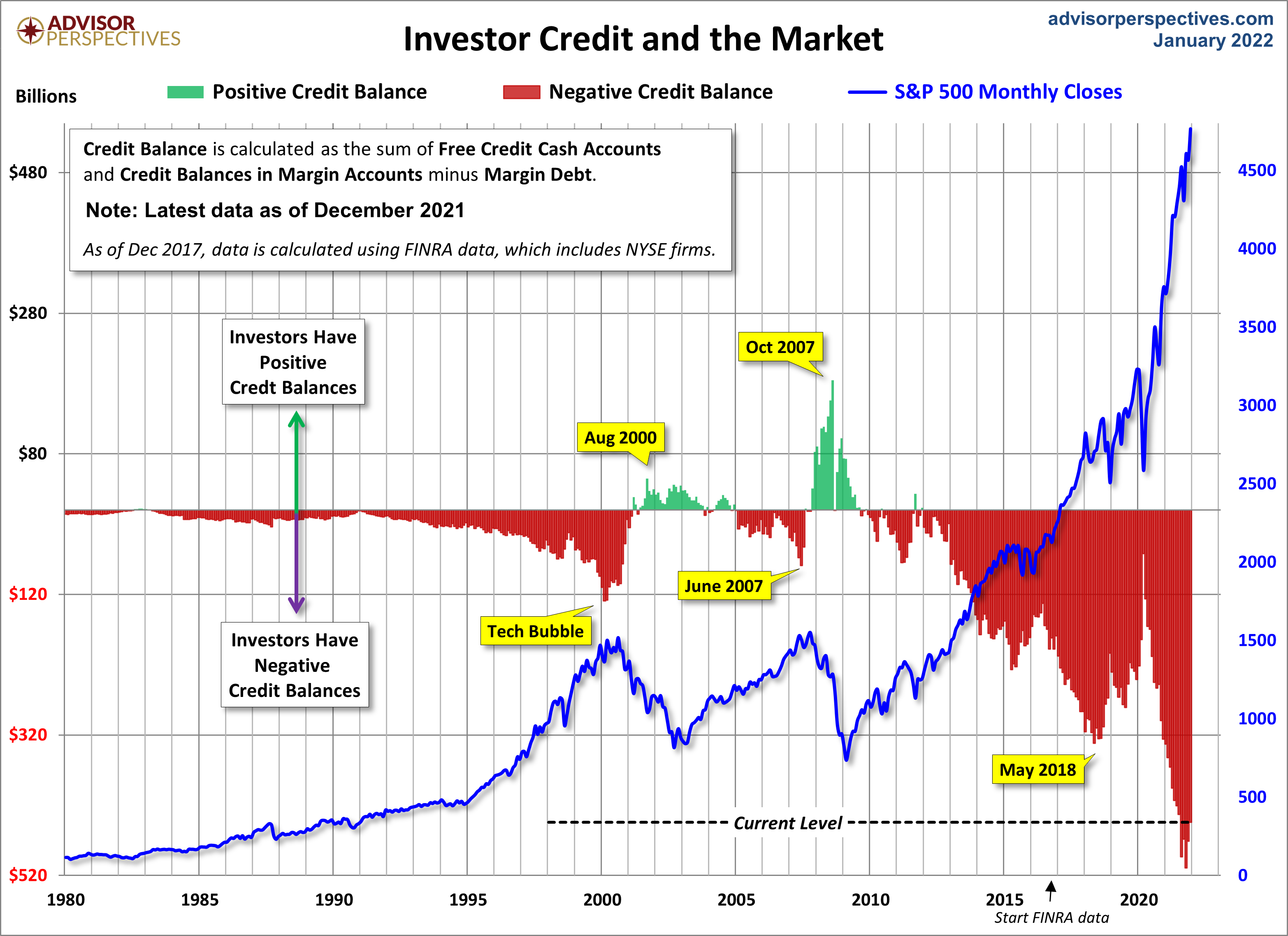
- 01/20/2022 – Russia alert !! “Uncertainty, ambiguity—this is part of his strategy,” The relative lack of consequences for previous actions may have emboldened Mr. Putin to keep raising the stakes. After all, he invaded Georgia in 2008, Ukraine in 2014, annexed Crimea the same year, and ordered alleged assassination plots abroad, such as the 2018 Novichok affair in England, with only limited Western sanctions.
Putin Loves to Roll the Dice. Ukraine Is His Biggest Gamble Yet. – WSJ
Former spy chief’s tolerance for risk is tested as he threatens a ground war unseen in Europe since the 1940s
Mr. Putin is clear about wishing to reassert Russia’s influence over its neighbors, particularly Ukraine. But he has cultivated an aura of unpredictability about his next moves. All along, pulling out tactical surprises has been a hallmark of his foreign policy, from annexing Ukraine’s Crimea peninsula to sending troops to Syria.
“Uncertainty, ambiguity—this is part of his strategy,” said Gleb Pavlovsky, a political scientist who advised the Kremlin between 1997 and 2011. “If everything is clear, then, as they say, whoever is forewarned is forearmed. If everything is clear, then immediately his ability to threaten falls.”
While Mr. Putin relies on the country’s military, intelligence and diplomatic establishment, he’s the one determining policy after having mastered details to a level few Western leaders do, according to foreign officials who have interacted with the Russian leader. This concentration of authority, they say, makes it even harder to analyze Russia’s future moves and predict Moscow’s real intentions.
“He is his own foreign minister and his own defense minister,” said former U.S. national security adviser John Bolton, who has met with Mr. Putin several times, including in Moscow in October 2018.
The relative lack of consequences for previous actions may have emboldened Mr. Putin to keep raising the stakes. After all, he invaded Georgia in 2008, Ukraine in 2014, annexed Crimea the same year, and ordered alleged assassination plots abroad, such as the 2018 Novichok affair in England, with only limited Western sanctions.
Ukraine Fears Minor Attacks Are in Russia’s Game Plan – WSJ
Foreign minister says President Biden’s ‘minor incursion’ comment plays down Moscow’s intentions, which Kyiv sees as destabilizing country, not invading
‘We should not give Putin the slightest chance to play with quasi-aggression or small-incursion operations. This aggression was there since 2014. This is the fact.’ — Ukrainian Foreign Minister Dmytro Kuleba
Oleksandr Danylyuk, Mr. Danilov’s predecessor, said that if Russia attacks it would likely pursue a large-scale offensive aimed at bringing Ukraine under Moscow’s control rather than just expanding the territory it already holds.
“Large aggression will scare the West, and they will be willing to talk,” Mr. Danylyuk said in an interview. “Small aggression will get big sanctions. The negative consequences will outweigh the advantages.”
Mr. Putin has two broad options, Mr. Danylyuk said. The first is a large-scale operation aimed at seizing the eastern half of Ukraine, toppling the government or forcing it to negotiate. The second is an attack using missiles and airstrikes to destroy military and transportation infrastructure. Such an approach would be less costly and strike where Kyiv is weak: its outdated air defense. “It was designed in the 1980s,” said Mr. Danylyuk. “It will not stop Russian aviation, which is state of the art, and missiles and even drones. It’s not designed for it.”
Biden Says Russia Likely to Move Against Ukraine, as Blinken Visits the Region – WSJ
Moscow has deployed forces to its ally Belarus, adding to the troops already positioned along Ukraine’s borders
Russia-Ukraine Border Crisis: Will Putin Invade Ukraine?
The U.S. has warned Moscow of sanctions in the event of an invasion
Russia hasn’t revealed much information about the scale of its troop deployment on the Ukrainian border. U.S. officials, however, say Mr. Putin is assembling a force that is expected to total 175,000 troops, giving him the means to order an invasion by early 2022. Citing new intelligence reports that include images from spy satellites, the officials say the Russian military buildup differs from an earlier massing of troops in the spring. When complete, they say, Russia’s deployment in the area will likely be twice as large. Russia has also embarked on a rapid mobilization of reservists and deployed troops and military assets to ally Belarus, which also shares a border with Ukraine.
Russia’s Military Buildup Near Ukraine Is an Open Secret – WSJ
Satellite images, social media posts and flight-tracking data allow private analysts to track details governments once classified
Biden Seeks to Reassure Ukraine, Vowing a Strong Response to Russia and Transferring Weapons – WSJ
President says any Russian troop movement into Ukraine would be considered an invasion, clarifying earlier remarks about a ‘minor incursion’
Biden Issues New Warning to Russia Over Invading Ukraine | World News | US News
U.S. President Joe Biden says any Russian troop movements across Ukraine’s border would constitute an invasion, saying Moscow would “pay a heavy price” for such an action.
- 01/18/2022 – Russia alert!
Putin Is Waging War on Europe – WSJ
His officials and media supporters have started talking openly about ‘military confrontation.’
What Does the Russian Ultimatum to the West Mean? | Desk Russie (desk-russie.eu)
Hence the approach of the Kremlin: “This is not a proposal for discussion, but an ultimatum — a demand for unconditional surrender. The West has no choice but to lose face — unless it stands proudly and goes to war with Russia. Judging by the way the West has begun to show disarray on the other side, they are well aware of this.” By threatening war, stresses RIA Novosti, “Moscow is emphasizing that Russia is ready — morally, technically, and in every other sense of the word — for any development of events. And the reputation it has earned in previous years confirms that the Russians will indeed be ready to use force if they deem it necessary. It is worth recalling the words of Vladimir Putin, who stated bluntly this summer that if Russia sank the British destroyer responsible for a provocation off the coast of Crimea, there would be no major consequences: the outcry of the world press should not be counted as such […] No, this time the West will pay with its own hands.”
White House warns Russian invasion of Ukraine may be imminent
Press secretary Jen Psaki warned that an “extremely dangerous situation” is building along the Ukrainian border where Russia is amassing troops.
The White House believes Russia could launch an invasion of Ukraine at any moment, press secretary Jen Psaki said Tuesday, warning that an “extremely dangerous situation” is building along the Ukrainian border.
“We believe we’re now at a stage where Russia could at any point launch an attack on Ukraine. I would say that’s more stark than we have been,” Psaki said during her daily press briefing.
The assessment comes as Secretary of State Antony Blinken travels to Ukraine this week to meet with Ukrainian President Volodymyr Zelenskyy. Blinken spoke with Russia’s foreign minister on Tuesday morning and the two plan to meet in Geneva, where he will urge Russia to “take immediate steps to de-escalate,” Psaki said.
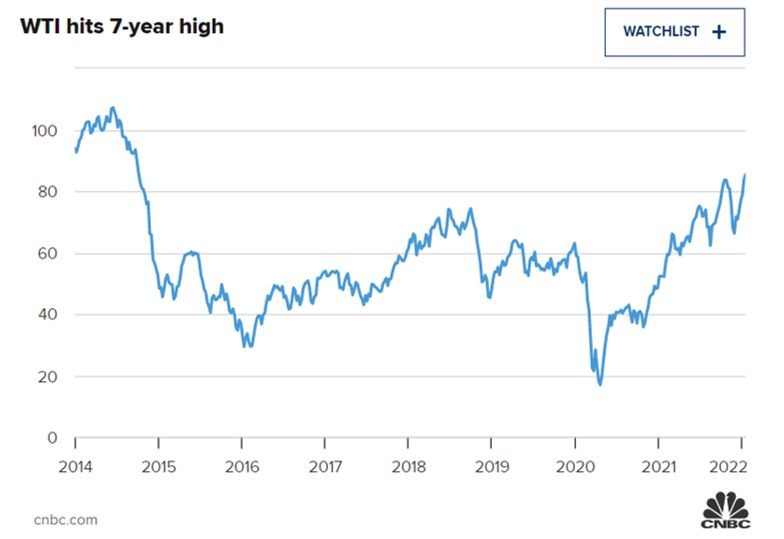
- 01/18/2022 – oil price to seven year high
Oil Prices Hit Seven-Year High on Rising Geopolitical Tensions – WSJ
Concerns over the Omicron variant and tensions in Europe and the Middle East are factors driving the rally
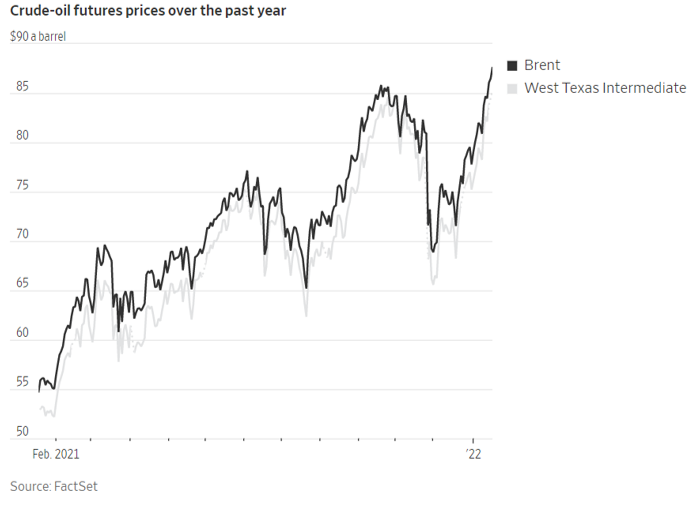
Among the factors driving the rally are concerns that tensions in the Middle East and Europe will spill into energy markets by denting supplies from major crude producers, particularly Russia and the United Arab Emirates. Any outages are likely to goose prices in a market where demand is rising and stockpiles have fallen below recent norms, traders and analysts say.
Adding to oil’s gains, the wave of infection caused by Omicron hasn’t reduced demand as much as traders thought it might when the variant was identified in late November. In a report published Tuesday, the Organization of the Petroleum Exporting Countries forecast that the world would consume 100.8 million barrels of oil a day this year, up 4.2 million barrels a day from 2021. The rise has been driven by rising demand for light distillates used in the petrochemical industry.
Investors are bidding up shares of energy companies, making the sector the best performer on the S&P 500 so far in 2022. Chevron Corp. has gained 9.9% and Exxon Mobil Corp. 17%.
- 01/17/2022 – to understand the history of oil price
World Oil Market and Oil Price Chronologies: 1970 – 2004
Oil Price History—Highs and Lows Since 1970
Crude Oil Prices: West Texas Intermediate (WTI) – Cushing, Oklahoma (DCOILWTICO) – FRED
OPEC vs. the US: Who Controls Oil Prices?
Stocks of Total Crude Oil and Petroleum Products (Including SPR)
- 01/17/2022 – history of Russia’s invasion of Crimea
THE RUSSIAN INVASION OF THE CRIMEAN PENINSULA, 2014–2015
A Post–Cold War Nuclear Crisis Case Study
Annexation of Crimea by the Russian Federation
Everything you need to know about the Ukraine crisis
By Max Fishermax@vox.com Sep 3, 2014, 11:01am EDT
- 01/17/2022 – study of Russia’s invasion of Crimea and oil price
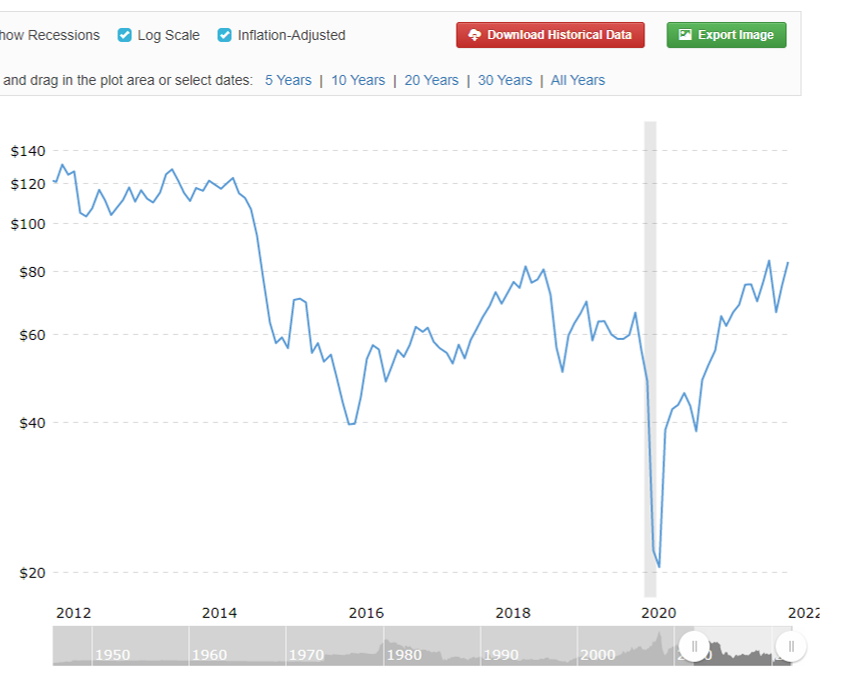

Why the Price of Crude Oil Dropped in 2015
- The year 2015 was a perfect storm for oil prices.
- The dollar was strong. Inventories were huge. The economy was weak. And production was growing.
- All of these factors drove the price of crude oil to less than $40 per barrel.
1. The Dollar Strengthens: In 2015, the dollar was at a 12-year high against the euro. The surge in the dollar in the second half of 2014 caused a rare sharp decline in all of the leading commodity indexes. Russia’s invasion of Crimea contributed the most to the $ strenghening.
2. OPEC Retains Production Levels. Prices of OPEC’s benchmark crude oil fell by a whopping 50% after the organization decided against cutting production at that 2014 meeting in Vienna.
OPEC, the cartel of oil producers that sets production levels, was unwilling to prop up the oil markets by cutting its production levels. The oil ministers said in a statement that they had “concurred that stable oil prices – at a level which did not affect global economic growth but which, at the same time, allowed producers to receive a decent income and to invest to meet future demand – were vital for world economic wellbeing.” Prices of OPEC’s benchmark crude oil fell by a whopping 50% after the organization decided against cutting production at that 2014 meeting in Vienna.
3. Global Inventory Grows: The prices of crude futures declined in late September 2015 when it became clear that oil stockpiles were growing amid increased production. The Energy Information Administration (EIA) reported that global oil inventories increased in every quarter of 2015, with a net inventory build of 1.72 million barrels per day. That was the highest rate since at least 1996. By the end of 2015, oil prices were below $40 per barrel, the lowest level since 2009.5. Total oil production by the end of 2015 was expected to increase to more than 9.35 million barrels per day—higher than previous forecasts of 9.3 million barrels per day.
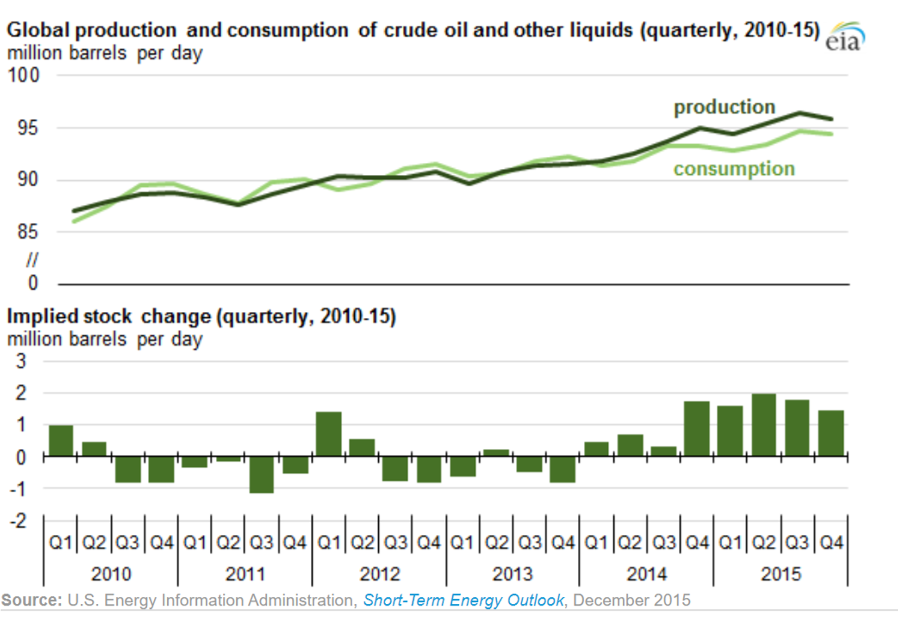
U.S. highlights for 2015: As a result of lower crude oil prices, U.S. crude oil production began to decline in the second quarter of 2015. The decrease was led by reductions in Lower 48 onshore production, which began to fall in April. Despite the decline, production of crude oil averaged an estimated 9.3 million barrels per day (b/d) in 2015, a 7% increase over 2014 and the highest rate since 1972.
International highlights for 2015: EIA estimates that total Organization of the Petroleum Exporting Countries (OPEC) crude oil and other liquids production increased 3% to 37.4 million b/d in 2015, led by production growth in Iraq. At its December 4 meeting, OPEC members announced they “should continue to closely monitor developments in the coming months,” indicating that OPEC producers, led by Saudi Arabia, are continuing the policy of supporting production and defending market share in a low oil price environment. On July 14, the Joint Comprehensive Plan of Action (JCPOA) between Iran and the five permanent members of the United Nations Security Council and Germany (P5+1) was announced. The agreement could lead to sanctions relief, contingent on verification by the International Atomic Energy Agency (IAEA) that Iran has complied with key nuclear-related steps.
4. The Economy Weakens: While the supply of oil became increasingly abundant in 2015, global demand for oil was decreasing. The economies of Europe and developing countries were weakening. Vehicles were becoming more fuel-efficient. Meanwhile, China’s devaluation of its own currency suggested that its economy might be weakening as well.6 Since China is the world’s largest oil importer, that was a huge hit to global demand and caused a negative reaction in crude oil prices.
5. Iran Makes a Deal: In July 2015, the U.S. and several other world powers signed a deal that lifted economic sanctions against Iran. The Iran nuclear deal, as it became known, freed Iran to start exporting oil again. Investors feared it would add to the world’s oversupply of oil, dragging down prices even more. (Iran withdrew from the agreement in 2019 after then-President Donald Trump ordered the killing of Iranian General Qasem Soleimani. President Joe Biden has indicated a willingness to see it reinstated.)
Some predictions in March 2014 on oil price
How the Situation in Crimea Could Cause Oil Prices to Fall
By Rory Johnston – Mar 04, 2014, 4:03 PM CS
Moscow’s aggression in Crimea has markets in a panic and bulls predicting continued increases in the price of oil should tensions endure. Nonetheless, there is a chance that Russia’s Ukrainian incursion could result in the exact opposite effect—a decline in oil prices. There are two different ways the Crimean crisis could result in decreased prices: a positive supply shock from the American strategic petroleum reserve (SPR) and a negative demand shock from financially crippled emerging markets.
Ukraine War Could Cause Huge Oil Price Spike
The question is how much a war between Russia and Ukraine would move oil prices higher. There is no formula to count it. However, the more violent the conflict, the more likely that the move upward would be sharp
Crude oil in the United States currently trades at about $102 a barrel. It has bounced between that level and $90 for a year. So far, the $100 price has not effected gas, oil, and petrochemical prices enough to dent the economies of the developed nations. If the 2008 oil spike, which pushed crude above $120 a barrel for about three months, is any indication, GDP among these countries could be hurt by much higher prices. The victims would range from drivers to transportation companies and airlines. And the ripple caused by high petrochemical prices, which effect a broad range of industries, is too large to calculate.
Much higher oil prices are on the way if the situation in Ukraine gets much worse. Global GDP, the recovery of which is still fragile, probably faces a new hurdle.
- 01/14/2022 -Watch out Russia’s possible invasion
The Putin Puzzle: Why Ukraine? Why Now? – WSJ
Even dictators have domestic political considerations, and Putin has a long history of using an aggressive foreign policy to bolster his standing in Russia. Putin may hope that provoking a diplomatic crisis will win back the popularity he saw when Russians rallied around the flag in 2014.
Russia Moves More Weaponry Toward Ukraine, Keeps the West Guessing – WSJ
Tanks, missile launchers and other materiel are seen being shifted westward from bases in the Russian Far East
White House Says Russia Planning ‘False Flag’ Operation as Pretext for Invading Ukraine – WSJ
Press secretary Jen Psaki says U.S. sees signs invasion could come in matter of weeks
Here’s what a Russian invasion of Ukraine would mean for markets (msn.com)
“If Russia invades Ukraine, the trade is buy TY,” wrote Brent Donnelly, president of Spectra Markets, in a Friday note, referring to 10-year Treasury-note futures. rally in Treasurys would pull down yields, which move in the opposite direction of prices.
- 01/13/2022 – watch out Russia’s move on Ukraine. If Russia invades, US$ will jump, oil price will crash. Is this a good entry point?
Russia warns it will sever ties with the US if it sanctions Putin over Ukraine crisis (yahoo.com)
A top Russian diplomat on Thursday suggested there was no point in continuing to hold dialogue, as European leaders warned of the potential for war. Some US officials and experts have expressed concerns that Moscow could use the failed diplomatic talks as a pretext for an invasion.
Russia Suggests Military Deployment to Venezuela, Cuba if Tensions With U.S. Remain High – WSJ
Deputy foreign minister says Moscow couldn’t exclude sending military infrastructure to the two countries
Turmoil in Russian markets intensified on Thursday, with the ruble depreciating as much as 2.6% against the dollar and trading at 76.5 rubles to $1. Russian stocks and bonds also came under pressure.
“The market has suddenly gone from ignoring this to taking it very seriously,” said Paul McNamara, an emerging-market debt fund manager at GAM.
- 01/13/2022 – Commodity Prices Surge in 2021
The Periodic Table of Commodity Returns (2012-2021)
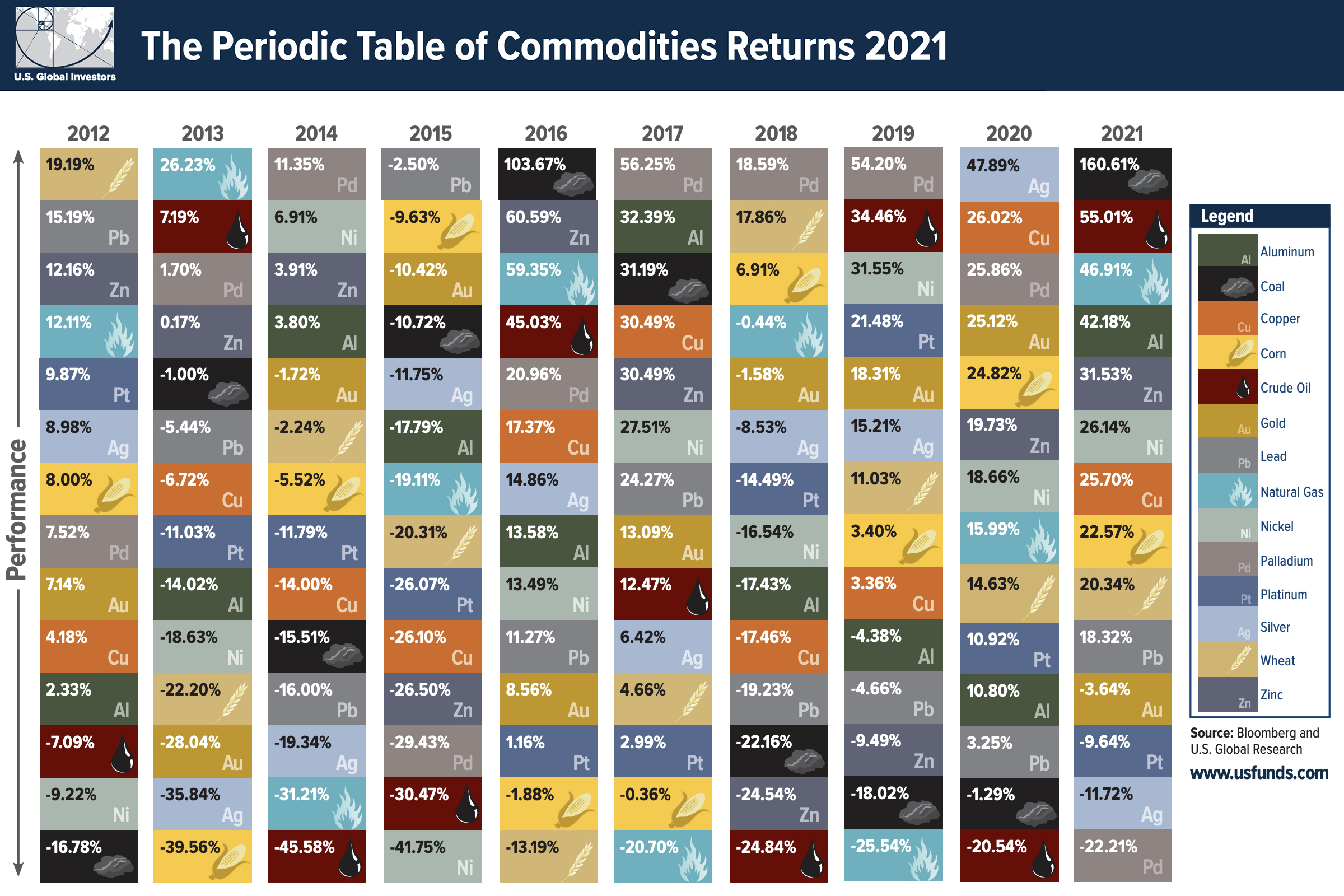
Commodity Prices Surge in 2021
After a strong performance from commodities (metals especially) in the year prior, 2021 was all about energy commodities.
The top three performers for 2021 were energy fuels, with coal providing the single best annual return of any commodity over the past 10 years at 160.6%. According to U.S. Global Investors, coal was also the least volatile commodity of 2021, meaning investors had a smooth ride as the fossil fuel surged in price.
| Commodity | 2021 Returns |
|---|---|
| Coal | 160.61% |
| Crude Oil | 55.01% |
| Gas | 46.91% |
| Aluminum | 42.18% |
| Zinc | 31.53% |
| Nickel | 26.14% |
| Copper | 25.70% |
| Corn | 22.57% |
| Wheat | 20.34% |
| Lead | 18.32% |
| Gold | -3.64% |
| Platinum | -9.64% |
| Silver | -11.72% |
| Palladium | -22.21% |
Source: U.S. Global Investors
The only commodities in the red this year were precious metals, which failed to stay positive despite rising inflation across goods and asset prices. Gold and silver had returns of -3.6% and -11.7% respectively, with platinum returning -9.6% and palladium, the worst performing commodity of 2021, at -22.2%.
- 01/10/2022 – Oil Eases as Kazakhstan Unrest Abates
Russian President Vladimir Putin Monday told the governments of former Soviet states they could count on Moscow to protect them against popular uprisings, as the capital of Kazakhstan seemed to be returning to near-normal after a week of unrest.
Kazakhstan is a major oil producer, with output at a current 1.6 million barrels a day. Crude prices were down slightly on Monday after increasing more than 5% in the course of last week.
- 01/10/2022 – Barron’s calling for $100 oil and one great comment from a viewer:
The real long term problem is that western economies have been generously funding oil exploration for nearly a century. This is now fundamentally changing with many western oil companies shifting investment to renewable energy and of course western banks less likely to continue lending for fossil fuel extraction projects. Then you have an industry that is heavily indebted. The western leaders have already told the fossil fuel industry you are going out of business in 30 years! So without the prospects of continued production or even growth, all of that debt is going to have to get paid off over that time period, further, investors who were happy to burn over $300B investing in US shale from 2015-2020 because they were rewarded with higher stock prices will now also want their money back and that is not just the $300B, that is also with interest. These are all major dynamics that are going to result in a massive under investment in oil and gas extraction over the next decades and keep OPEC in charge. OPEC will need even higher prices because they won’t be able to self finance without it if western banks stiff them.
Bets Are Rolling In Again for $100 Oil
There are several reasons for the resurgent bullishness. For one thing, oil prices and stocks have proven resilient over the past year. Unlike in previous years, producers have stayed disciplined, choosing not to ramp up drilling to take advantage of higher prices.
That outperformance, and a general sense that the energy transition will take time, has made “old energy” stocks “relevant again,” Bank of America analyst Doug Leggate wrote on Monday. He expects the stocks to regain their 5% weight in the S&P 500, down from a double-digit weighting more than a decade ago, but up from their 2% weighting at their lows in 2020.
And while the oil market faces both bullish and bearish risks, the bullish ones are more apparent today.
For instance, several geopolitical risks could force prices higher. Russia’s military buildup on the Ukraine border has major implications for oil and gas prices. If Russia invades, oil prices would almost certainly spike as countries around the world impose punitive sanctions on the country. Tran calls it “a buy now, ask questions later type of event risk for the oil market” and expects that an invasion would force average oil prices up $6.40 a barrel in the second quarter.
Production and exports are at risk in other countries also. Libyan production has declined recently after infrastructure was damaged. And it’s not clear if the U.S. and Iran will come to an agreement on a new nuclear deal and lift sanctions for oil exports. Analysts had been optimistic about a deal last year, but hopes have faded as talks stalled.
In general, there is increasing anxiety that supply is growing too slowly, and that OPEC doesn’t have enough spare capacity to send throughout the world if demand starts to exceed prepandemic levels. Tran doesn’t think OPEC and its allies (known as OPEC+) have been adding supply as quickly as the group had projected.
“OPEC+ remain steadfast in adding 400 kb/d back to the market each month, but our data suggests that monthly additions tally closer to 250 kb/d,” Tran wrote. “This amalgamates to 14 million missing barrels last quarter that were penciled into balances that have simply not shown up.”
More evidence of a supply shortfall would be extremely bullish for oil prices. The more that countries have to compete for every barrel of exports, the higher prices could go.
- 01/03/2022 – watch out the possible Iran production increase by the middle of 2023
How Iran Could Trigger The Next 10 Percent Drop In Oil Prices
- Iran announced plans last week to boost oil production from its supergiant South Azadegan oil field to at least 320,000 barrels per day
- The development of the West Karoun fields are instrumental to the 25-year deal between Iran and China
- The impact of additional Iran crude flows on global oil prices could be significant against a background of uncertain demand in the coming months
- Given ongoing high and steady sales of crude oil to China and other Asian countries and the likelihood of a new iteration of the Joint Comprehensive Plan of Action (JCPOA) being agreed with the U.S. at some point this year, Iran announced plans last week to boost oil production from its supergiant South Azadegan oil field to at least 320,000 barrels per day (bpd) by the middle of 2023, from the current 140,000 bpd.
- 01/03/2022 – The rising rate spread of the moment indicates greater liquidity is present than a few weeks ago. Events which turn into ‘Black Swans’ historically have had little long-term impact unless liquidity is low. At the moment liquidity is high and rising. On the horizon remains the likelihood that Russia will invade Ukraine and cause another shock to those not paying attention.
That sloshing sound is the Trillions globally pumped into markets…
“Davidson” submits:
Liquidity reigns! Liquidity as reflected in the T-Bill/10yr Treas rate spread has a long history(from 1953) of indicating the market’s ability(in fact it is investor ability to wait out market shocks) to adjust to major events. Rising rates and rising $WTI, reversing the declines beginning early Nov 2021 in response to multiple threats 1st Russia, followed by Omicron and lockdowns in Austria, Australia and etc., indicate investor psychology has recovered.
On the horizon remains the likelihood that Russia will invade Ukraine and cause another shock to those not paying attention. Russia invading Ukraine to some degree has already been absorbed into market thinking and not likely to be as significant as if it occurred unexpectedly. Nonetheless, it will still have an impact of unpredictable consequence even if expected but adequate liquidity is present to ease markets through it. The rising rate spread of the moment indicates greater liquidity is present than a few weeks ago. Events which turn into ‘Black Swans’ historically have had little long-term impact unless liquidity is low. At the moment liquidity is high and rising.
The S&P 500 Energy Index (NYSEARCA:XLE) finishes as the top sector performer for 2021, surging more than 47% after dragging along the bottom a year earlier with a 37% loss.
- 01/03/2022 – Oil demand might come back after Omicron. the chances of a revamped nuclear deal that lifts sanctions on Iranian oil exports appear to be fading. There are countries that simply don’t have spare capacity. One country that is struggling to pump oil: Nigeria, Africa’s largest supplier. but, Drilling activity in the U.S., however, is picking up. That, coupled with rising output in countries including Canada and Brazil, should sate demand for oil.
Omicron Blurs Oil Outlook After Demand Roars Back – WSJ
Traders grapple with fast-spreading coronavirus variant, long-run consumption questions
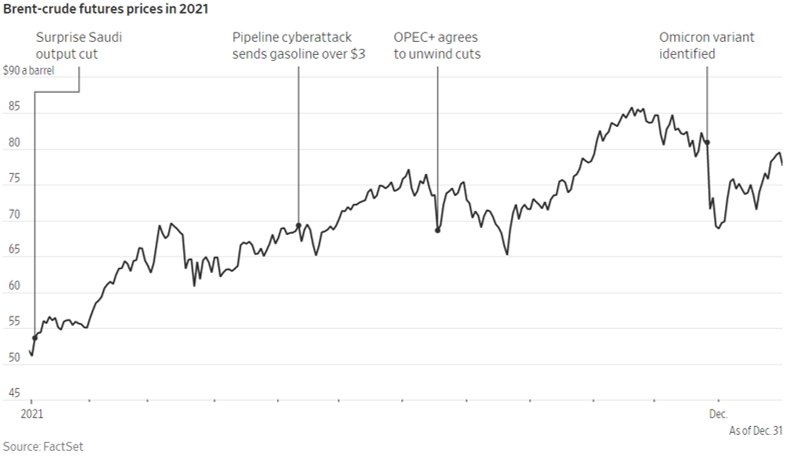
Crude prices had reached their highest levels since 2014 before governments restricted travel to stall Omicron in late November. They have seesawed since, leading traders to wrestle with two questions: Will Omicron knock oil off its upward trajectory? Or will demand resume its advance, perhaps testing the world’s ability to produce crude?
“We’ve learned that demand can come back with a vengeance,” said Francisco Blanch, head of commodities and derivatives research at Bank of America. He thinks Brent prices could reach $120 a barrel in 2022, barring a jump in Covid-19 hospitalizations or a major outbreak in China.
The longer-term path of demand for—and production of—fossil fuels is another unknown. World leaders in November reached a deal that aims to accelerate emission cuts. The IEA’s forecasts for oil demand over the next three decades hinge on the extent to which governments follow through on climate commitments.
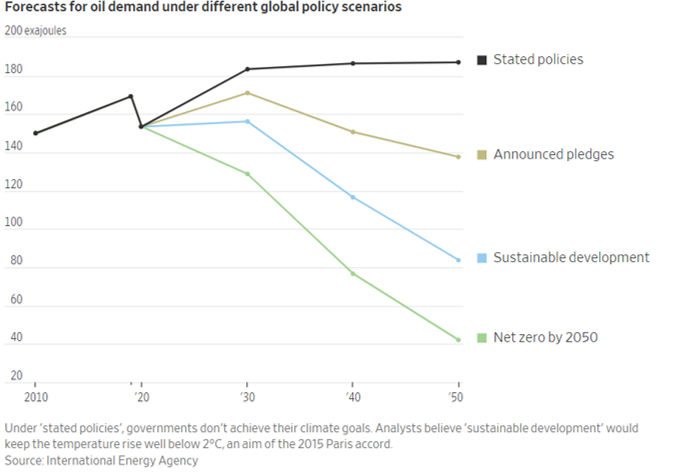
“There are countries that simply don’t have spare capacity,” said Amrita Sen, founding partner of consulting firm Energy Aspects. Meanwhile, she added, the chances of a revamped nuclear deal that lifts sanctions on Iranian oil exports appear to be fading.
One country that is struggling to pump oil: Nigeria, Africa’s largest supplier, whose crude plays an important role in balancing international markets. It produced 1.29 million barrels of crude a day in November, 360,000 barrels fewer than its OPEC quota, according to the IEA. The agency says operational problems, sabotage and pipeline leaks might hamper a recovery of output.
Drilling activity in the U.S., however, is picking up. Leading the way are private producers that have scooped up market share from publicly traded rivals under pressure from investors to deliver dividends instead of splashing money on wells. That, coupled with rising output in countries including Canada and Brazil, should sate demand for oil, said Edward Morse, head of commodities research at Citigroup. C
- 12/31/2022 – mostly good news for oil in 2022
Weekly oil supply / demand roundup — crude up ~$2.25 from Christmas Eve close
- This week saw another near-record inventory draw, as already low crude and oil product stocks fell by ~20mb in the US; inventories are now back to the 2010-2014 range when Brent crude (NYSEARCA:USO) (CO1:COM) prices averaged $100+ per barrel and global oil demand was substantially lower.

- This week China State-owned enterprise CNPC released their medium-term outlook for Chinese crude oil demand, indicating domestic consumption would peak in 2030 at ~15.8mb/d; a figure that is only ~1mb/d higher than current levels and below the IEA’s 2025 forecast.
- This relatively modest demand growth forecast includes the elimination of electric vehicle subsidies beginning in 2023.
- It was reported overnight that China has issued its first crude oil import quotas for 2022, allocating 109mt for 1H import, a reduction of nearly 11% or ~400kb/d yoy.
- Offsetting relatively bearish demand news out of China, Indian crude imports bounced 7.5% mom to 4.5mb/d; the best month for imports since Q1.
- Early reports this week suggest that Russian oil production was flat in December, and OPEC+ was only able to increase volumes by half their target, leading analysts to question OPEC’s ability to meet their production goals, ahead of next week’s meeting.
- Venezuela announced they’ve reached 1mb/d of production; however, analysts likely to remain skeptical until the official production figures are released by OPEC next week.
- And Shell (NYSE:RDS.A) announced that production of ~200kb/d at Forcados is back online, after going offline the preceding week.
- Libya announced the embattled Country’s loading schedule for January, cutting exports out of the Es Sider port by ~50kb/d versus November, suggesting militant activity following the postponement of Federal elections continues to weigh on production.
- On the Iranian front, UK and US diplomats complained about Iran’s weapons testing in violation of the JPCOA and slow negotiations; conversely, Iran indicated 80% of their demands have been met.
- Finally, a survey conducted by the Dallas Federal Reserve indicated that US producers are planning to get back to growth in 2022 (NYSE:XOM) (NYSE:CVX) (NYSEARCA:XOP) (NYSE:PXD) (NYSE:COP).
- Perhaps most importantly, oil has continued to move higher, as the Omicron-induced selloff subsides on the back of additional data showing relatively low levels of severity with the new strain.
- Since the black Friday selloff, oil has recovered all but 2% of its 15% drop, while oil equities (NYSEARCA:XLE) are down ~4% from when news of Omicron broke.
- Looking ahead to next week’s OPEC+ meeting and 2022, analysts will likely expect OPEC+ to stick to its script and a tight physical market paired with fewer covid restrictions to lift commodity prices in the new year.
- 12/23/2021 – the US crude storage level is at all time low, resulting in stocks below the 2010 to 2014 average, a period in which Brent oil prices averaged ~$100.
Weekly oil supply/demand roundup — crude up ~$2.5 from last Friday’s close
- This week saw another large oil/oil product inventory draw (NYSEARCA:USO) (CL1:COM) (CO1:COM), bringing the two-week total to ~27mb and resulting in stocks below the 2010 to 2014 average, a period in which Brent oil prices averaged ~$100.

- As the Euro energy crisis intensified, and began to encroach on the northeast United States, reports of fuel-oil burn in the power sector began to surface in France and elsewhere.
- Jet fuel demand in the US showed signs of life — TSA checkpoint throughput in 2021 has averaged 728k fewer passenger checks than 2019; however, the most recent reading from Tuesday showed only ~2k fewer passengers, relative to the same date in 2019.
- Some details surrounding Omicron came to light, and though the strain has been a major headwind to oil prices, reports indicate Omicron is more transmissible, but less severe than prior strains.
- After returning the Forcados terminal to operation approximately one month ago, Shell (NYSE:RDS.A) announced a force majeure at the Nigerian crude terminal this week, cutting off ~200kb/d of supply.
- News hit that militant forces shut down some of Libya’s largest onshore fields ahead of a planned national election, knocking ~300kb/d of production offline with no reports of a return to production since.
- Norwegian oil production for November came in ~90kb/d light versus the official Government forecast, and down ~90kb/d MoM.
- The White House announced plans for increased fuel efficiency standards beginning 2023.
- Rystad reported that oil exploration put up its worst year since the Second World War, as majors like Exxon (NYSE:XOM), Chevron (NYSE:CVX), BP (NYSE:BP), and Total (NYSE:TTE) cut budgets and retrench to short-cycle basins.
- 12/20/2021 – the US crude storage level is at all time low (even with SPR since what the administration failed to take into account was the fact that traders who got their hands on the release will likely just export it out for a profit.), and it is correspondent with average $100 oil price from 2010~2014.
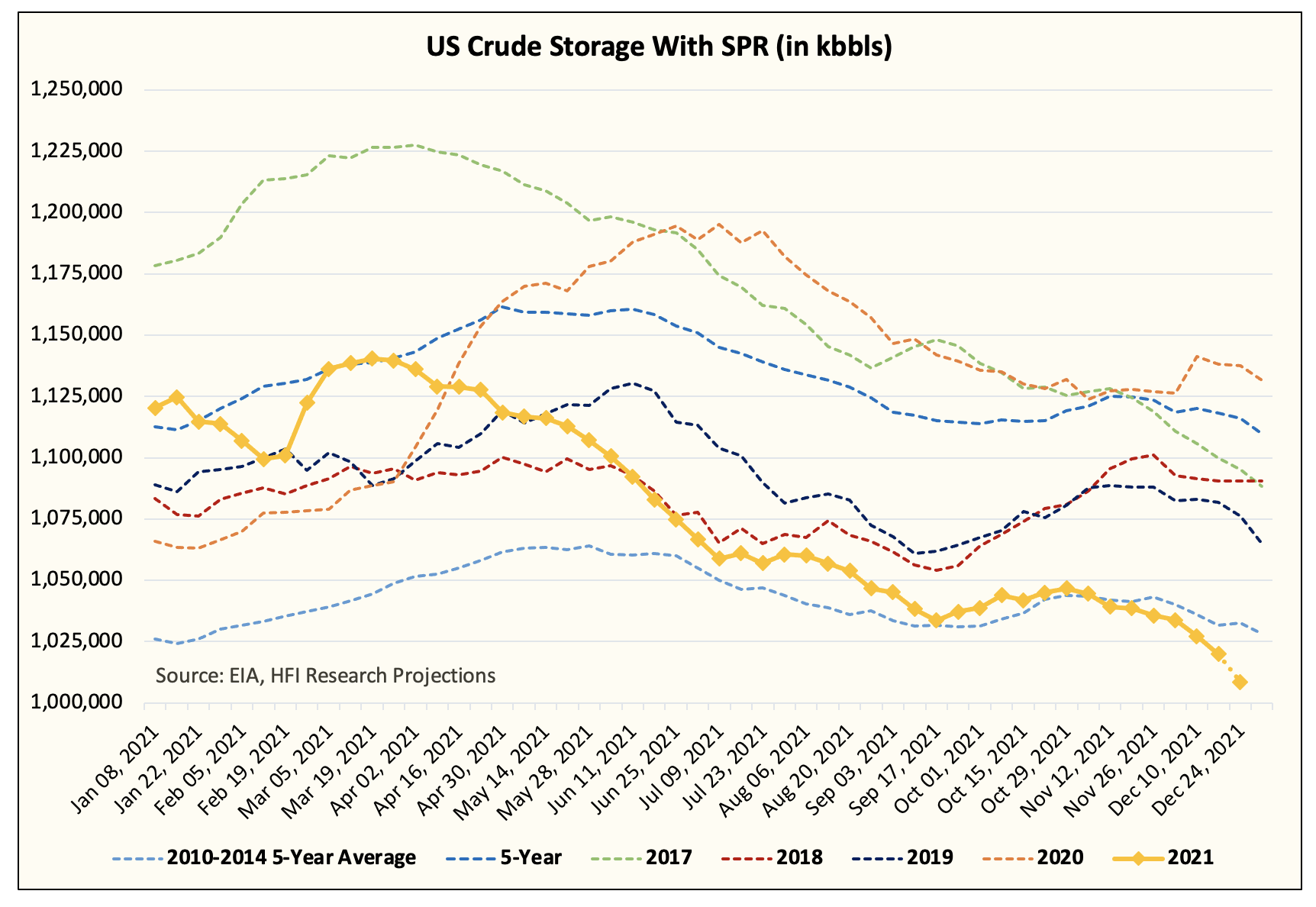
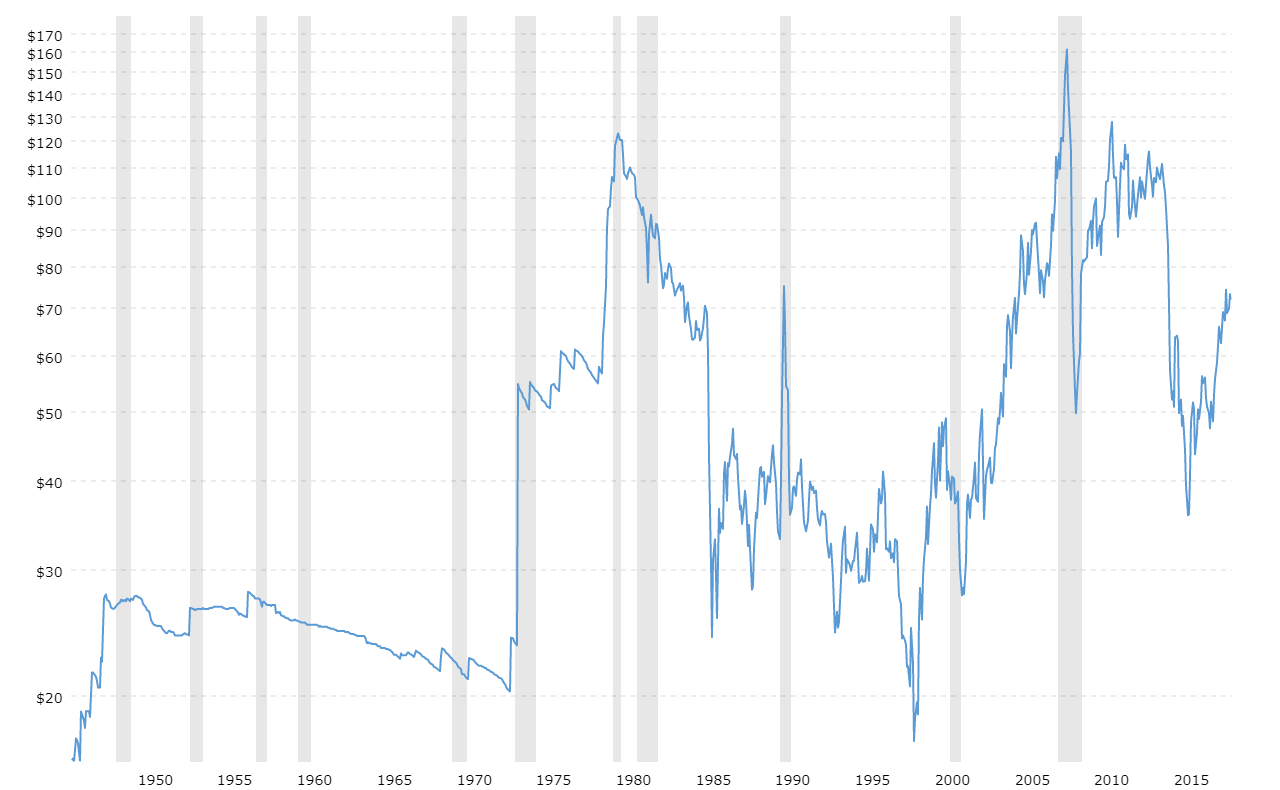
- 12/03/2021 – U.S. shale producers will be cautious in their spending plans for 2022 because of recent low prices. And while there’s slower growth in shale production, in the meantime, OPEC’s spare capacity will be reduced more quickly than if the group had decided to pause on output increases, Goldman said. That’s especially if there is no deal to allow more Iranian oil on the market next year. Goldman also said that while OPEC+ has often reiterated caution over the past year, Thursday’s decision is consistent with past decisions to add supply in a weaker demand environment. And it eases tensions with the U.S. administration, which coordinated the release of national stockpiles among major oil consuming countries last month after U.S. crude prices rose to a seven-year high.
Goldman sees oil upside next year in ongoing structural bull market
- Oil prices are primed for “substantial” gains going into H1 2022, as today’s decision by OPEC+ to proceed with planned production increases will not derail a fundamentally strong oil market, Goldman Sachs analysts say.
- Prices could “grind higher going into year-end, with real potential upside going into the first half of next year,” Jeff Currie, Goldman’s global head of commodities research, told Bloomberg today.
- The bank sees “very clear upside risks” to its forecast for the Brent benchmark to average $85/bbl in 2023.
- U.S. shale producers will be cautious in their spending plans for 2022 because of recent low prices, while OPEC’s spare capacity will be reduced more quickly than if the group had decided to pause on supply increases, Goldman says, adding that the also takes pressure off the Biden administration to cut a deal with Iran that would have added barrels next year.
- In the short term, Goldman says the oil market needs more information on the COVID-19 omicron variant for oil prices to start recovering above $80.
Goldman Sees Upside Oil Price Risk Despite OPEC+ Supply Decision
(Bloomberg) — Oil prices are primed for gains as Thursday’s decision by OPEC+ to proceed with planned production increases won’t derail an ongoing structural bull market, according to analysts at Goldman Sachs Group Inc.
The investment bank sees “very clear upside risks” to its forecast for Brent oil to average $85 a barrel in 2023.
U.S. shale producers will be cautious in their spending plans for 2022 because of recent low prices. And while there’s slower growth in shale production, in the meantime, OPEC’s spare capacity will be reduced more quickly than if the group had decided to pause on output increases, Goldman said. That’s especially if there is no deal to allow more Iranian oil on the market next year.
Recent price declines, amid concern that the omicron variant of coronavirus will damage demand, have been overdone and current prices offer “compelling opportunities” to reinvest, the Goldman analysts said. Brent crude futures dipped as low as $66 a barrel earlier Thursday, after the OPEC+ decision, and subsequently rebounded to $70 as the producer group kept the door open for further immediate adjustments, if needed.
In the short term, the oil market needs more information on the virulence of the latest coronavirus variant for oil prices to start recovering, and may need more evidence of a tight physical market to lift oil prices above $80, Goldman said.
- 12/02/2021 – OPEC spare capacity will drop and is lower than the cartel claims. The IEA said in its monthly oil market report that OPEC+ spare capacity could fall to below 4 million barrels per day (bpd) in the fourth quarter of 2022 from 9 million bpd in the first quarter of 2021. It forecast global demand at 99.6 million bpd in 2022, slightly above pre-pandemic levels. But it said OECD oil inventories could build again in 2022 and Iranian oil output, now limited by sanctions, could rise. The IEA said that, if Iranian sanctions were eased, the OPEC member could swiftly add 1.3 million bpd to global supply.
J.P. Morgan made headlines earlier in the week estimating OPEC spare capacity at half the level the cartel claims.
Falling spare oil capacity underscores need for more investment, IEA says
LONDON, Oct 14 (Reuters) – The world’s spare oil production capacity which helps smooth the market will fall by the end of 2022 as OPEC+ producers lift output, highlighting the need for more investment to meet rising crude demand, the International Energy Agency said on Thursday.
The IEA said in its monthly oil market report that OPEC+ spare capacity could fall to below 4 million barrels per day (bpd) in the fourth quarter of 2022 from 9 million bpd in the first quarter of 2021. It forecast global demand at 99.6 million bpd in 2022, slightly above pre-pandemic levels.
Spare capacity is an important cushion for the oil market as it allows producers to quickly respond to unplanned outages that could tighten the market and cause big fluctuations in prices.
Spare capacity will be concentrated in Middle East producers Saudi Arabia, the United Arab Emirates, Iraq and Kuwait, the IEA said, while Russia would be pumping flat out in the fourth quarter of 2022, based on capacity of 10.45 million bpd.
“Shrinking global spare capacity underscores the need for increased investments to meet demand further down the road,” it said, after the demand cratered during the pandemic, prompting many producers to push back or scrap plans to add capacity.
The IEA defines spare capacity as production that can be tapped within 90 days and sustained for an extended period.
Others use different definitions. The U.S. Energy Information Administration sees OPEC spare capacity at 5.11 million bpd in the fourth quarter of 2022, based on output that can start up in 30 days and be sustained for at least 90 days.
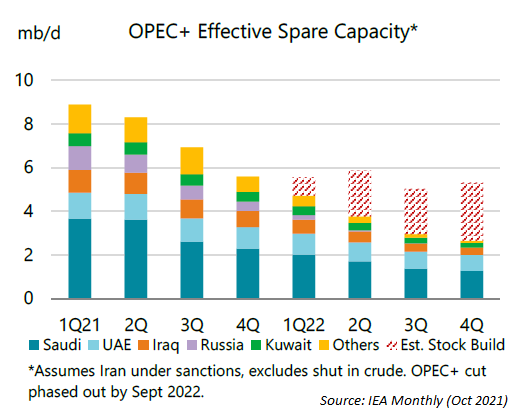
Spare capacity becomes increasingly important with crude inventories shrinking as OPEC+ continues with its output cuts.
The IEA said oil stocks would continue to slide as OPEC+ was on track to pump 700,000 bpd below the call for its crude.
But it said OECD oil inventories could build again in 2022 and Iranian oil output, now limited by sanctions, could rise.
It said inventories could build by 800,000 bpd in the first quarter of 2022, 2.1 million bpd in the second quarter of next year and 2.4 million bpd in the second half of 2022.
The IEA said that, if Iranian sanctions were eased, the OPEC member could swiftly add 1.3 million bpd to global supply.
- OPEC’s control over the supply of oil will catapult prices to $150 a barrel in 2023, JPMorgan said in a Monday note.
- “We believe OPEC+ will defend the oil price with paced volume growth to keep inventories low,” JPMorgan said.
- The bank doesn’t see the new Omicron variant of COVID-19 putting a dent into demand for oil.
- Oil prices could climb higher despite U.S.-led efforts to rein them in by releasing millions of barrels kept as strategic reserves, Stephen Schork, editor of the Schork Report, told CNBC.
- Oil prices have jumped more than 50% this year, with demand outstripping supply as more countries emerge from national lockdowns and severe restrictions imposed since last year due to the coronavirus pandemic.
- Eurasia Group analysts warned prior to Biden’s announcement that a large-scale stock release by oil consumers before the next OPEC+ meeting may prompt a countermove by the group, resulting in a “disruptive standoff.”
- 11/19/2021 – OPEC+ under produces to enjoy the profit of relatively high oil price, why not?
OPEC+ Pumped Less Oil Than Agreed In October
The OPEC+ group’s compliance rate with the oil production cuts rose to 116 percent in October from 115 percent in September, as the alliance, especially the OPEC members in the pact, failed to pump to their collective quota, Reuters reported on Friday, quoting internal data it had seen.
The ten OPEC members bound by the pact complied with their total share of the cuts at a massive 121 percent in October, up from a 115 percent compliance rate in September. The non-OPEC oil producers in the OPEC+ agreement saw their compliance fall to 106 percent last month, down from 114 percent in the previous month, according to the data seen by Reuters.
The monthly OPEC report already showed last week that the cartel’s ten members in the OPEC+ agreement continued to struggle with reaching their collective ceiling.
OPEC’s crude oil production rose by 217,000 barrels per day (bpd) to 27.453 million bpd in October, but still fell short of the cartel’s share of the 400,000-bpd total output hike of the OPEC+ group.
Under the OPEC+ deal, the ten OPEC members bound by the OPEC+ pact should be raising their combined production by 254,000 bpd each month.
- 11/19/2021 – the real reason that Big Oil won’t raise production is a matter of simple economics. oil explorers in the United States are making more money now than at any other point in the more-than decade-long history of the nation’s shale revolution. “And this may just be the beginning,” Bloomberg Markets reported this week. “Free cash flow, the key metric watched by investors, probably will increase by 38% next year, presuming oil prices remain elevated.”
The Real Reason Big Oil Is Refusing To Boost Production
- A stand-off between President Joe Biden and oil and gas producers in the Permian Basin is developing as prices continue to climb.
- President Biden has accused the oil and gas industry of potentially “illegal conduct” as oil execs get rich off of soaring oil prices and has called for a federal investigation into the matter.
- Drillers are still holding off on increasing output in other basins as they continue to enjoy sky-high profits while looking to avoid another “boom and bust” cycle which has crippled the industry in the past.
the real reason that Big Oil won’t raise production is a matter of simple economics. Keeping the supply tight is just too good for the bottom line. And if it’s President Biden who will take the heat for high prices at the pumps, that’s just the cherry on top of a very, very lucrative cake. In fact, according to figures from Deloitte LLP, oil explorers in the United States are making more money now than at any other point in the more-than decade-long history of the nation’s shale revolution. “And this may just be the beginning,” Bloomberg Markets reported this week. “Free cash flow, the key metric watched by investors, probably will increase by 38% next year, presuming oil prices remain elevated.”
This kind of restraint is a new development for the shale industry, and it is clearly paying off. Historically, the Permian Basin has been unable to resist a “drill, baby, drill” mentality when oil prices are high, ultimately flooding the market and deflating prices. This would then be followed up by a period of production cuts and austerity measures until oil prices recovered, and then companies would buck production caps and the process would start all over again in an amazingly predictable boom and bust cycle.
But no longer. “After effectively subsidizing consumers through the 2010s with break-neck drilling that depressed global oil prices, the shale industry appears to have struck a winning formula: moderating production, limiting reinvestment in new wells and shaving debt,” Bloomberg writes. As such, U.S. shale is digging its heels in and refusing to pump despite any amount of begging and pleading from the White House. Despite the fact that global energy demand has bounced back to pre-pandemic levels, U.S. oil production has stubbornly remained 12% lower than they were in February 2020, right before the impact of the pandemic was felt around the world. This represents a huge volume of supply — a 12% contraction is the equivalent of nixing the entire oil output of the Gulf of Mexico.
Ironically, the Permian is now poised to increase production to its highest levels on record and is projected to hit 4.95 million barrels a day this December, but the ramp-up won’t be nearly enough to close the 12% production gap. Drillers are still holding off on increasing output in other basins as they continue to enjoy sky-high profits and look toward a potential global oil glut in the next year if too much production is ramped up too quickly in the immediate term, ultimately bringing them back to that classic boom-and-bust cycle that they’re almost managed to break out of.
- 11/19/2021 – I need to watch out the CV-19 re-surge
Stock Market Today: November 19, 2021
Before The Bell – Stocks futures are pointing to a mixed opening this morning on news of a spike in coronavirus cases in Europe. Investors appear to be shuffling their portfolios in response, with a rotation into the technology sector.
figure does not take into account the chance that the coronavirus will hinder the comeback in business conditions, as was the case in September, when the surging Delta variant caused scheduled returns to offices to be pushed back.
The chance that the economy might not reopen as quickly or fully as expected seemed to weigh on the performance of several sectors, including financials, industrials, and energy-related shares.
Energy stocks were also weighed down by a dip in oil prices, which are falling further this morning. The concern is that travel will be stifled by another wave of coronavirus cases, this time centered in Europe. Austria has announced vaccine mandates, and the number of Covid-19 cases in Germany is reported to be surging.
More broadly, the uptick in infections is dampening sentiment toward travel-related stocks and bringing so-called stay-at-home stocks back into favor. This trend might not prove as pronounced as it was in 2020, but it could nonetheless persist until the number of cases starts moving down again. –
- 11/19/2021 – Autralia lockdown. oil prices look more likely than a day ago to slide toward the mid-$70s, especially if Germany announces similar measures. Dr. Fauci said Europe’s CV re-surge might be caused by their too early loosen up at mask and vaccine mandate
Oil, energy stocks slammed as Austria’s COVID lockdown rattles markets
- Energy stocks (NYSEARCA:XLE) are poised to open with sharp losses as crude oil futures fall ~3% following increased fears of a COVID-19 resurgence in Europe.
- Austria will become the first Western European country to impose restrictions, and Germany may soon follow.
- “The market still remains fundamentally in a good position but lockdowns are now an obvious risk to this if other countries follow Austria’s lead,” OANDA analyst Craig Erlam tells MarketWatch, adding that oil prices look more likely than a day ago to slide toward the mid-$70s, especially if Germany announces similar measures.
- WTI prices fell yesterday to their lowest levels in six weeks.
Dr. Fauci says Covid cases are starting to climb in some areas of the U.S
- Fauci’s comments came just a day after the country reported a seven-day average of more than 82,000 new cases, up 11% from the week before.
- Nationwide cases were down 57% last week from the delta wave’s peak this summer, but an influx of Covid patients in the Midwest and Northeast are fueling the sudden increase.
- Cases and hospitalizations have fallen sharply in the South, where the delta wave hit earliest and hardest over the summer.
Oil prices fall 4% to six-week low on lockdown worries, but don’t expect much relief at the pump yet
- Oil prices fell to a six-week low on Friday amid demand fears after Austria announced a nationwide lockdown.
- Crude is on track for a fourth straight week of losses for the first time in more than a year.
- The Biden Administration is looking at ways to alleviate the surge in gas prices, with consumers paying the most at the pump in seven years.
- 11/17/2021 – Davidson thinks should current supply/demand trends continue, his guest is for higher prices than forecast with fear of an upward inflation spiral.
We do not do “price predictions” here but the supply/demand equation without questions supports prices higher than the $80/bbl we are currently seeing….
Toss in any type of significant geopolitical event involving the Middle East, China, or Russia, and all bets are off
“Davidson” submits:
EIA sees rising crude inventories and falling gasoline prices the next 3mos https://www.eia.gov/outlooks/steo/. The media report falling $WTI is in response to this forecast but the data does not support this conclusion by my analysis. A few analysts predict $WTI to rise to $120/BBL. My guess, should current supply/demand trends continue, is for higher prices than forecast with fear of an upward inflation spiral.
- US Crude Prod falls 0.1mil BBL/Day to 11.4mil, Crude Imports fall 0.5mil BBL/Day, US Crude Inv falls 2.1mil BBL, SPR falls 3.2mil BBL, Refining Input steady at 15.4mil BBL/Day
- US Consumption remains on trend, Refined Prod Export drop back a little as domestic consumption dominates export with drop In US Gasoline Inv of 1.8mil BBL
The supply/demand imbalance continues to worsen. With US Crude Production holding just above 11mil BBL/Day, drops in US Crude Inv(working inventory) and the Strategic Petroleum Reserve(SPR) of 3.2mil BBL and a drop in US Crude Imports of 0.5mil BBL/Day(~3.5mil BBL/week) continues a tightening pattern to supply. EIA proclaimed a global inventory stabilization, but this is in working inventories with no ref4erences to the rapid drop in strategic reserves. US Refined Prod Consumption is holding above the 2012 trend. Jet Fuel shows a small decline and matches the TSA traffic pattern i.e., no surge in International travel with reported reversal of travel restrictions.
The imbalance between production and consumption continues to widen but is being missed by many whose primary focus is on the levels of working inventory that sees declines offset by SPR releases. It is important to note that Refining Inputs remain unchanged and US Gasoline inventories have fallen when they should be rising to accommodate the Spring maintenance/catalyst change over in Feb/Mar. Not only is there a crude oil deficit building out sight but the same appears in gasoline.
Oil is a consumable and vital to the economic lifeblood. Inflationary pressures and perceptions of tight supply have always proven a formula for price spikes not previously imagined.
- 11/11/2021 – Be aware of the Russia’s plot
Blinken says US is concerned Russia may be ‘attempting to rehash’ 2014 invasion of Ukraine
Kuleba indicated that finding a diplomatic way out could be difficult. Pointing to various Russian efforts to destabilize Europe — including its coercive use of energy supplies, “propaganda efforts, disinformation, cyberattacks, military buildups, an attempt of Russia to digest Belarus” — the Ukrainian diplomat warned that “in this complicated game, we have to remain vigilant, we have, have to be resilient.”
The joint press appearance is just the latest effort by the Biden administration to demonstrate support for Ukraine, some of which has happened behind closed doors.
US warns Europe that Russia may invade Ukraine
The United States has warned European Union allies that Russia may be weighing a potential invasion of Ukraine, according to reports.
“Our concern is that Russia may make the serious mistake of attempting to rehash what it undertook back in 2014 when it amassed forces along the border, crossed into sovereign Ukrainian territory and did so claiming falsely that it was provoked.
“Our commitment to Ukraine’s sovereignty, to its independence, to its territorial integrity is iron-clad, and the international community will see through any Russian effort to resort to its previous tactics.”
Ukraine has been ensnared in a deadly war with pro-Moscow separatists in its largely Russian-speaking east since 2014 when Russia seized the Crimea peninsula.
Russia took action after mass protests led to the ousting of the president who had suspended efforts to move closer to the European Union.
Russia in March also amassed 100,000 troops on Ukraine’s borders. It pulled back, but both Ukraine and the United States said at the time that the withdrawal was limited.
- 11/11/2021 – lots of themes make the stock market volatile. Remember in 2014, the actions of Russia, a noticeable threat today, caused the US$ to soar and elevated $WTI to plunge as algorithms traded for recession.(see Nominal US$…vs $WTI chart) The SP500 fell ~100pts but no recession. $WTI, which was at a speculative level Feb 2014, fell from $107/BBL to the low $40/BBL 12mos later. The last 10days indicates a reaction to Russia’s troops massing adjacent to Ukraine. It appears new capital forced US$ higher and 10yr Treas rates lower on this news. Lower rates are one of the algorithmic triggers for economic weakness which results in selling $WTI as a portfolio hedge. While volatility is unsettling, as long as the rate spread is above 0.2% and especially when the spread is widening, as it is currently, equity markets have a history of shaking off negatives and working higher. Reopening continues.
Markets May Become Increasingly “Messy”
“Davidson” submits:
At any point in time, markets are messy. The current environment is particularly messy with Russia and China seeking to take advantage while the rest of the world is focused on the nasty politics playing out in the US. The US, the historic guarantor of Democracy globally, appears deep in the throws of self-doubt. Confusion is the tool of those seeking to exert greater political and economic control. The phrase “Never let a good crisis go to waste” is well known. Everyone has a personal agenda or a ‘sales pitch’ with truth of any situation buried in noise. Manipulative activity at a high pitch dominates social and major news media. That this makes one’s head spin is an understatement.
The themes currently:
- COVID lockdown/vaccinations or reopening-to mask or not to mask?
- Economic correction or reopening?
- What is government policy and what is the net impact?
- Are rates rising or falling?
- Is oil rising or falling?
- Is inflation temporary or not?
- Is there and will there be Global Warming/Green New Deal or not?
- Should government control of innovation and climate actions or not?
- Is Russia/China on the verge of another maneuver for power, wealth and global control?
- How much does computer algorithms/inexperienced investors trading on price-trends distort market psychology?
- Is Bitcoin is the new ‘gold’, the new ‘global currency’ or not?
- Add to this list at your leisure, so many to choose from…
Each has its own narrative. Each narrative carries its own market psychology which ebbs and flows sometimes in sync and then out of sync with the others with periods of being additive and alternating periods of cancellation complicated by how much importance investors attribute to each at any point in time. In the last 10days, Russia suddenly comes to the fore as on the verge of invading Ukraine. https://www.wsj.com/articles/russia-biden-next-foreign-policy-test-ukraine-border-crimea-11636057131 If Russia invades Ukraine, will China then advance on Taiwan? In 2014, the Erdogan of Turkey, Xi of China and Putin of Russia each moved to advance their autocracies driving global capital to Western markets seeking safe havens. The same is occurring today. The narrative here is a rising US$, rates falling and pricey real estate as EmgMkt capital invests for preservation of capital in currencies not their own. This can be seen as currency exchange rates respond to geopolitics followed by price shifts of sovereign debt and real estate. To weave this narrative one must pay attention to the numerous local reports over the years of money flooding into various Western real estate markets from large to small cities coupled with the timing of sovereign debt rates falling below zero and connecting the dots with geopolitics. This is EmgMkt capital with a focus more on preservation of capital than a return on capital. It is capital with less equity experience in Western markets which takes years to develop. It should be no surprise that one foreign investor who made many millions on Bitcoin turned around and paid $69mill for NFT artwork and believed it ‘cheap’. https://www.theverge.com/2021/3/11/22325054/beeple-christies-nft-sale-cost-everydays-69-million Experienced Value Investors see ‘Tulip Mania’.
The argument is emerging that COVID lockdown was a crisis blown out of proportion. The misinformation surrounding COVID is infused with political agenda and the actual facts may take years to rise to the surface. As investors, one had to make decisions during the lockdown and now must do the same on the reopening. There is no doubt that the economy is reopening. It is how it is reopening that matters and what impact government policies are likely to have going forward. The reopening theme has been coupled to rising rates and rising oil prices. But, capital pooling in Western markets force rates lower. It is a push/pull of investor sentiments with differing cultural perceptions. In 2014, the actions of Russia, a noticeable threat today, caused the US$ to soar and elevated $WTI to plunge as algorithms traded for recession.(see Nominal US$…vs $WTI chart) The SP500 fell ~100pts but no recession. $WTI, which was at a speculative level Feb 2014, fell from $107/BBL to the low $40/BBL 12mos later. The US$ gained ~15% against global currencies including Advanced and EmgMkts. Since then, as autocrats have gained power in EmgMkts, the US$ has continued to strengthen vs EmgMkts to 30% higher than levels of 2014. This inflow represents considerable capital pushing US rates lower. Countering this is the fundamentally based Western Value investor who perceives economic growth as the COVID reopening develops. These investors are shifting capital out of debt and into equity attracted by higher returns. Added to this mix are the Momentum Investors using price-trends and trading algorithms. Lately, the presence of another type of Momentum Investor, those who have learned to play videogames, who are responsible for the price action of Gamestop(GME) and AMCEntertinment(AMC) coordinating their activity using social media platforms. They favor price-trends but have developed trading consortiums to coordinate trading activity with heavy reliance on the theme of the day and little regard to fundamentals.
The last 10days indicates a reaction to Russia’s troops massing adjacent to Ukraine. It appears new capital forced US$ higher and 10yr Treas rates lower on this news. Lower rates are one of the algorithmic triggers for economic weakness which results in selling $WTI as a portfolio hedge. Yesterday, 10yr Treas rose ~0.15(15bps). A massive reversal in my opinion. If Russia does invade Ukraine, it will not prove a surprise and the rise in rates appears to counter this fear with greater optimism of economic growth. The Russia did surprise in 2014, but the 10yr Treas/T-Bill rate spread was ~2.5% at that time. The equity market correction was short lived. The rate spread is another input for algorithms and it offset the negative signal from the rising US$ at the time. Today, the rate spread is ~1.5-1.6% and positive for higher equity prices. In my opinion, negative geopolitical events are likely to have short lived impact as long as economic trends continue to favor equities. Should China move against Taiwan, which is not a strong factor in investor consideration currently, a reassessment would be required.
The reopening theme has slowed having already regained the bulk of economic activity the past 18mos. Employment in travel and leisure venues remain less than pre-COVID levels but continue to improve. The elimination of most international travel restrictions earlier this week has yet to impact air travel even though the stories are positive. Air travel remains ~20% below historic seasonal levels. The TSA chart was reformatted to show current activity vs year ago levels with 10day trends overlaid with historical annual July peak level and Sept annual low level trends from 2012.
At any point in the economic cycle there are always multiple issues positive and negative. There are periods the positive issues dominate only to see concern arise on new threats to growth from unexpected sources. While volatility is unsettling, as long as the rate spread is above 0.2% and especially when the spread is widening, as it is currently, equity markets have a history of shaking off negatives and working higher. Reopening continues.
- 11/07/2021 – Good for airline companies and energy companies
The U.S. is about to lift a nearly 20-month international travel ban. Here’s what you need to know
- The U.S. on Monday will lift a pandemic travel ban on international visitors from more than 30 countries after 19 months.
- New rules will replace the ban, requiring international visitors to show proof of vaccination and a recent negative Covid test.
- Exceptions include travelers under age 18 and those traveling from countries with low vaccine availability.
United Airlines said it expects 50% more international inbound passengers on Monday from a week earlier, when it carried 20,000 people. Delta Air Lines said it expects many of its international flights on Monday to be full and strong demand in the next few weeks. Airfare-tracking site Hopper said international flight searches to the U.S. have more than quadrupled since the Biden administration in September announced it would lift the restrictions.
Airlines have brought back more international flights, though schedules are still below pre-pandemic levels. United airline will fly 69% of its 2019 international schedule next month, up from 63% this month and its trans-Atlantic schedule will be 87% restored in December. American Airlines’ international capacity for November and December is set to be more than double that of a year ago and down 28% from 2019.
- 10/29/2021 – Under existing plans, Chevron aims to spend as much as $3 billion a year on repurchases.
Chevron Eyes More Buybacks After Record Cash Flow
Chevron said Friday that third-quarter profit excluding one-time items was $2.96 per share, which surpassed every analyst’s estimate compiled by Bloomberg. Earnings were so strong that the driller’s net-debt-to-capital ratio has fallen below its target of 20% to 25%, a key threshold that could spur an increase in stock repurchases, Chief Financial Officer Pierre Breber said.
Chevron shares rose 2.1% to $115.50 in pre-market trading.
“We’re fast approaching a net-debt ratio where we could increase our buyback guidance range even further,” Breber said in an interview.
Chevron also reduced its full-year capital-budget target to $12 billion to $13 billion from $14 billion, citing pandemic-related project deferrals and reduced costs in the Permian Basin.
Free cash flow of $6.7 billion in the quarter allowed Chevron to fund a dividend that’s among the top 10 in the S&P 500 Index, and reduce debt. But the company bought back just $625 million of shares in the period, the mid-point of its targeted range.
Under existing plans, the company aims to spend as much as $3 billion a year on repurchases.
The company’s executives will begin a conference call with analysts at 11 a.m. New York time.
- 10/29/2021 -Oil companies are trimming capital expenditures while boosting shareholder returns. That could come back to bite
Exxon Mobil’s Strategy: Be a Lean, Mean Cash Machine – WSJ
Oil companies are trimming capital expenditures while boosting shareholder returns. That could come back to bite.
Thanks to increasing energy prices, oil producers hit a financial gusher last quarter. Exxon’s cash flow from operations in the third quarter was $12.1 billion, the highest since the third quarter of 2014, when Brent crude oil was trading closer to $100 a barrel. Its peer Chevron CVX +0.80% reported $8.6 billion of cash flow from operations and record free cash flow on Friday.
For its part, Exxon raised its quarterly dividend on Wednesday, maintaining its status as a dividend aristocrat. On Friday it announced the resumption of share buybacks starting next year; the company expects to repurchase up to $10 billion over a year or two. That is still modest compared with historical levels: In its heyday, Exxon used to return roughly $30 billion a year through buybacks.
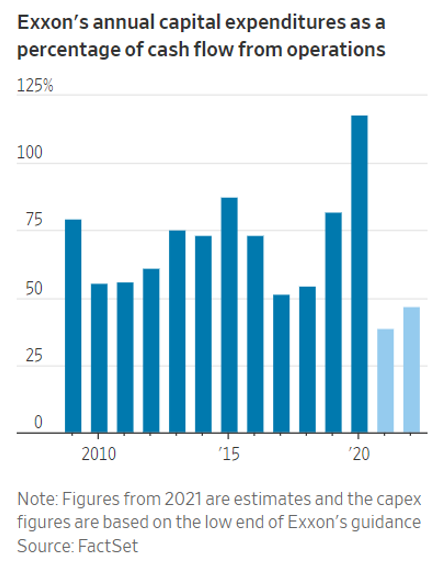
Immediate cash returns are enticing, but long-term investors will want to pay attention to Exxon’s future spending plans, which the company plans to unveil in December after a meeting with its reconstituted board (including those activist investor Engine No. 1 nominated in May). More cash returned to shareholders today means less available for spending tomorrow. On Friday’s earnings call, Exxon stuck to its disciplined $20 billion to $25 billion annual capital spending guidance and increased its investment target for low-carbon projects, effectively committing 10% to 12.5% of its annual budget on such projects, which include some moonshot technologies such as hydrogen and carbon capture. That is a sizable step-up from the previous 2.4% to 3% range. It also means Exxon is ready to redirect substantial sums away from oil and gas production, which is a depletion business. The company was already behind some of its peers in long-term investments in recent years.
- 10/29/2021 – Big oil companies are generating their biggest cash flows in years and heeding investor calls to return it to shareholders instead of using it to drill. Unlike their European peers, U.S. oil companies are largely not diversifying into renewable energy. Two largest oil companies Exxon (10 billion share buyback program starting next year) Chevron (it generated $6.7 billion in free cash flow, its most ever). Though oil prices are up around 60% on the year, 50 of the largest oil companies have only increased their annual budgets by 1%, according to Raymond James. The companies initially budgeted $271 billion and that has only ticked up to $275 billion, the financial firm said in a note to investors.
Exxon, Chevron Amass Cash as Oil Tops $80 a Barrel – WSJ
Large oil companies are reporting the strongest quarterly revenue since before the start of the pandemic and pulling back on spending.
The two largest U.S. oil companies, Exxon Mobil Corp. XOM +0.26% and Chevron Corp. CVX +0.85% , reported on Friday their most profitable quarterly earnings since before the onset of the global pandemic. Exxon reported earnings of $6.8 billion, its best quarterly performance since 2017, and said it would launch a $10 billion share buyback program starting next year. Chevron reported $6 billion in net income, its best quarter since 2013, and said it generated $6.7 billion in free cash flow, its most ever.
Exxon raised its quarterly dividend on Wednesday by 1 cent, its first such increase since 2019, and said Friday it generated $12 billion in cash from operations. Chevron said Friday that its year-to-date capital spending is down 22% and it paid dividends of $2.6 billion, reduced debt by $5.6 billion, and repurchased $625 million of shares during the quarter.
European energy companies are also raking in cash but say they will continue to use more of it to fund renewable-energy projects and investor payouts than growing oil and gas production.
TotalEnergies SE reported $4.6 billion in profit Thursday and said that strong cash generation from fossil fuels is enabling it to invest in growing its renewable-energy and electricity businesses. Royal Dutch Shell PLC, which is facing calls by activist investor Third Point LLC to split into two companies, reported a loss of $447 million Thursday, after writing off $5.2 billion linked to commodity derivatives. But the Anglo-Dutch giant said it produced $16 billion in free cash flow, its most ever, and would distribute $7 billion to shareholders from the $9.5 billion sale of its shale assets in the Permian basin to ConocoPhillips in September. BP PLC reports earnings next week.
Though oil prices are up around 60% on the year, 50 of the largest oil companies have only increased their annual budgets by 1%, according to Raymond James. The companies initially budgeted $271 billion and that has only ticked up to $275 billion, the financial firm said in a note to investors.
While most producers appear to be abiding by investors’ wishes for now, questions linger for some about how they will spend their money beyond that. Unlike their European peers, U.S. oil companies are largely not diversifying into renewable energy.
Both Chevron and Exxon created low-carbon business units this year that will primarily focus on biofuels, hydrogen production, carbon capture and other technologies. Chevron tripled its planned investment in its unit in September, saying it would spend $10 billion through 2028. Exxon increased its low-carbon spending Friday, saying it would invest $15 billion on such projects from 2022 through 2027.
But the increased green investment still represents a fraction of what the companies are spending on oil and gas projects, and it is unclear how profitable the units will be for the foreseeable future. Many of the technologies they are investing in will need further government subsidies to be economic.
Exxon has said it would keep production roughly flat. On Friday, it said quarterly production increased 4% from the same period last year. Pierre Breber, its chief financial officer, said in an interview that the company’s production was up 7% in the quarter compared with the same period last year and will increase 3% annually through 2025.
- 10/28/2021 – need to read details of this news on Shell
Third Point Has Big Shell Stake, Urges Energy Giant to Break Up – WSJ
- 10/19/2021 – the thirsty for money is the main reason poor countries are very hard (and politically impossible) to collaborate with rich countries on climate change actions
To Strike a Climate Deal, Poor Nations Say They Need Trillions From Rich Ones – WSJ
Industrialized countries were already struggling to pay earlier commitments to help with clean-energy development and other infrastructure needs. Now the cost of buying cooperation has skyrocketed.
At a July global climate gathering in London, South African environment minister Barbara Creecy presented the world’s wealthiest countries with a bill: more than $750 billion annually to pay for poorer nations to shift away from fossil fuels and protect themselves from global warming.
The number was met with silence from U.S. Climate Envoy John Kerry, according to Zaheer Fakir, an adviser to Ms. Creecy. Other Western officials said they weren’t ready to discuss such a huge sum.
- 10/12/2021 – news to read
Volatile energy markets are here to stay, IEA warns- to watch Todd’s podcast on oil play
IEA says clean energy progress remains ‘far too slow’
- 10/06/2021 https://contrarianpod.substack.com/p/season-3-ep-23-the-long-term-bull
New episode is live for premium subscribers!@ToddSullivan joins the podcast to discuss how investors can take advantage of his long-term bullish outlook for oilhttps://t.co/SXai48Ne1Z pic.twitter.com/2Zgt3zZp5o
— Contrarian Investor Media (@PodContrarian) October 5, 2021
- 10/06/2021 – Delta variant might be end by Thanksgiving according to Dr. Gottlieb. we’re going to be entering the more endemic phase. Seasonal flu is one example of an endemic virus.
Dr. Gottlieb sees Covid’s ‘pandemic phase’ ending when antiviral pills, kids’ vaccines available
- Dr. Scott Gottlieb expects the coronavirus’ “pandemic phase” to be over in the U.S. once vaccines become available for young children and Merck’s antiviral pill is cleared by regulators.
- “I think those two things are going to be the bookend on the pandemic phase of this virus and we’re going to be entering the more endemic phase,” the former FDA chief said Wednesday.
Dr. Scott Gottlieb said Wednesday he expects the coronavirus’ “pandemic phase” to be over in the U.S. once vaccines become available for children and Merck’s antiviral pill is cleared by regulators.
The other crucial development is for the highly transmissible Covid delta variant to have “moved through the country,” which is likely conclude around Thanksgiving, Gottlieb told CNBC
“On the back end of that, we’re going to have, hopefully, a vaccine available for children and, at some point before the end of the year, we probably will have the orally available drug from Merck if things go well and that undergoes a favorable review,” said Gottlieb, a former Food and Drug Administration commissioner who now serves on the board of Covid vaccine maker Pfizer, which is also working on an antiviral pill.
“I think those two things are going to be the bookend on the pandemic phase of this virus and we’re going to be entering the more endemic phase, when this becomes an omnipresent risk but don’t represent the extreme risk that it represents right now,” Gottlieb said.
Seasonal flu is one example of an endemic virus.
- 10/06/2021 – Oil supply crunch makes US to consider release emergency oil reserves
US considering releasing emergency oil reserves to lower gas prices, Granholm says
US gas prices surged to $3.21 per gallon this week, marking the highest cost in seven years
The Biden administration is mulling a release of emergency oil reserves as one of several options to ease a global energy crisis that has resulted in surging prices for consumers, U.S. Energy Secretary Jennifer Granholm said on Wednesday.
Cartel and Russia-led group had previously said they would add about 400,000 barrels a day each month through next year
- 09/30/2021 – China’s energy crisis might force oil price to go higher
Crude oil pops as Bloomberg reports China seeking energy supplies ‘at all cost’
- Crude oil reverses higher following a Bloomberg report that China’s government has ordered state-owned energy companies to secure supplies for winter at all costs.
- WTI November crude (CL1:COM) +1.2% at $75.72/bbl after trading lower by as much as 2.3% earlier in the session, which would put the benchmark in position to close at a new three-year high and a sixth straight weekly increase; November Brent (CO1:COM) roughly flat at $78.59/bbl.
- The Chinese government order came directly from Vice Premier Han Zheng, who supervises the country’s energy sector and industrial production, following an emergency meeting, according to the Bloomberg report.
- China is in the grips of a severe energy crisis, and several regions have been forced to cut power to the industrial sector.
- U.S. crude is poised to gain nearly 10% this month, helped by strong demand and constrained supply in the U.S. Gulf of Mexico.
- 09/29/2021 – BofA is reiterating its view that U.S. oil/gas companies are still in the early part of an “extended” cyclical rebound with echoes of the mid-2000s. And while valuations have recovered from lows of last year, only a few of the companies are higher vs. their pre-COVID-19 levels. Only two names among large-cap exploration/production companies have outperformed the broader market in that span. Its analysis suggests the sector is discounting long-term WTI oil prices around $50/bbl, “substantially” below the forward curve.
BofA tackles U.S. oil cash use debate: Buybacks or dividends?
- BofA is reiterating its view that U.S. oil/gas companies are still in the early part of an “extended” cyclical rebound with echoes of the mid-2000s.
- “Last year may seem like an eternity ago,” the bank says, but it’s the first of a “multiyear reset.”
- And while valuations have recovered from lows of last year, only a few of the companies are higher vs. their pre-COVID-19 levels. Only two names among large-cap exploration/production companies have outperformed the broader market in that span, it notes – Hess (NYSE:HES) and Devon Energy (NYSE:DVN) – but their path upward has been highly volatile, with 50%-plus drops in 2020: “For most investors, durable exposure simply may not be worth the effort!”
- Why is that? “The culprit exposed by our valuation framework is a steeply backwardated oil curve that has capped valuations for the simple reason that the conditions necessary to lift the long end of the curve are not yet in place – namely a post-COVID recovery in demand,” BofA says.
- Its analysis suggests the sector is discounting long-term WTI oil prices around $50/bbl, “substantially” below the forward curve.
- And value is backstopped by strong free cash flows, it says: yields around 19% in 2022, normalizing at around 13% by 2024. (Some outliers on the high side: Apache (NASDAQ:APA) is at 32% FCF yield, and Occidental (NYSE:OXY) at 34%, though both have no oil hedging.)
- 09/27/2021 – Sept 30 or Oct. 01 – there might be some volatility in the market for potential government shutdown, and technical debt default – might be another opportunity for getting back in
A Government Shutdown Is Looming. What It Means for the Stock Market
“It’s normal for the market to sort of take a breather and be a little bit nervous ahead of a shutdown,” said Charles Lemonides, chief investment officer of New York hedge fund firm ValueWorks.
Unless Congress passes a funding bill by Sept. 30, the federal government will face its first shutdown during the pandemic, and the fifth over the span of a decade.
In the 14 shutdowns since 1980, the S&P 500 posted a median return of -0.1% the day the budget was set to expire, 0.1% during the shutdown periods, and 0.3% on the day the shutdown was resolved, according to Kostin.
Wall Street Breakfast: Debt Ceiling And Default
The deadline in the debt ceiling showdown in Washington approaches, with a government shutdown possible on Friday, Oct. 1. Democrats in the House have passed a bill that would avert a shutdown and suspend the debt ceiling temporarily, but that will go nowhere in the Senate without support from some Republicans.
- 09/27/2021 – EU is shutting down oil/gas production for green energy, then demand hits the oil/gas price – The European Union taxes carbon emissions to discourage use of fossil fuels and has promoted renewable sources of energy to replace them. Some countries have also targeted production. Denmark has committed to stop pumping oil and gas by 2050. The Netherlands is shutting down its vast field, near the town of Groningen, amid public pressure over earthquakes attributed to it.
Europe Is Pumping Less Gas as Demand Rebounds, Leaving a Gap Russia Is Filling – WSJ
Natural-gas supply shortfalls have led to record prices for the fuel and for electricity, stoking fears of a shortage
The European Union taxes carbon emissions to discourage use of fossil fuels and has promoted renewable sources of energy to replace them. Some countries have also targeted production. Denmark has committed to stop pumping oil and gas by 2050. The Netherlands is shutting down its vast field, near the town of Groningen, amid public pressure over earthquakes attributed to it.
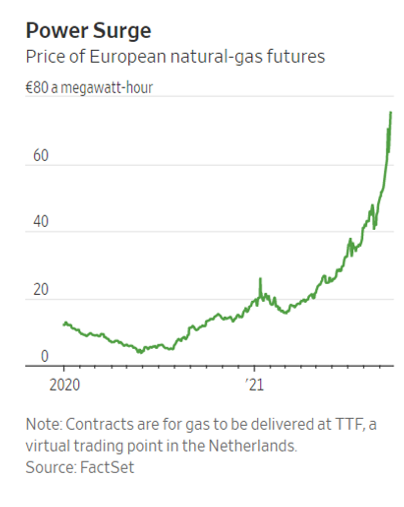
Dutch production cutbacks have left a hole in European output just as demand returns from lockdown-induced lows. Futures contracts for gas to be delivered in the Netherlands fetched €71.69 a megawatt-hour, equivalent to just under $84 a megawatt-hour, on Wednesday. That was close to their highest level on figures dating back to 2013 and more than six times their price from a year ago. Adding to the upward pressure, American oil-and-gas producers have held back, and droughts in places such as Brazil have curtailed hydropower, prompting a dash to burn gas.
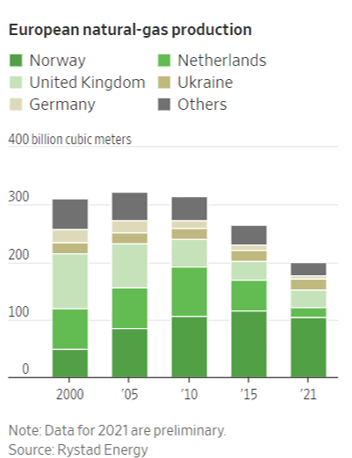
- 09/26/2021 – US might be back to normal within one year
- “Within a year I think we will be able to come back to normal life,” Pfizer CEO Albert Bourla said in an interview on ABC’s “This Week” on Sunday.
- Bourla said “the most likely scenario” is the need for annual coronavirus vaccine shots.
- 09/26/2021 – oil price tends to reverse to mean once increases too fast. Higher rate will strengthen dollar, and reduce oil price
McGlone notes that the last two major declines in crude (2018 and 2020) were almost tick-for-tick with the S&P 500. The 20-quarter correlation between the Bloomberg Commodity Spot Index and the S&P 500 currently sits at 0.90, the highest reading since 1960. The BI analyst says the last time the correlation peaked was back in 2013, which was followed by the spectacular oil price crash of 2014, which then spread to the rest of the commodities complex.
“Now, there is a risk of WTI reverting back to its mean since 2014, which would mean a drop to around $50 a barrel,” McGlone reckons.
McGlone says there’s another bearish catalyst working against oil prices: Supply elasticity due to technological advancement.
“Five years ago, it cost about $50 to extract a barrel of shale crude, now it’s closer to $30. Businesses have adjusted to Covid-19, as evidenced in our chart showing S&P 500 Ebit at a record high. If equity prices fall or earnings stall, the highly correlated commodity market risks a drop with greater velocity,” McGlone wrote.
With the Fed set to start paring bond purchases as soon as November and hike interest rates in response to rising inflation, the dollar appears poised for an upward trajectory, which could be bad news for oil prices and other commodities.
- 09/26/2021 – warning from Burry on too much options in the market
Individuals Embrace Options Trading, Turbocharging Stock Markets
Short-term traders flock to the low upfront cost and potential quick gains in options markets, fueling bigger swings and many rallies
By one measure, options activity is on track to surpass activity in the stock market for the first time ever. In 2021, the daily average notional value of traded single-stock options has exceeded $432 billion, compared with $404 billion of stocks, according to calculations by Cboe’s Henry Schwartz. This would be the first year on record that the value of options changing hands surpassed that of stocks, according to Cboe data going back to 2008.
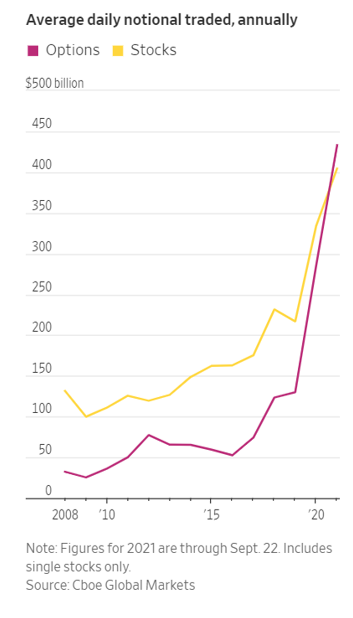
- 09/26/2021 – supply chain delays cause 1/3 of BP stations in UK out of fuel
Nearly one-third of BP stations in UK almost out of fuel
Nearly one-third of British Petroleum’s (BP) stations in the United Kingdom are almost out of fuel, as the oil company is seeing an increase in demand.
BP told The Hill in a statement that supply chain delays, triggered by a shortage of qualified drivers, are causing the company to experience “supply issues” at some of its facilities in the UK.
The company said it has seen an “intense demand” in the past two days, leading to a fuel shortage at roughly 30 percent of its stations in the UK.
- 09/25/2021 -no new lockdowns in Europe, robust recovery in China road activity, and the U.S. nixing its ban on foreign travelers from November 2021, all lift prospects for upside in the coming quarters. wild cards: US and Iran’s nuclear talk, OPEC meeting next month to possibly increase production; customers do not use oil once price is too high
Oil and Oil Stocks Are on a New Bull Run
International oil prices hit new three-year highs on Thursday and kept climbing Friday, as demand has improved and supply shortages persist in some areas. Production outages from Hurricane Ida have continued a month after the hurricane made landfall, with nearly 300,000 daily barrels of oil still offline.
And demand is on the rise, too, as international travel restrictions are starting to be loosened. The international Energy Agency’s latest oil update forecast that “strong pent-up demand and continued progress in vaccination programs should underpin a robust rebound from the fourth quarter of 2021.” And OPEC recently raised its demand forecast for 2022.
“Looking at oil demand, no new lockdowns in Europe, robust recovery in China road activity, and the U.S. nixing its ban on foreign travelers from November 2021, all lift prospects for upside in the coming quarters,” wrote Rystad Energy analyst Louise Dickson.
There are other signs that supply will remain weak as demand rises. While President Biden said at the United Nations this week that he is open to restarting the nuclear deal with Iran, the state of that deal — and Iran’s substantial oil production — is still up in the air. Iran’s president was sharply critical of the U.S. when he spoke at the U.N., noted RBC Capital Markets analyst Helima Croft.
There are at least two wild cards that could reverse the recent momentum. OPEC meets next month and could decide to boost production to curb price gains and maintain market share. And high prices could start causing consumers to reduce oil use.
Crude oil prices could rise to $80 per barrel by the end of this year and even top it, Vitol Group’s chief executive Russell Hardy told Bloomberg in an interview.
According to Hardy, the gas supply crunch will spur demand for alternatives, lifting crude oil demand up by an additional half a million barrels daily in the fourth quarter. This, in turn, could motivate a higher supply increase on the part of OPEC+, the executive also said.
“Can demand surprise us to the upside because of power switching? Yes,” Vitol’s CEO said. “Is it likely that there’s half a million barrels a day of extra demand that comes through because of gas pricing? Probably our view is, that is likely across winter.”
According to Vitol peer Trafigura, furthermore, oil is set to continue rising next year as well. The chief economist of the commodity trading major said that Brent could jump to $100 by the end of 2022, driven by the continued recovery in global demand.
“Not just the price, but the level of backwardation we are seeing is telling us the market is hungry for oil,” Saad Rahim said during the virtual Argus Asia-Pacific Crude Forum on Thursday.
- 09/22/2021 – Cheap Solar panels are most likely still from China, tariff will drive up the cost significantly, history repeats?
Solar companies say new tariff proposal would devastate the industry
- The Solar Energy Industries Association is urging the Department of Commerce not to implement tariffs on solar imports from Malaysia, Vietnam and Thailand.
- The U.S. imports 80% of its panels from the three countries, according to SEIA.
- The industry trade association said new tariffs would cost the industry 18 gigawatts of new solar installations by 2023.
- In August an anonymous group filed a petition with the Department of Commerce seeking new tariffs.
The Solar Energy Industries Association said Wednesday that implementing tariffs on panels and cells from Malaysia, Vietnam and Thailand, which account for 80% of the U.S.′ panel imports, would have a “catastrophic impact” on the industry.
In a letter to Commerce Secretary Gina Raimondo, more than 190 U.S. solar companies urged the Department of Commerce not to initiate a trade investigation.
Wednesday’s letter comes after several companies filed an anonymous petition with the Department of Commerce in August alleging that China-based solar cell and module manufacturers are avoiding U.S. tariffs by moving production out of the country. The Department is expected to decide by the end of the month whether to open an investigation.
- 09/21/2021 – Despite the higher production, OPEC was actually pumping at some 10 percent below its overall quota for the 10 members bound by the OPEC+ pact in August, due to outages and technical difficulties in countries such as Nigeria and Angola
OPEC+ Boosts Compliance With Oil Production Cuts To 116%
The OPEC+ group of producers raised their compliance with the ongoing collective production cuts to 116 percent in August, up from 109 percent compliance in July, sources from the alliance told Reuters on Tuesday.
The OPEC cartel saw its crude oil production rise by 150,000 barrels per day (bpd) in August, data from secondary sources in the monthly report showed. Even at higher quotas, the 10 OPEC members part of the OPEC+ pact pumped less than estimated by tanker tracking surveys and less than the OPEC overall quota in the agreement.
Total crude oil production from all 13 OPEC members averaged 26.76 million bpd in August, according to secondary sources OPEC cited in its closely watched Monthly Oil Market Report (MOMR) last week. The August production was 150,000 bpd higher than the July crude output, as the OPEC+ alliance returns more barrels to the market as per the latest deal reached in July.
Despite the higher production, OPEC was actually pumping at some 10 percent below its overall quota for the 10 members bound by the OPEC+ pact in August, due to outages and technical difficulties in countries such as Nigeria and Angola, Bloomberg noted earlier this month.
- China, Japan and South Korea will spend an estimated $12.4 trillion to achieve net-zero carbon emissions in their transport systems, according to an ING report.
- Achieving net-zero carbon emissions in China’s transportations sector could cost $11 trillion, or “1.8% of GDP per year through to 2060.”
- China’s marine industry would require the most investments to be entirely zero carbon, with the demand for sea freight is estimated to be around 120% of today’s levels by 2060.
- 09/20/2021 – Solar shares fall due to China RE worries and rising raw material costs. EV stocks hammered amid China woes too
Solar shares fall by most in four months on China real estate worries
- Solar names are among many sectors feeling the heat from growing contagion fears of a potential debt default at Chinese property developer Evergrande Group, with the Invesco Solar ETF (TAN -5.8%) falling as much as 6.5%, the most since early May.
- A recent report from the Solar Energy Industries Association and Wood Mackenzie said supply chain bottlenecks and rising raw materials costs caused U.S. solar prices to rise Q/Q and Y/Y during Q2 across every U.S. market segment.
- 09/20/2021 – airline travel will ramp up because the travel restriction relaxed. the percentage of fully vaccinated adults in the EU was 71.8% as of Monday, compared with 65.7% of fully vaccinated adults in the U.S., according to the U.S. Centers for Disease Control and Prevention.
U.S. to Relax Covid-19 Travel Restrictions as Tensions Mount With Allies – WSJ
New rules requiring foreign travelers to show proof of vaccination follow pressure on President Biden from Europe, major airlines to lift bans
The Biden administration is easing a series of Covid-19 travel bans and will require foreign nationals seeking to fly to the U.S. to show proof of vaccination under new rules aimed in part at assuaging mounting frustration among European allies.
The new restrictions would replace a series of travel bans imposed during the Trump administration that limit travel into the U.S. from Europe, China, Iran and Brazil, and were later expanded to include South Africa and India. President Biden has been under pressure from European politicians and major airlines to lift the restrictions.
According to the European Center for Disease Prevention and Control, the percentage of fully vaccinated adults in the EU was 71.8% as of Monday, compared with 65.7% of fully vaccinated adults in the U.S., according to the U.S. Centers for Disease Control and Prevention.
- 09/20/2021 – FDA-approved Covid vaccine for kids ages 5 to 11 ‘very feasible’ by Halloween, says former FDA commissioner. Also, if vaccine campaign goes fine, we might not have another CV-19 wave
- Pfizer and BioNTech’s Covid vaccine is safe and appears to generate a robust immune response in a clinical trial of kids 5 to 11, the drugmakers announced.
- “Those findings are very promising, especially around the ability of a very small dose, leading to a very strong immune reaction,” said former FDA Commissioner Dr. Mark McClellan.
- “It is going to be a thorough process at the FDA,” McClellan said. “They look at all the actual data, replicate the studies that are reported.”
- 09/20/2021 – “Typically the best-performing sectors in one decade become the worst in the following decade, and vice versa,” Mr. Stovall says. “Since energy was the best in the 2000s but the worst this [past] decade, maybe the 2020s will be its day in the sun.” But energy, and funds that follow it, are trapped in a set of conundrums that make the sector’s potential for a rebound a tricky question. On the positive side, energy shares have gotten cheaper: The S&P 500 Energy subindex trades at only about 0.4 times book value, half of 2008’s level and a third below 2016. “You might get a five-year sweet spot,”
The Case for Energy Stocks – WSJ
The ‘Dogs of the Dow’ rule holds that the worst stocks usually turn around. If that applies to sectors, and the funds that track them, then energy shares will benefit
It’s one of Wall Street’s best-known maxims: The “Dogs of the Dow” principle, holding that Dow Jones Industrial Average companies whose stocks underperform the broad market in a given year but are basically healthy typically will bounce back and maybe even outperform the market the next year. And it generally holds true.
But does a similar rule apply to sectors of the S&P 500, and sector-based mutual funds and exchange-traded funds? Inquiring energy investors, in particular, may want to know.
The answer is, kind of,
“Typically the best-performing sectors in one decade become the worst in the following decade, and vice versa,” Mr. Stovall says. “Since energy was the best in the 2000s but the worst this [past] decade, maybe the 2020s will be its day in the sun.”
But energy, and funds that follow it, are trapped in a set of conundrums that make the sector’s potential for a rebound a tricky question. On the positive side, energy shares have gotten cheaper: The S&P 500 Energy subindex trades at only about 0.4 times book value, half of 2008’s level and a third below 2016, according to Bank of America Merrill Lynch. That argues for a rebound. However, financial stocks are significantly cheaper on the basis of price-to-earnings ratio, so they may be more attractive to value investors.
Many challenges
One scenario is that there may be a window between the time when big energy companies fix their existing problems like oversupply of natural gas, allowing for returns to rise, and the time when long-term issues like the rise of electric vehicles threaten demand growth for petroleum and pressure energy-related shares anew. Any investors hoping for a rebound could be rewarded in that window.
“You might get a five-year sweet spot,” Mr. Glickman says.
- 09/16/2021 – Mr. Yergin thinks oil and natural gas will continue to be important parts of the energy mix for quite a long time. But it’s going to be a very different mix. Renewables will be a much bigger part of it. Maybe it will be hydrogen or another thing. So it won’t be an oil age—it will be an energy mix age. He thinks oil industry is becoming investible again. There was this exuberance a month or two ago that prices would go to $100 a barrel. We were skeptical unless there was a real crisis of some kind. It seems that prices are probably in the $60 to $80 range. What we did see before the shadow of Delta fell across the land was that demand was coming back much stronger than many people expected. Oil demand rose about seven million barrels a day from the first quarter to the third quarter of this year. The world’s going to continue to use a lot of oil for some time. There will be some investors who want nothing to do with the industry. But for others who see that the returns are there, and they’re consistent, they will be very interested in those returns as part of their portfolios. As long as we don’t have another big virus-driven downturn, or some big crisis in U.S.-Chinese relations that shapes the world economy, these companies are going to be much more focused on paying down debt and returning money to investors than they have in the past. Mr. Yergin thinks the investor pressures are quite considerable, and the investors are not going to come back in large numbers until they’re convinced that there are really adequate returns on a consistent basis.- good book to read: The New Map: Energy, Climate, and the Clash of Nations
How the Energy Market Is Changing. Oil’s Oracle, Daniel Yergin, Describes the New Dynamics.
Daniel Yergin has written some of the most influential books on energy, while advising companies and governments on policy and markets. He is now vice chairman at IHS Markit. His latest book, The New Map: Energy, Climate, and the Clash of Nations, looks at how the politics of oil have changed in the past two decades, with the boom in U.S. shale and the rise of China.
Barron’s: You’ve written about the oil age, which has lasted for over 150 years. Is it over now?
Daniel Yergin: I’ve been thinking about it going back to my fourth book, The Prize. The assumption was that demand would always just grow, or when it peaked, it would be so far into the future it wasn’t worth thinking about. And that oil had a permanent monopoly on transportation. None of that is true anymore. I think oil and natural gas will continue to be important parts of the energy mix for quite a long time. But it’s going to be a very different mix. Renewables will be a much bigger part of it. Maybe it will be hydrogen or another thing. So it won’t be an oil age—it will be an energy mix age.
The oil industry has had booms and busts for decades. Prices go up, drilling rises. Prices go down, drilling slows down. Now, U.S. oil companies are doing something new—they’re holding back on producing oil even as the price rises. They say they’re going to be more disciplined, no more “drill, baby, drill.” Do you think that holds?
I think it is holding, because we are now seeing the second shale revolution. It’s the revolution in the relationship between investors and companies. It’s no longer growth at any cost. You have to return money to investors and rebuild confidence to bring investors back into the field. I think it’s unlikely that we’re going to see irrational exuberance as we’ve seen in previous periods. I think the investor pressures are quite considerable, and the investors are not going to come back in large numbers until they’re convinced that there are really adequate returns on a consistent basis.
Do you think that the industry is investible now? The stocks are up a lot from last year, but have flatlined in the past few months.
I think they’re becoming investible again. There was this exuberance a month or two ago that prices would go to $100 a barrel. We were skeptical unless there was a real crisis of some kind. It seems that prices are probably in the $60 to $80 range. What we did see before the shadow of Delta fell across the land was that demand was coming back much stronger than many people expected. Oil demand rose about seven million barrels a day from the first quarter to the third quarter of this year. The world’s going to continue to use a lot of oil for some time.
There will be some investors who want nothing to do with the industry. But for others who see that the returns are there, and they’re consistent, they will be very interested in those returns as part of their portfolios. As long as we don’t have another big virus-driven downturn, or some big crisis in U.S.-Chinese relations that shapes the world economy, these companies are going to be much more focused on paying down debt and returning money to investors than they have in the past.
How does oil play into that?
The relationship between Russia and China that was formerly based on Marx and Lenin is now based on oil and gas. Russia has become an important supplier to China, and with the development of liquefied natural gas, or LNG, in the north, it can be an even more important supplier. That’s a very conscious strategy for those countries to kind of hitch their wagons together from an energy point of view.
All of these new dynamics, including the U.S. shale boom, are also changing things in the Middle East.
It really struck me when there was the attack on that crucial facility in Abqaiq in Saudi Arabia in 2019. If that had happened five years earlier, you would have had oil prices spiking. This time, the market just shrugged it off. I think that the development of U.S. shale has turned out to be an enormous security cushion against a panic in the market. But at the end of the day, there is still only one world oil market. If you have a major and extended disruption, that will affect everyone. The U.S. is in a much better position than it was in 2008, but it isn’t divorced.
- 09/16/2021 -Europe has since struggled to bring gas supplies that are necessary for the winter period back to where they should be. An economic rebound as countries eased Covid-19 restrictions also coincided with higher-than-expected demand that led to a shortage of gas.
- European power prices have spiraled to multi-year highs on a confluence of factors in recent weeks, ranging from extremely strong commodity and carbon prices to low wind output.
- What’s more, the record run in energy prices is not expected to end any time soon, with energy analysts warning market nervousness is likely to persist throughout winter.
- Europe’s energy supply crunch is “making the market nervous as we approach winter,” Stefan Konstantinov, senior analyst at ICIS Energy, a commodity intelligence service, told CNBC.
Europe has since struggled to bring gas supplies that are necessary for the winter period back to where they should be. An economic rebound as countries eased Covid-19 restrictions also coincided with higher-than-expected demand that led to a shortage of gas.
Further to this, Russia has been seen to slow its delivery of piped natural gas to the region, raising questions about whether this may be a deliberate move to bolster its case for starting flows via Nord Stream 2. The controversial pipeline, bringing natural gas to Europe from Russia, bypassing Ukraine and Poland, is soon expected to be fully operational and could resolve some of the region’s supply problems.
This deficit is “making the market nervous as we approach winter,” Stefan Konstantinov, senior analyst at ICIS Energy, a commodity intelligence service, told CNBC. “That is coupled with the very significant competition for LNG supplies from Asia and South America, which is driving gas prices up.”
“If there was enough wind, it could maybe meet more than half or two-thirds of U.K. power demand on a relatively low power demand day. But instead what we are seeing is that actually we’ve got no wind and we are forced to fire up polluting coal-fired generation.”
“At first glance, that doesn’t tally up with the government’s ambition to decarbonize. But this is very much driven by the intermittent nature of renewables: both wind and solar,” he added.
The U.K. has committed to phasing out coal power completely by Oct. 2024 to cut carbon emissions.
- 09/14/2021 – Solar prices jumped, repeat of same history of renewable energy?
- Supply chain bottlenecks and rising raw materials costs are hitting the solar industry.
- Prices rose quarter over quarter and year over year during the second quarter across residential, commercial and utility-scale solar for the first time since Wood Mackenzie started tracking the sector in 2014, according to a new report.
- The Department of Energy last week unveiled a blueprint for solar to grow from 3% of electricity generation today to 45% by 2050, but aggressive cost reductions will be necessary.
- 09/14/2021 – Nicholas might also put some pressure on oil production
Nicholas upgraded to hurricane, expected to soak Texas Gulf Coast – MarketWatch
Nicholas strengthened into a Category 1 hurricane Monday as it headed toward landfall along the Texas Gulf Coast and it was expected to bring heavy rain and floods to coastal areas from Mexico to storm-battered Louisiana.
Forecasters at the National Hurricane Center in Miami said top sustained winds reached 75 mph a few hours before expected landfall.
Although the system was expected to generate only a fraction as much rain as Harvey, a hurricane warning was issued for Port O’Connor to Freeport, as well as a hurricane watch from Freeport to the western tip of Galveston Island. A tropical storm warning was issued for Port Aransas to Sabine Pass, as well as a storm surge warning for Port Aransas to Sabine Pass, including Galveston, Aransas, San Antonio and Matagorda bays. A storm surge watch is in effect from Sabine Pass to Rutherford Beach, Louisiana.
Energy stocks are on a big run — and still have some catching up to do
Before reviewing a list of stocks, here’s a 10-year chart, to add some perspective to the more recent action displayed above.
The stocks have lagged behind the commodities — it appears some investors aren’t entirely convinced that the economic recovery will continue unabated. Natural gas has been on what appears to be an incredible run, accelerating during the disruption of production in the Gulf of Mexico from Hurricane Ida.
Continuing economic growth, especially as we head for winter, bodes well for natural gas demand. It is also worth thinking about the financial media’s narrative for energy. Green is good, but most people who drive are still using vehicles that run on gasoline or diesel fuel. Even governments’ seemingly harsh measures of phasing out internal combustion engines won’t rid the world of hybrids for decades to come.
Now the picture for natural gas seems far less rosy, and this year’s remarkable runup fits into a dramatic pattern, with the current price well below its highs of 2014.
- 09/13/2021 – The winter could bring a surge in demand, while supplies are limited. Not only does the economic recovery remain on track, fueling growth in demand, but Hurricane Ida has temporarily reduced production in the U.S.. Commodity analysts at Bank of America say Brent could hit $100 a barrel this year, though their target for the price is $75.
Oil Just Broke $70. Why It Can Go to $100.
The price of oil has enjoyed a mini run of late, but that is just a precursor to a potential 36% gain from here, according to Bank of America. The winter could bring a surge in demand, while supplies are limited.
Brent crude oil, the international benchmark for prices, has risen just over 4% in the past month to more than $73 a barrel. Not only does the economic recovery remain on track, fueling growth in demand, but Hurricane Ida has temporarily reduced production in the U.S..
Oil stocks have begun to benefit. While the Energy Select Sector SPDR Fund (XLE) is down a tick in the past month, participating in the recent broader stock-market pain, it is up almost 4% since its low point during the selloff, reached on Thursday. The three S&P 500 stocks with the biggest gains Monday were oil producers Marathon Oil (MRO), APA Corporation (APA), and Occidental Petroleum (OXY), up 7.5%, 6.5%, and 5.8%, respectively.
Commodity analysts at Bank of America say Brent could hit $100 a barrel this year, though their target for the price is $75.
- 09/13/2021 -Energy prices in EU hit record after wind stops blowing
Energy Prices in Europe Hit Records After Wind Stops Blowing – WSJ
Heavy reliance on wind power, coupled with a shortage of natural gas, has led to a spike in energy prices
Natural gas and electricity markets were already surging in Europe when a fresh catalyst emerged: The wind in the stormy North Sea stopped blowing.
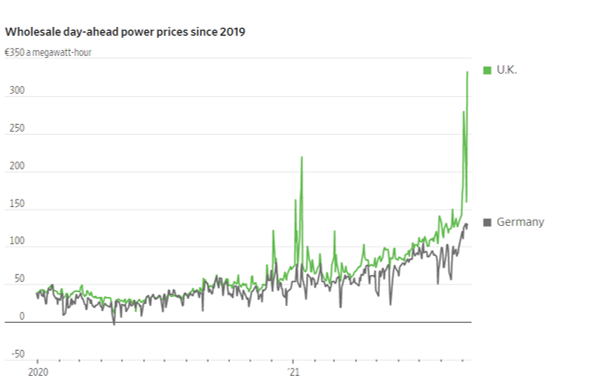
Energy prices could shoot even higher if cool temperatures stop gas stores replenishing before the period of peak winter demand, said Tom Lord, a carbon trader at U.K.-based Redshaw Advisors. “You’ve got a gas market that’s extremely tight,” he said.
Electricity, gas, coal and carbon markets have a way of feeding on one another. High gas prices prompted utilities to burn more coal, so they had to buy more emissions allowances. Expensive carbon permits then prodded energy companies to turn back to gas, whose price rose again because the fuel is in short supply.
The feedback loop has the potential to ripple into the broader economy. European Central Bank President Christine Lagarde this month referred to energy markets as one of the main forces driving inflation higher.
Wind accounted for about a quarter of Great Britain’s power last year, according to the system operator National Grid. After the wind dropped this month, National Grid asked Électricité de France SA to restart its West Burton A coal power station in Nottinghamshire. That won’t be possible in the future: The government has said all coal plants must close by late 2024.
To be sure, abundant wind power has at times led to periods of cheap electricity. This month, however, U.K. wind farms produced less than one gigawatt on certain days, according to Mr. Konstantinov. Full capacity stands at 24 gigawatts. Maintenance work on subsea cables restricted electricity imports from France.
- 09/13/2021 – Surprise forecast of more global oil demand next year by OPEC
Global Oil Demand to Exceed Pre-Pandemic Levels Next Year, OPEC Says – WSJ
Cartel raises forecast for 2022, citing travel rebound
The world’s thirst for oil will exceed pre-pandemic levels next year, with improving vaccination rates and increasing public confidence in governments’ management of Covid-19 spurring a recovery in travel, the Organization of the Petroleum Exporting Countries said Monday.
In its closely watched monthly market report, OPEC raised its forecast for global oil demand for 2022 by just under a million barrels a day to 100.8 million barrels a day, higher than 2019’s demand level of 100.3 million barrels. OPEC had previously forecast a return to 2019 demand levels in the second half of next year, but Monday’s report was the first time the cartel said it expects demand to beat pre-Covid-19 levels for the full year.
OPEC’s forecast that oil demand next year will be even higher than before the pandemic comes despite efforts by governments and companies to slash fossil-fuel usage to hit net-zero emissions targets.
OPEC expects the variant’s impact to be felt in oil markets over the coming months. The cartel trimmed its demand forecast for the final quarter of this year.
While all of the world’s geographic regions are expected to contribute to the rebound in demand, oil consumption in the wealthy countries of the Organization for Economic Cooperation and Development is expected to remain below pre-pandemic levels, OPEC said. The cartel boosted its demand-rebound forecast for developing countries by twice as much—600,000 barrels a day—as that for OECD countries.
- 09/08/2021 – Ida crippled oil production. In total, Ida has already kept about 20 million barrels of oil off the market, according S&P Global Platts Analytics. That makes it the costliest storm event in the Gulf of Mexico since hurricanes Katrina and Rita in 2005, said S&P analyst Sami Yahya.
Hurricane Ida’s Fallout Continues to Cripple U.S. Oil Production – WSJ
Most daily oil production in the Gulf of Mexico remains shut off, as companies struggle with problems hampering recovery efforts
Nearly four-fifths of U.S. oil and gas production in the Gulf of Mexico remains offline, more than 10 days after Hurricane Ida tore through Louisiana, as companies struggle to restart offshore platforms.
Ida, which barreled through the heart of the Gulf as a Category 4 hurricane, is turning out to be the most damaging storm for offshore production in more than 15 years. It crippled key onshore infrastructure, which has contributed to keeping about 12% of U.S. oil production idle. Its storm surge and maximum winds of 150 miles an hour also damaged some offshore operations, including underwater pipelines that have leaked oil into the Gulf.
The Gulf of Mexico accounts for about 17% of U.S. oil output, and about 5% of natural gas output. Companies including Chevron Corp. CVX 1.98% , Royal Dutch Shell RDS.A 2.15% PLC, BP BP 2.20% PLC and Exxon Mobil Corp. XOM 2.58% operate sizable facilities in the area.
Myriad problems are combining to slow the recovery, according to analysts and company representatives. Key ports and airports were knocked offline, slowing the redeployment of staff and equipment. Companies haven’t been able to find enough offshore staff, as workers tend to their families and homes following the storm. Oil and gas processing plants and other key onshore facilities were damaged or remain without electricity, as widespread power outages persist.
Operators have restored about 400,000 barrels of daily oil production, but most remains shut off. As of Wednesday, about 1.4 million barrels of daily oil production and about 1.7 billion cubic feet of gas, or around 77% of the total, remain offline, according to the U.S. Bureau of Safety and Environmental Enforcement, or BSEE. That was down from more than 1.8 million barrels of oil a day and about 2.2 Bcf of gas before the storm.
In total, Ida has already kept about 20 million barrels of oil off the market, according S&P Global Platts Analytics. That makes it the costliest storm event in the Gulf of Mexico since hurricanes Katrina and Rita in 2005, said S&P analyst Sami Yahya.
Oil Industry Surveys Damage After Hurricane Ida Slams Louisiana – WSJ
- 09/07/2021 – be aware of the potential upcoming slump of oil price
Oil Producers Enjoy the Calm Before the 2022 Storm
The current OPEC+ output deal sees the group increasing supply each month until they have put back all the production they took off the market in 2020. That would take them until Sept. 2022 to achieve, assuming there are no bumps on the road (see chart above).
But bumps there will almost certainly be — and possibly big ones.
The group’s analysts see the policy running into trouble at the start of 2022, or even earlier, if a resurgence of the coronavirus hits demand in the final quarter of this year. They presented oil ministers with two forecasts of the oil market ahead of the meeting on Sept. 1. The most optimistic of those sees global oil demand averaging 99.9 million barrels a day next year, within a whisker of the pre-pandemic peak of 100 million barrels.
Even with that full recovery of demand, the analysts see the supply-demand balance returning to a surplus of oil if the producer group continues boosting output as currently planned (see chart below). The stock builds are even bigger in the more pessimistic alternative scenario, which sees demand almost 2 million barrels a day lower.
Too Much Oil: Even in the base case forecast, the current policy of adding to supply each month would return OECD commercial stockpiles almost to their pandemic peak of 3.2 billion barrels, enough to meet more than 31 days of projected end-2022 demand.
- 09/07/2021 – three bullish catalysts for oil company stocks
3 Bullish Catalysts For Oil This Fall
#1 Record Revenues: Last month, Norwegian energy consultancy Rystad Energy reported that the U.S. shale industry is on course to set a significant milestone in 2021: Record pre-hedge revenues. According to Rystad, U.S. shale producers can expect a record-high hydrocarbon revenue of $195 billion before factoring in hedges in 2021 if WTI futures continue their strong run and average at $60 per barrel this year and natural gas and NGL prices remain steady. The previous record for pre-hedge revenues was $191 billion set in 2019.
#2 Demand Recovery in China Crude demand in China has started showing signs of a strong recovery after the country reopened its economy, and Beijing moves closer to finalizing a probe into its independent refiners, thus allowing so-called teapots to resume importing crude. After nearly five months of slower purchases due to a shortage of import quotas, COVID-19 lockdowns that muted fuel consumption and drawdowns from high inventories, demand for spot crude by the world’s biggest importer of the commodity is now on a recovery path.
details on China recovery
China Is Hoarding Crude Again, And That’s Great News For Oil Prices
Three months ago, in a dramatic reversal of fortunes, Beijing announced huge cutbacks in import quotas for the country’s private oil refiners. According to Reuters, China’s independent refiners were awarded a combined 35.24 million tons in crude oil import quotas in the second batch of quotas this year, a 35% reduction from 53.88 million tons for a similar tranche a year ago. But traders are now growing optimistic that Beijing will soon wrap up a probe on the teapots. Indeed, a fourth batch of quota is expected to be issued in September or October, which could revive demand from independent refiners. Something else working in the teapots’ favor is that crude stocks by China’s national oil companies are very low, and private refiners could help bridge the shortfall. Imports into China’s Shandong province, home to most teapots, fell below 3 million barrels in both July and August, compared with ~3.6 million barrels on average in the first half of 2021. China’s central bank has also said it will try and stabilize the supply of credit and increase the amount of money supporting smaller businesses. There are expectations for further stimulus targeting the infrastructure sector, manufacturing, and real estate after the July slowdown left the economic situation looking bleak.
#3 Supply Crunch: Another Wall Street punter is strongly bullish on oil but for a different reason: Supply crunch. Bank of America commodities strategist Francisco Blanch has forecast oil prices to hit $100 a barrel oil in 2022 as the world begins facing a major supply crunch: “First, there is plenty of pent up mobility demand after an 18 month lockdown. Second, mass transit will lag, boosting private car usage for a prolonged period of time. Third, pre-pandemic studies show more remote work could result in more miles driven, as work-from-home turns into work-from-car. On the supply side, we expect government policy pressure in the U.S. and around the world to curb capex over coming quarters to meet Paris goals. Secondly, investors have become more vocal against energy sector spending for both financial and ESG reasons. Third, judicial pressures are rising to limit carbon dioxide emissions. In short, demand is poised to bounce back and supply may not fully keep up, placing OPEC in control of the oil market in 2022,” explained Blanch. Blanch’s bullish prediction is so far the boldest by mainstream Wall Street banks, and it makes sense even on a longer time frame.
In the past, supply-side “peak oil” theories mostly turned out to be wrong mainly because their proponents invariably underestimated the enormity of yet-to-be-discovered resources. In more recent years, demand-side “peak oil” theory has always managed to overestimate the ability of renewable energy sources and electric vehicles to displace fossil fuels. Then, of course, few could have foretold the explosive growth of U.S. shale that added 13 million barrels per day to global supply from just 1-2 million b/d in the space of just a decade. It’s ironic that the shale crisis is likely to be responsible for triggering Peak Oil Supply.
- 09/07/2021 – it seems reasonable OPEC+ is trying to set the oil prices at $65 ~$75
OPEC+ keen to keep oil prices at $65-$75 a barrel, Lukoil chief says
MOSCOW, Sept 7 (Reuters) – The head of Russia’s No. 2 oil producer Lukoil (LKOH.MM) said that oil prices of $65-$75 were “comfortable” for consumers and that the OPEC+ group of leading oil-producing nations was striving to maintain that price range by regulating output.
In an interview with the Kommersant newspaper published on Tuesday, Vagit Alekperov said curbs on oil output would depend on market conditions.
- 09/01/2021 – oil industry news
OPEC Alliance Keeps Gradual Production Increases, Despite U.S. Request – WSJ
- Delta Variant Dents Oil Demand Recovery While OPEC Expects More Supply (Aug. 12)
- White House Urges OPEC to Boost Oil Output Amid Covid-19 Economic Recovery (Aug. 11)
- OPEC, Allies Agree to Boost Oil Output as Demand Roars Back (July 18)
- OPEC Alliance Considers Boosting Production Amid Uneven Recovery (June 23)
- 08/26/2021 – Taliban might beef up oil price due to terror attack
Afghanistan puts oil terror premium back on the front burner
Oil has advanced 11% to the $67 per barrel level over the past three sessions
It was clear that the attack on America was driven not only by hatred of freedom, Western values and humanity but also by greed and envy. Not only did terrorists try to profit from their murders by allegedly taking short positions in airline stocks, but they also had a target on oil. Usama bin Laden made it clear when he told his Islamic jihadist back in 2004 that, “the biggest reason for our enemies’ control over our lands is to steal our oil. Give everything you can to stop the greatest theft of oil in history.” He said the price of oil should be $100 a barrel and that anything less was criminal.
Usama bin Laden had a lot of issues with the Saudi royal family and tried to attack Saudi oil infrastructure. Al Qaeda attacked Saudi Arabia’s giant oil processing facility at Abqaiq but failed. Al Qaeda insurgents caused havoc in Iraq with a campaign of sabotage against the Iraqi oil industry, averaging eight attacks a month, mostly pipeline bombings.
Later the al Qaeda “JV team” ISIL (the Islamic State of Iraq and the Levant) took control of oil fields and that made them the world’s wealthiest terrorist group. Even al Qaeda and ISIL could not get along because of greed. In 2004 ISIL controlled approximately 60% of Syria’s oil assets and seven oil-producing assets in Iraq, netting them millions of dollars in revenue per day.
ISIL took control of those assets and used them, unleashing a reign of terror that included not only the beheading of journalists but also funding terror attacks in Bangladesh, Belgium, Egypt, Iraq, France, Iraq, Lebanon, Pakistan, Syria and Turkey. ISIL eventually was defeated by U.S. coalition forces in Syria and Iraq but now will regroup in the Taliban-controlled Afghanistan.
- 08/25/2021 – energy demand surges
Global electric power demand surges above pre-pandemic levels
- 08/24/2021 – Be aware that China might play oil card. There are lots of market manipulations here. I need to be very careful. Aim for long term, have risk mitigation plan
- Energy (XLE +1.1%) is the noontime leader on today’s S&P sector leaderboard, as crude oil prices extend yesterday’s big gains on rising demand optimism, a major production outage in Mexico and the first full U.S. regulatory approval of a COVID-19 vaccine.
- October WTI crude (CL1:COM) +2.8% to $67.47/bbl and October Brent (CO1:COM) +3% to $70.83/bbl, a day after both benchmarks surged more than 5%.
- ETFs: XLE, USO, UCO, XOP, VDE, GUSH, OIH, ERX, BGR, BNO
- Among today’s best performing oil and gas stocks: HAL +3.9%, OXY +2.9%, PSX +2.2%, VLO +2.1%, SLB +2%, BKR +2%.
- Brent and WTI are still down 8% and 11% this month, respectively, after yesterday’s rally, weighed by the impact of the delta variant on Chinese demand.
- But China now claims to have brought its coronavirus cases down to zero, and the Ningbo port, one of the busiest in the world, is reopened after a two week shutdown.
- “The developments out of China are reigniting expectations that oil demand would start to rise again,” Price Futures analyst Phil Flynn tells Bloomberg.
- 08/23/2021 – from Davidson
The US energy industry is tied to the 80%+ of the US economy currently ignored by most investors.
- 08/16/2021 – Political reason is the main reason. If it goes beyond $80 or $75, it will only be brief! This is similar to that of FNMA!!
The Main Reason Oil Prices Won’t Go Above $80 Per Barrel
The only surprise for those of us who have been trading oil profitably for years based on the near certainty of this price cap is that the gasoline price catalyst for the cap’s reiteration has now come at a slightly lower crude oil price than usual. Based on recent historical precedent, a US$90-95 per barrel of Brent oil price equated to around US$3 per gallon of gasoline and a US$125-130 per barrel of Brent equated to around US$4 per gallon of gasoline. However, this time around, U.S. retail gasoline prices averaged US$3.14 per gallon in July (the highest monthly average since October 2014) whilst Brent crude struggled in that month to trade about US$77 per barrel, mostly averaging US$75 per barrel and less. This was despite the ongoing efforts of Goldman Sachs at that point and in the months preceding it to talk it up to US$80 per barrel, with all of the associated guided buying that goes with this sort of implied price target. After July, Brent fell back again and has traded nowhere near even US$75 per barrel on a sustained basis.
The second of the two reasons that have kept the crude oil price cap in place since the end of the 2014-2016 Oil Price War is political and is a corollary of the generally deleterious economic effect on the U.S. economy of increasing oil (and, therefore, gasoline) prices. Specifically in this regard, according to U.S. NBER statistics, since World War I, the sitting U.S. president won re-election 11 times out of 11 when the U.S. economy was not in recession within two years ahead of an election. However, presidents who went into a re-election campaign with the economy in recession won only once out of seven times (Calvin Coolidge in 1924, although strictly speaking he had not won the previous election but had rather taken up the position on the death in office of Warren G Harding). President Biden is not facing another presidential election for four years, of course, but he does face critical mid-term elections within the next two years – November 2022 – when his Democrats could lose their narrow majority in the House of Representatives. As of the last election, the Democrats held 222 seats, with 218 needed for control, whilst it was 50 seats each for the Democrats and Republicans in the Senate, with the Democrat vice-president constitutionally holding the tie-breaker vote.
- 08/22/2021 – Big oil’s fat dividends may not attract long-term enough investors because they view oil and gas companies as dividend traps with a sell-by date that is moving closer by the day.
Big Oil Looks To Woo Investors Back With Massive Dividends | OilPrice.com
ExxonMobil currently sports a 6.60% dividend yield (Fwd); Chevron yields 5.68%, BP 5.56%, Shell 5.01%, while MPLX LP (NYSE:MPLX) checks in with 10.01% fwd yield.
Meanwhile, share buybacks are designed to boost a company’s earnings, which eventually reflects in its share price.
However, Hipple says that whereas a 10% yield can act as a powerful magnet for the average income investor, savvy, long-term investors are not falling for it because they view oil and gas companies as dividend traps with a sell-by date that is moving closer by the day.
“Once institutional investors determine that demand has peaked–which likely has already happened–they will abandon the sector permanently. Many already have, based on the stock performance of the sector over the past several years.”
- 08/09/2021 – If 10yr rates decline for a period deemed significant enough, investors take this as a signal of economic weakness and short $WTI to hedge and vice versa. The price spike in $WTI in 2008 was on the belief the world was running out of oil and in 2010-2014 occurred with an economic recovery and continued belief of not enough supply.
Oil/Energy Companies as Inflation Hedge
The recent rise and fall of commodity prices has reinforced the belief that demand creates inflation through rising commodity prices. Inflation vs. $WTI reveals that many bouts of inflation, indicated with the markers, have occurred without price rises in $WTI. Nonetheless, oil prices are incorporated in economic thinking as the cause of inflation, an indicator of economic activity and triggers in algorithmic trading programs. While oil pricing is believed by many to reflect simple supply/demand on a daily basis, $WTI has become more correlated to other price trends in investment portfolios as a hedge for downside risk/upside opportunity. If 10yr rates decline for a period deemed significant enough, investors take this as a signal of economic weakness and short $WTI to hedge and vice versa. The price spike in $WTI in 2008 was on the belief the world was running out of oil and in 2010-2014 occurred with an economic recovery and continued belief of not enough supply. Speculators skewed prices with these fears, but inflation remained for the most part unaffected. This proved that oil prices as a basis for inflation was more myth than reality and underscored government spending as causal. Nonetheless, commodities especially oil which is consumed, cannot be recycled, requires considerable capital expenditure to produce and remains intimately connected to economic activity without viable alternatives have always been favored as an inflation hedge once inflation pressures become apparent.
Over the past 10yrs-15yrs fossil fuels have increasingly come under activist pressures to be eliminated as primary source of CO2 and Global Warming. The data does not support this belief, yet this has received such widespread acceptance that this industry has been maligned and discarded from global endowment and pension plans leaving an industry vital for economic activity starved for investment capital with government policies geared to limit supply. This still leaves oil prices imbedded in investor psyche as the primary inflationary input as a setup for what is likely to occur the next few years.
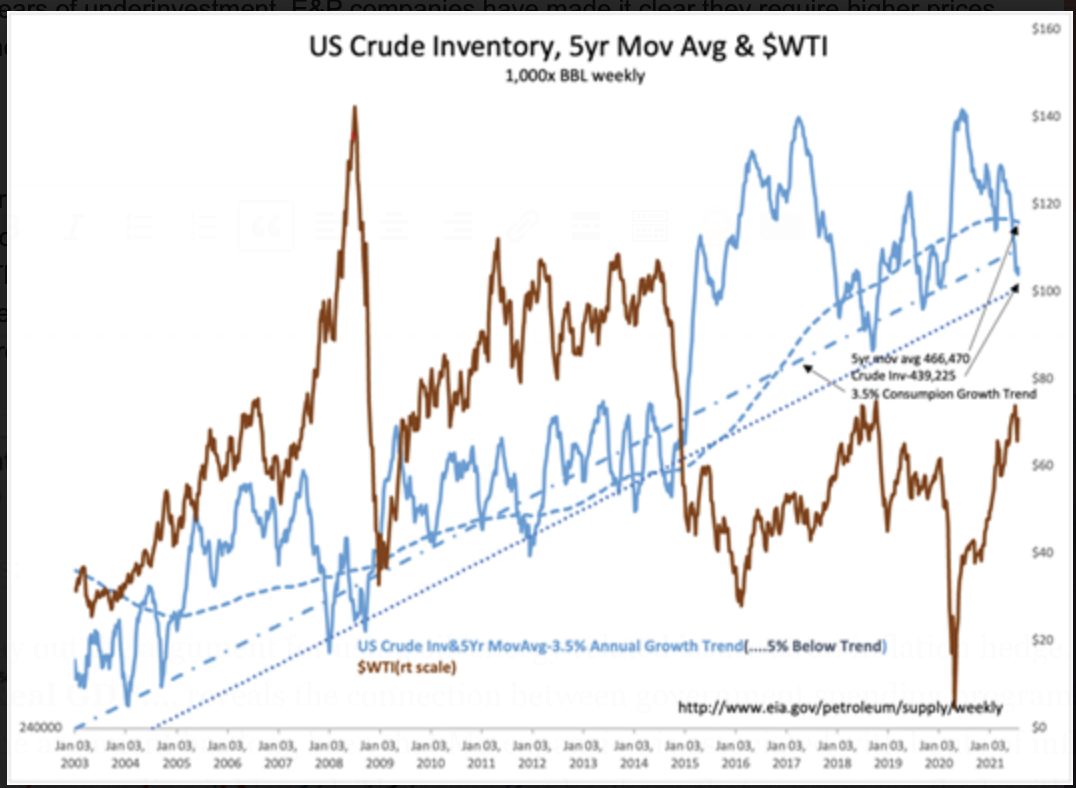
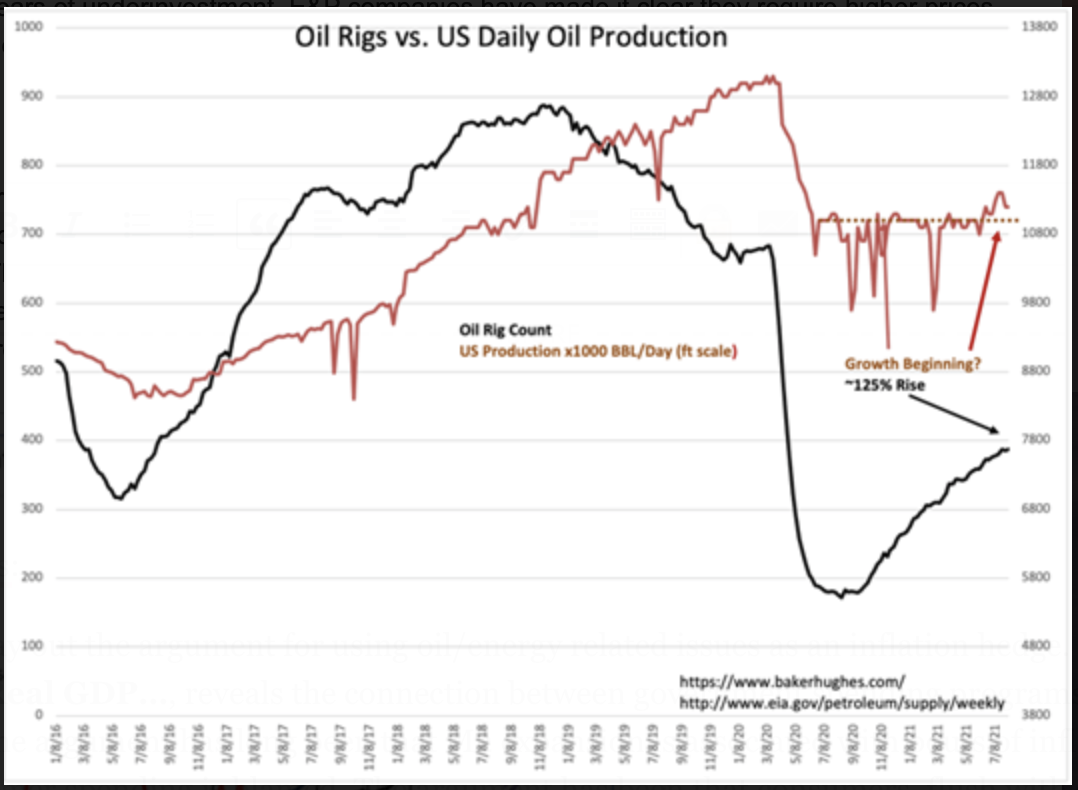
In my opinion, the current disregard for oil/gas as a vital aspect for continued economic expansion is likely to change into an industry perceived as a strong investment opportunity. Some may be deluded into viewing short-term price swings as temporary. The conditions laid out here suggest a prolonged period of demand vs. undersupply. Oil/gas drilling requires specialized equipment and trained crews both of which require time to assemble. Equipment and crews have diminished supply from years of underinvestment. E&P companies have made it clear they require higher prices and lower inventories before they are willing to expand production. Inflation from excess government spending will emerge spurring a scramble to hedge portfolios to counter this risk. Oil/gas and related industries historically has been the chosen approach.

- 07/20/2021 – the daily change of oil price (and so oil stock price) can be very volatile, therefore, I need to cash out some profit for future re-investment. Oil price and stocks seem like self equilibrium device, especially for the overshoot – if it overshoots too high, it will drop significantly very fast. That is what happened yesterday -7.5% in one day
Oil-Price Swoon Spurs Traders to Bet on Further Declines – WSJ Delta variant raises prospect of fresh restrictions on economic activity, particularly in fuel-intensive Asian countries
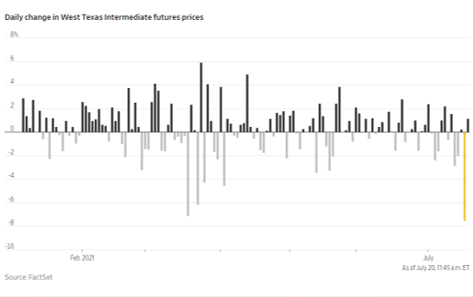
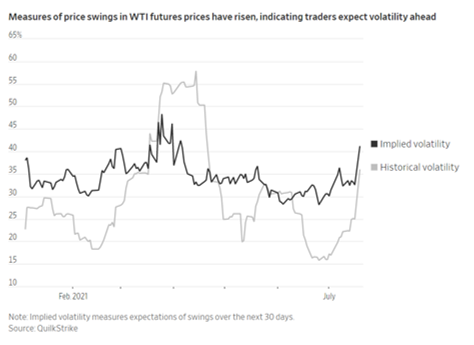
- 07/18/2021 – On Sunday, the group also decided to boost other members’ baselines, the estimate of the maximum amount of oil each country is capable of producing. The adjustments go into effect in May 2022. The group said it would reassess market conditions in December. The deal is broadly in line with one struck earlier this month. This will restore all of the cuts they made at the start of the pandemic as economies pick up and crude demand recovers.
OPEC+ Agrees to Boost Oil Output as Demand Roars Back – WSJ
Producers to increase production by 400,000 barrels a day, moving to restore capacity they cut at the start of the Covid-19 pandemic
OPEC and its Russia-led oil-producing allies agreed to unleash millions of barrels of bottled-up crude over the next two years, committing to restore all of the cuts they made at the start of the pandemic as economies pick up and crude demand recovers.
The group said it would reassess market conditions in December. The deal goes into effect next month.
Early last year, OPEC+ slashed 9.7 million barrels a day of its collective output, equivalent to about 10% of 2019 demand. It has restored about 4 million barrels of that. Sunday’s deal calls for the remainder of those cuts to be unwound through late next year.
The deal is broadly in line with one struck earlier this month. Final agreement had been held up for over two weeks after the United Arab Emirates asked for its production quota inside the group to be reassessed. It was eager to pump more crude than its allotment, after investing heavily in its oil fields.
On Sunday, the group also decided to boost other members’ baselines, the estimate of the maximum amount of oil each country is capable of producing. The adjustments go into effect in May 2022. Those technical adjustments would also boost affected countries’ real output since that is based on these baselines.
OPEC said the U.A.E.’s base line would go up by about 332,000 barrels a day. Saudi Arabia and Russia, two of the world’s biggest producers alongside the U.S., will each get their baseline lifted by 500,000 barrels a day. Overall, the group’s estimated production capacity is being upgraded by 1.63 million barrels a day.
- 07/15/2021 – this might be good for oil companies
Wall Street Opens Back Up to Oil and Gas—but Not for Drilling – WSJ
Oil-and-gas companies are using cash from debt offerings to shore up balance sheets rather than to boost production
- 07/06/2021 – It is always good to see the deleverage process of major oil companies
from oilprice.com
$140 Billion Asset Sale In Oil & Gas Creates Huge Opportunities For Some. While the world’s oil majors are rushing to put non-core assets up for sale, some smaller E&Ps are seizing the opportunity to acquire choice assets at a discount. According to WoodMackenzie’s Greg Aitken, “The list of assets is way higher than the number of buyers out there and particularly for some of the bigger deals,”. And according to the energy consultancy, the total value of oil and gas assets up for sale across the industry now stands at more than $140 billion.
A $140bn asset sale: the investors cashing in on Big Oil’s push to net zero
Energy consultancy Wood Mackenzie says ExxonMobil and Chevron in the US and BP, Royal Dutch Shell, Total and Eni in Europe have sold $28.1bn in assets since 2018 alone. Now they are targeting further disposals of more than $30bn in the coming years.
The total value of oil and gas assets up for sale across the industry, however, stands at more than $140bn, according to the consultancy.
- 07/05/2021 – The UAE said on Sunday it backs an output increase from August but suggested deferring to another meeting the decision on extending the supply pact. It said baseline production references – the level from which any cuts are calculated – should be reviewed for any extension. OPEC+ sources said the UAE contended its baseline was originally set too low, but was ready to tolerate if the deal ended in April 2022. The UAE has ambitious production plans and has invested billions of dollars to boost capacity. – The standoff could delay plans to pump more oil through to the end of the year to cool oil prices. Therefore, the oil price jumps somewhat in the short term. But what we can see is UAE wants more oil production after April 2022 which might hurt oil price in the longer term.
In OPEC Deadlock, U.A.E. Steps Out of Saudi Shadow – WSJ
U.A.E., which has deviated from its bigger neighbor in regional issues, is now at odds with Riyadh over oil policy
OPEC failed in its third attempt to resolve a deadlock over oil production after divisions between allies Saudi Arabia and the United Arab Emirates spilled into public and into global financial markets.
The group called off a meeting scheduled for Monday with Russia-led oil producers after the U.A. E.—typically one of Riyadh’s most dependable supporters in the group—refused to agree to a Saudi-backed deal to boost output, according to people familiar with the matter. The deal, tentatively approved by the rest of the Organization of the Petroleum Exporting Countries and the Russia-led group, together known as OPEC+, calls for unleashing millions of barrels a day of bottled-up crude to help tame steadily rising oil prices.
Oil prices rose to fresh multiyear highs after the OPEC meeting was called off as investors weighed whether the spat could endanger a near-term deal for more barrels. Brent crude, the international benchmark, rose 1% to $76.96 a barrel, the highest level since late 2018.
The U.A.E. says it is asking for scope to produce more of its oil under any accord. Its unwillingness to compromise comes as Riyadh and Abu Dhabi—neighbors, military partners and traditional OPEC allies—diverge on several fronts, economic and geopolitical.
The U.A.E. has invested heavily in its own output—an effort aimed at pumping more oil, faster, to finance a transition to a more diverse economy. “The U.A.E.’s energy strategy has evolved to take into account energy transition, the speed at which it wants to develop its resources,” said Roger Diwan, an oil-focused vice president at energy consultancy IHS Markit.
Saudi Arabia pushes back on UAE opposition to OPEC+ deal
The UAE said on Sunday it backs an output increase from August
The UAE said on Sunday it backs an output increase from August but suggested deferring to another meeting the decision on extending the supply pact. It said baseline production references – the level from which any cuts are calculated – should be reviewed for any extension.
The standoff could delay plans to pump more oil through to the end of the year to cool oil prices.
OPEC+ sources said the UAE contended its baseline was originally set too low, but was ready to tolerate if the deal ended in April 2022. The UAE has ambitious production plans and has invested billions of dollars to boost capacity.
Prince Abdulaziz, who stressed Riyadh’s “sacrifice” in making voluntary cuts, said no country should use a single month as a baseline reference, adding there was a mechanism to file objections and that “selectivity is difficult.”
- 06/28/2021 – Worth to read this very comprehensive and non-biased article
The Case For A Longer-Term Oil And Gas Bull Market
- After a long bear market, the energy sector has low capex and is likely setting up for a longer-term bull market, not just a transitory blip.
- An analysis of every major energy/power source, including their shortcomings.
- My favorite energy stocks for the long run.
- 06/28/2021 – Good article from Davidson
“Davidson” submits: Exxon, EOG and Oil
Without performing a complex analysis of too many shifting factors to properly quantify, the simplest approach is to look at expected fossil fuel liquid production vs. $WTI to guestimate revenue growth and the market pricing response. The factor which is unknown is how much more efficient any company may prove to be this cycle vs previous cycles. Well-operated companies have nearly always added operating efficiencies which tend to surprise on the upside. XOM& EOG fit this description. Already there is reported and anecdotal information suggesting ~70% lower costs to production than 5yrs ago for each. Some cost reduction is from operating procedures and some is from technological innovation. How much impact on improved cash flows will be unknown till we are in a full throated expansion of the energy cycle. As unemployment falls globally with one country after another exiting COVID shutdowns, economic normalization and energy consumption will return to pre-COVID levels.
In estimating the impact of cycle normalization, the simple approach is to assume companies will resume pre-COVID liquids production and that cash flows and investor response remain more or less coupled as in the past. Relating $WTI to share price is useful. $WTI prices at $73/BBL today relates to EOG and XOM 2018 prices of $125shr and $85shr respectively. From current levels, these prices represent 30% potential portfolio gains. Unknown, is the impact on $WTI of 7yrs of underinvestment the industry has had to manage since the 2014 $WTI plunge.
Today, E&P cos are producing at ~20% less than 18mos ago while consumption is normalizing. The industry has lowered finding costs ~70%. The crude inventory build post 2014 and partially revisited during the COVID shutdown has forced conservative operating stances even as inventories drop sharply towards the historic 3.5% Annual Growth Trend representing previous low inventory levels. $WTI is the likely key to stimulating higher production once it comfortably reaches and holds at a level that promotes additional supply. Only corporate management knows what that trigger price is. This far, the rise in $WTI has not resulted in higher crude production and crude inventories are falling near 8mil BBL week-over-week. In 2wks, US Crude Inv is likely to fall below the 3.5% Annual Growth Trend connecting past low inventory periods.
There are multiple forecasts for $100/BBL oil prices. Should this occur in the current cycle, EOG and XOM are likely to be priced accordingly. Pricing is less a mechanical process and more based on market psychology dependent on how long an investment concept has been out of favor vs. how dramatic the perceived change is at hand. There are always unknowns. That nearly 100% of goods and people transport is dependent on fossil fuels which consumes 85% of fossil fuels makes alternatives impossible. $WTI is as much determined by market psychology as any other price. The presence of a 10 fold larger futures market with a sudden shift towards speculative frenzy can make it soar above the prior highs. The potential that this could occur is possible.
Fossil fuel related cos are recommended portfolio suggestions at this time with EOG & XOM as well-managed E&P companies and RES and SDPI as smaller service-related suggestions.
The insider activity in XOM is appropriate at this time in my estimation.
- 06/21/2021 – Bank of Americxa raised its Brent crude oil price forecast to $68 per barrel from $63 earlier. In 2022, it expects Brent to average $75 per barrel versus its earlier estimate of $60. The bank noted that U.S. shale will likely respond to these higher prices by ramping up production and Brent would roll back down to average $65 per barrel by 2023. In addition, Bank of America believes we can see $100/bbl oil next year. The oil market will likely remain in deficit for the foreseeable future, averaging a shortfall of 0.9 million barrels per day (bpd) over the next six quarters, it said. BofA expects consumption growth to rebound strongly this year and next by 5.6 million and 3.6 million bpd respectively, the fastest since at least the 1970s.
BAC : Bank of America believes we can see $100/bbl oil next year • 12:36 PM
|
Full Article:
June 21 (Reuters) – BofA Global Research raised its Brent crude price forecasts for this year and next, saying that tighter oil supply and demand balances in 2022 could push oil briefly to $100 per barrel.
“We believe that the robust global oil demand recovery will outpace supply growth over the next 18 months, further draining inventories and setting the stage for higher oil prices,” the bank said in a note dated Sunday.
The bank raised its Brent crude oil price forecast to $68 per barrel from $63 earlier. In 2022, it expects Brent to average $75 per barrel versus its earlier estimate of $60.
The bank noted that U.S. shale will likely respond to these higher prices by ramping up production and Brent would roll back down to average $65 per barrel by 2023.
The oil market will likely remain in deficit for the foreseeable future, averaging a shortfall of 0.9 million barrels per day (bpd) over the next six quarters, it said.
BofA expects consumption growth to rebound strongly this year and next by 5.6 million and 3.6 million bpd respectively, the fastest since at least the 1970s.
While demand is set to recover at a rapid pace in the coming months, the bank cautioned that ample OPEC+ spare capacity and a likely return of Iran barrels will cap oil prices this year.
Oil prices edged higher on Monday, underpinned by strong demand during the summer driving season and a pause in talks to revive the Iran nuclear deal that could lead to a resumption of crude supplies from the OPEC producer.
- 06/14/2021 – watch out the US-Iran deal for the impact on oil price
Iran says it has broad agreement with the US on lifting sanctions
The landmark accord has been delayed because there are some sticking points, but not an impasse, Iran said.
Iran said it has reached a broad agreement with the U.S. over the lifting of sanctions on its industrial sectors, including energy, but warned there was “very little time left” for world powers to revive a 2015 nuclear deal.
Saeed Khatibzadeh, spokesman for Iran’s Foreign Ministry, didn’t give more detail on the potential easing of trade restrictions, which have all but prevented the Islamic Republic from exporting oil and battered its economy. The landmark accord was being delayed because there are still sticking points, he told reporters in Tehran on Monday.
“Some minute technical, political, legal and practical issues remain,” Khatibzadeh said. “No task was impossible for negotiators” and there’s no impasse, he said.
- 06/14/2021 – much less global spending on oil extraction and about 50% of rig counts, the oil future price is rising.
Oil Price Hits Pandemic High as Investors Bet on Green Energy – WSJ
Wall Street’s preference for renewables could mean oil producers will now struggle to meet demand
The bets come as money managers line up trillions of dollars for wind, solar and other renewable programs and expenditures on oil projects tumble. The drop in fossil-fuel spending is becoming so severe that energy companies could struggle to quench the world’s thirst for oil, some analysts say.
Crude is still expected to remain in high demand over the next decade to make transportation fuels and petrochemicals used for plastics and other household products. U.S. consumption has surged lately following the worst of the coronavirus pandemic, and output cuts by the Organization of the Petroleum Exporting Countries have given prices a further boost.
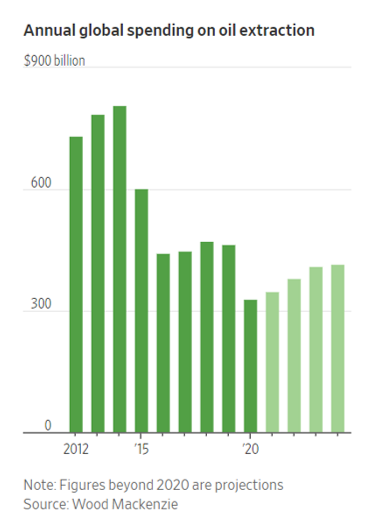
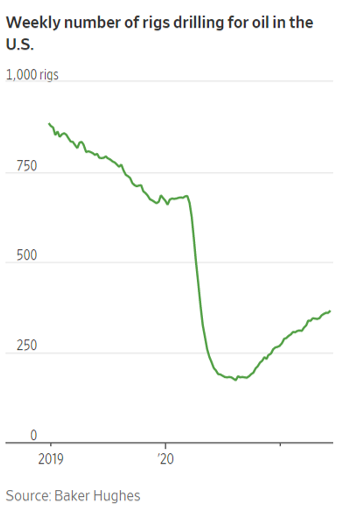
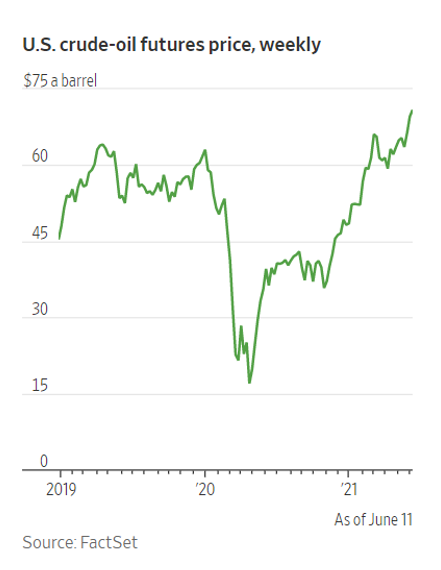
- 06/13/2021 – “Green Belt and Road” or the “Green Marshall Plan,” would be funded by multilateral development banks like the IMF and World Bank, as well as the private sector (think wind farms, railways and other low-carbon projects). The Biden administration also plans to work with Congress to increase U.S. contributions to the G7’s Development Financing Toolkit.
- will this kill oil industry in the long term, but revive it in the short term?
G7 draws up global green infrastructure plan to counter China
- At a G7 summit over the weekend, President Biden pressed world leaders to take concrete steps to counter China’s rising influence and put a heavy focus on the path toward decarbonization. The result? A global infrastructure project called “Build Back Better for the World” that would kill two birds with one stone. It calls for spending $100B per year to help developing nations’ climate change transitions, while sticking to climate standards and labor practices.
- Bigger picture: The plan would specifically create a “higher quality” alternative to China’s Belt and Road Initiative, which has been criticized over its leverage in creating political goodwill, massive debt and a way to spread Beijing’s influence. The new G7 plan, dubbed by some as the “Green Belt and Road” or the “Green Marshall Plan,” would be funded by multilateral development banks like the IMF and World Bank, as well as the private sector (think wind farms, railways and other low-carbon projects). The Biden administration also plans to work with Congress to increase U.S. contributions to the G7’s Development Financing Toolkit.
- Quote: “As the G7, we are united in our vision for a cleaner, greener world. A solution to the problems of climate change,” said U.K. Prime Minister Boris Johnson, who chaired the conference. “I think that is what he peoples of our countries now want us to focus on… and that we’re building back better together.”
- Other headlines at the G7 summit: Leaders vowed to phase out gas and diesel cars and shut down coal plants that do not apply emissions-capturing technology as soon as possible. They also promised to protect 30% of the planet’s land and oceans by 2030. On an interesting note, NATO, which includes many G7 nations, will agree on a climate action plan tomorrow that would make their armed forces carbon-neutral by 2050.
- 06/13/2021 – watch out Iran for oil or any implications on a deal to roll back some U.S. sanctions
Friday – June 18 –Seeking Alpha Catalyst Watch
All day – Oil traders (CL1:COM) will be watching the election in Iran for any implications on a deal to roll back some U.S. sanctions. Most forecasts already factor in a return of around 1 mbpd worth of Iranian oil supply, but a faster-than-anticipated resolution to the sanctions issue could cause headwinds for Upstream companies and tailwinds for Downstream companies with widening crude differentials.
- 06/12/2021 – Hard to say EV revolution will take over oil/gas industry soon. A report from IHS Markit shows that last year, light plug-in and fuel-cell vehicles, as well as electric city buses and two-wheelers, collectively displaced about 370,000 barrels per day of global oil consumption, a figure that is projected to grow to 1.5 million barrels per day by 2025, equal to about 1.4% of the projected level of total world oil demand. Certainly not enough to lose sleep over by long-term oil investors.
Oil Investors Shrug Off EV ‘Revolution’
EVs can “eat into traditional market share for liquid fuels,” but that’s largely a “developed economy, or rich country issue at this point.” — Dean Foreman, American Petroleum Institute.
Which brings us to the question of the day: How much damage are EVs like the new Ford-150 Lightning doing to global oil demand?
Akshat has estimated that a light truck like the Lightning consumes about 680 gallons of gasoline every year, which requires about 2,000 gallons of crude to produce. That translates to about 50 barrels of oil every year. Obviously, it takes quite a bit of juice to charge the Lightning’s home backup system. However, Akshat has not even factored it in his math, which appears reasonable considering many people might use the backup power system only a few times every year.
When it comes to denting overall oil demand, the EV sector has a long way to go before it can challenge the ICE hegemony.
A report from IHS Markit shows that last year, light plug-in and fuel-cell vehicles, as well as electric city buses and two-wheelers, collectively displaced about 370,000 barrels per day of global oil consumption, a figure that is projected to grow to 1.5 million barrels per day by 2025, equal to about 1.4% of the projected level of total world oil demand. Certainly not enough to lose sleep over by long-term oil investors.
That said, the long-term EV outlook remains bright.
BNEF says 58% of all new vehicle sales will be the electric kind two decades down the line.
That might have appeared like a bad case of blue-sky thinking just a few years ago, but not anymore: The Biden administration has proposed spending heavily on EV infrastructure while the UK wants to ban gas-powered vehicles on its roads after 2030.
- 06/12/2021 – expect total global oil demand to average 96.58 million bpd this year, up from 90.63 million bpd in 2020. The economic momentum and reopenings are set to accelerate the oil demand rebound in the second half of the year, when total demand worldwide is expected to reach 99.0 million bpd, up from an estimated 94.1 million bpd for the first half of 2021.
OPEC Sees Strong Oil Demand Recovery This Autumn
Global oil demand will rise by 6 million barrels per day (bpd) this year from the lows of 2020, led by strong consumption in China and the United States, especially in the second half of 2021 with growing economies and border reopenings, OPEC said on Thursday.
In its Monthly Oil Market Report (MOMR), the organization continues to expect total global oil demand to average 96.58 million bpd this year, up from 90.63 million bpd in 2020, despite the COVID resurgence and renewed lockdowns in key economies, including the Eurozone, Japan, and India.
The economic momentum and reopenings are set to accelerate the oil demand rebound in the second half of the year, when total demand worldwide is expected to reach 99.0 million bpd, up from an estimated 94.1 million bpd for the first half of 2021. Improving mobility in major economies support gasoline and diesel demand, while seasonal summer demand will also add to higher consumption. The ongoing vaccination is also a bullish factor in OPEC’s outlook for the second half of the year.
“OECD Americas, led by the US, is projected to be the largest contributor to oil demand growth in 2021, supported by rebounding transportation fuels, mainly gasoline, and healthy light- and middle-distillate requirements,” OPEC said.
Despite this, oil demand in North America is not expected to return to pre-pandemic levels this year, the cartel noted.
In developing economies, China will lead the demand growth, followed by India and other markets in Asia, according to OPEC.
- 06/11/2021 – Demand might outpace supply so far. If oil price jumps up to $80 or even $100, it might not stay there long since political interference will be on. Also, A comeback by U.S. shale, possible by the y the fourth quarter of 2022, could muddy the waters for everyone. So I need to have quick response to this “transient” change and profit from it. I cannot stay too long.
Oil Could Reach $80 This Summer, But There’s A Catch
- “Demand is ramping up very quickly because everybody’s driving, and we have the reopening of Europe, which is really starting to happen, while India seems to have hit an inflection point, in terms of cases, which in my mind could mean you also get a return of mobility,” Francisco Blanch, global commodities and derivatives strategist at Bank of America, has told CNBC.
- “There’s an incredible case where the oil price could get to $80, but there would be a reaction to that. That would start to affect demand, and also there would be a political reaction to that. You’ll start to see phone calls being made. [President Joe] Biden has been in politics long enough to know that high gasoline prices are always a problem for whoever is president. That’s true even in eras of energy transitions.”
- An even bigger risk: A comeback by U.S. shale could muddy the waters for everyone. The U.S. industry is producing about 11 million barrels a day, down from about 13 million before the pandemic. Many analysts, however, are not sure how fast U.S. shale will make a full comeback. “As we enter 2022, the US shale response becomes a major source of uncertainty amid an uneven recovery across shale plays and players alike. As in previous cycles, US shale will remain a key factor shaping market outcomes,” Institute Director Bassam Fattouh and analyst Andreas Economou have said.Fattouh and Economou have warned that the market could flip into a surplus by the fourth quarter of 2022 if the U.S. shale growth hits the upper bound of 1.22 million barrels per day and global demand recovery turns out to be slower than expected.In other words, even a partial recovery by U.S. shale might be enough to offset the delicate balance that OPEC+ has so far managed to establish in the markets.However, we think it will take at least two years before U.S. shale makes a significant comeback. Right now most shale companies are reluctant to invest, preferring to pay down debt and hike dividends. Investors have been taking a dim view of companies that have continued aggressive drilling campaigns, and that sentiment is unlikely to change any time soon.
- 06/11/2021 – some news with positive trend for oil, except U.S. lifting sanctions on Iranian officials. Demand is ramping up for oil, capital investment is decreasing for oil, OPEC and US are discipline in production. EV and new energy projects are running out of cash, will it be de ja vu again?
Friday, June 11th, 2021 from oilprice.com
Oil prices showed modest gains on Friday, after a selloff on Thursday.
Oil prices drop after U.S. lifting sanctions on Iranian officials. The U.S. Department of the Treasury said on Thursday it is removing several Iranian officials from its list of designated persons, including three directors of the National Iranian Oil Company (NIOC). Oil prices declined on the news.
Rystad: OPEC+ will have to loosen output limits. In early trading Friday, oil was back up, on positive economic news in the U.S. and accelerating global vaccination campaigns, according to Rystad Energy. But the firm warned that there is going to be rising pressure on OPEC+ to loosen production constraints in order to avoid the oil market overheating.
IEA: OPEC+ should “open the taps.” The IEA said that global oil demand will rebound past pre-pandemic levels by the end of 2022. After declining by 8.6 mb/d in 2020, oil demand will rebound by 5.4 mb/d this year, and by another 3.1 mb/d next year. The agency reiterated that OPEC and its allies needed to “open the taps” to boost oil production and keep the world well supplied.
High-profile EV SPAC running out of cash. Lordstown Motors (NASDAQ: RIDE), a SPAC aimed at manufacturing EV pickups out of an old GE plant in Ohio, disclosed that it does not have sufficient cash to start commercial production and issued a going concern warning through the end of the year. Lordstown was one of several EV SPACs that went public in the last year.
Biden looks at offshore wind in Gulf of Mexico. The Interior Department said on Tuesday that it will examine potential areas of the Gulf of Mexico that are suitable for offshore wind.
Solar industry’s costs are rising. Rising costs for labor, freight, steel and aluminum are pushing up the cost of solar power, ending more than a decade of steady cost declines, at least temporarily. Contract prices for solar were already up 15% in the United States in the first quarter compared with last year due to higher interconnection and permitting costs. There is uncertainty over how long the cost increase will last.
U.S. LNG set for export record. U.S. exports of liquefied natural gas (LNG) are set to surge this year from the already record levels in 2020 as demand in Asia and Europe is high, even in the off-peak season.
Can oil sands be banned? The oil sands of Athabasca seem to be at an especially vulnerable crossroads – just when oil sands production could finally surge unimpeded with new pipelines allowing for higher exports abroad.
Oil could hit $80 this summer, but there’s a catch. There is more room to run for oil. “There’s an incredible case where the oil price could get to $80, but there would be a reaction to that. That would start to affect demand, and also there would be a political reaction to that.”
Board shakeup could result in capex changes for Exxon. Investors want a “fundamental rethink on strategy,” Anne Simpson, investment director at shareholder California Public Employees’ Retirement System, told Reuters “The big measure” being its $16 billion-$19 billion annual project spending, she added.
European banks face huge financial threats from energy transition. A rapid and chaotic energy transition would leave Europe’s biggest banks in financial peril comparable to the subprime crisis that U.S. lenders faced in 2008, according to Bloomberg.
RBC downgrades Callon Petroleum, upgrades Marathon. RBC downgraded Callon Petroleum (NYSE: CPE) and Continental Resources (NYSE: CLR), saying their stock has strengthened far enough. The bank upgraded Marathon Oil (NYSE: MRO) and Range Resources (NYSE: RRC) on a more bullish outlook for crude oil and natural gas, respectively.
Gas pipeline building spree at an end. The years-long building spree of long distance natural gas pipelines in the U.S. is coming to an end, as political and financial barriers turn against the industry, according to S&P Global Platts.
Biden considers relief for refiners on biofuels. Under pressure from labor unions, the Biden administration is considering providing relief to oil refiners related to their biofuels blending requirements.
Permian basin gas pipeline connections increase. The recent completion of a handful of gas pipelines has connected Permian basin gas to the Gulf Coast, and also to Mexico, boosting Waha Hub prices.
- 06/10/2021 – The potential sanction life will pressure oil price. U.S. officials are preparing to resume a sixth round of negotiations to restore the 2015 nuclear deal with Iran and a group of major powers. Discussions are expected to start up again this weekend in Vienna, according to people involved in the talks. watch out this weekend.
U.S. Lifts Sanctions on More Than Dozen Former Iranian Officials, Energy Firms – WSJ
U.S. officials say action shows commitment to easing pressure campaign if Tehran changes its behavior
The Biden administration lifted sanctions on more than a dozen former Iranian officials and energy companies, an action that comes amid stalled nuclear negotiations and that U.S. officials said signals Washington’s commitment to easing a broader pressure campaign if Tehran changes its behavior.
The U.S. Treasury Department on Thursday repealed sanctions against former senior National Iranian Oil Co. officials and several companies involved in shipping and trading petrochemical products.
U.S. and Iranian negotiators, meanwhile, have struggled to bridge major gaps in nuclear and security talks in Vienna.
“These actions demonstrate our commitment to lifting sanctions in the event of a change in status or behavior by sanctioned persons,” Secretary of State Antony Blinken said in an accompanying statement.
U.S. officials are preparing to resume a sixth round of negotiations to restore the 2015 nuclear deal with Iran and a group of major powers. Discussions are expected to start up again this weekend in Vienna, according to people involved in the talks.
U.S. and European officials have said significant differences remain between Washington and Tehran over who should do what to restore the nuclear deal. The negotiations now look very likely to drift past Iran’s presidential elections on June 18, which some Western officials saw as a target date to complete the talks.
- 06/07/2021 – Traders use 88,549 calls to
bet on $100 a barrel by Dec 2022, Even some of those buying the options don’t expect oil prices to hit $100 but think they will profit regardless. Volatility and options are intrinsically linked, so all else being equal, that would boost the price of the contracts. will it be like kind of Gamma squeeze?
Options Traders Bet on Return of $100 Oil – WSJ
Investors have scooped up call options tied to crude prices hitting milestone for first time since gush of U.S. oil in 2014
Traders have alighted on what some believe to be a one-way bet in the world’s most important commodity market: oil prices going to $100 a barrel.
They have scooped up call options tied to Brent and West Texas Intermediate crude-oil prices reaching $100 by the end of next year. Oil prices haven’t topped that milestone since 2014, when a gush of U.S. crude depressed energy markets.
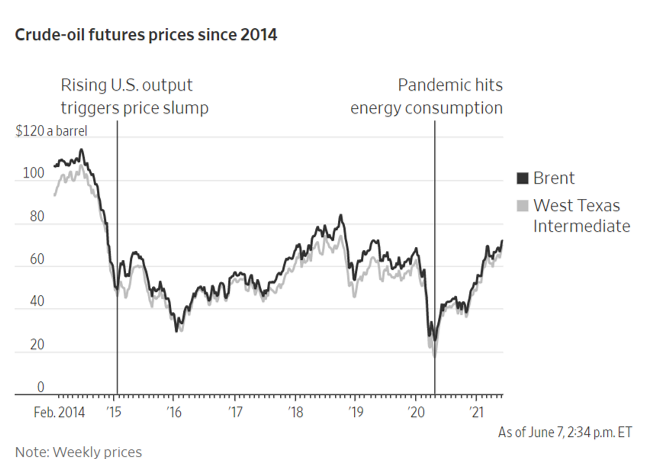
Owners of $100 options—now the most widely owned WTI call contracts on the New York Mercantile Exchange—are making a leveraged bet that oil prices will hurtle higher after already surging more than 40% this year. The roaring rally, goosed by thawing coronavirus restrictions, has lifted WTI prices to their highest level since 2018 at almost $70 a barrel and average U.S. gasoline prices above $3 a gallon, according to GasBuddy.
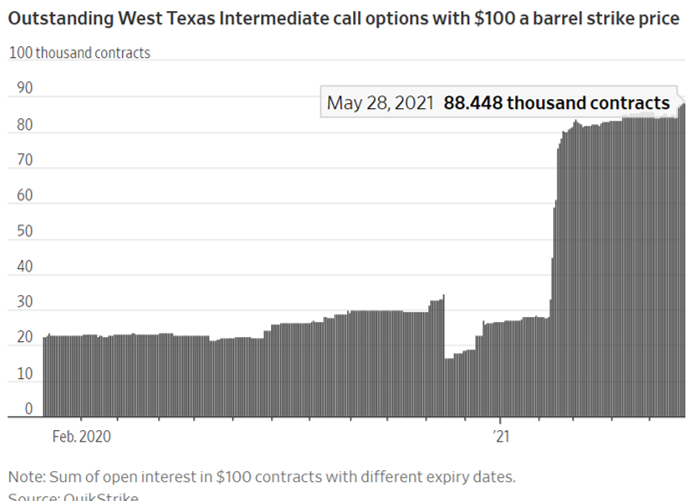
The popularity of $100 options is another example of traders converging on seemingly outlandish wagers they consider to be almost guaranteed ways of making money. Analysts say oil is unlikely to zip to $100 any time soon because the world economy is still recovering from the shock of Covid-19 and major producers are lifting output in response to resurgent demand.
“Everyone’s been looking at it,” Adam Webb, chief investment officer of trading firm Blue Creek Capital Management LLC, said of $100 call options for oil delivered in December 2022. “It’s a no-brainer.”
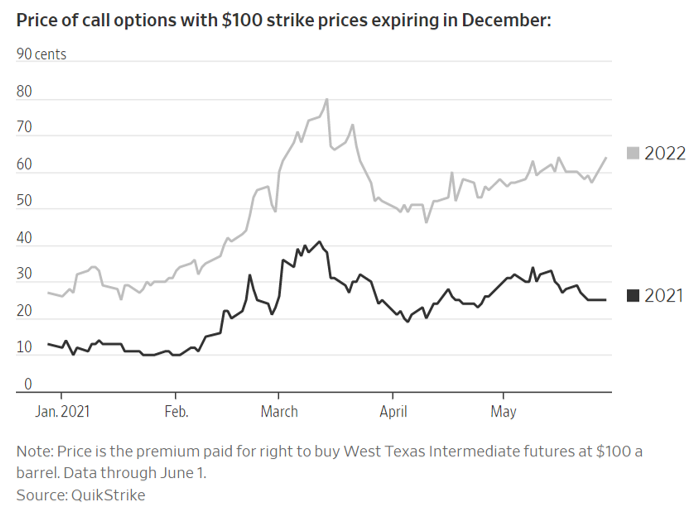
Some traders are betting $100 oil could happen this year: $100 December 2021 calls are tied to 15.9 million barrels of WTI. In London’s Brent market, $100 contracts for December 2021 covered more than 32 million barrels last week, up from none at the end of last year, according to Intercontinental Exchange.
Even some of those buying the options don’t expect oil prices to hit $100 but think they will profit regardless. Traders say the contracts, dubbed lottery tickets, will likely appreciate if oil prices keep rising or if participants expect crude markets to grow more volatile.
Buyers are betting on higher volatility more than they are placing a wager on higher oil prices, said Robert Yawger, director of energy futures at Mizuho Securities USA. Volatility and options are intrinsically linked, so all else being equal, that would boost the price of the contracts.


